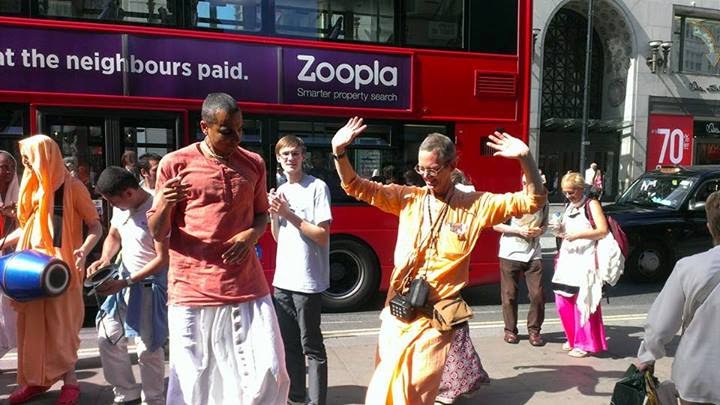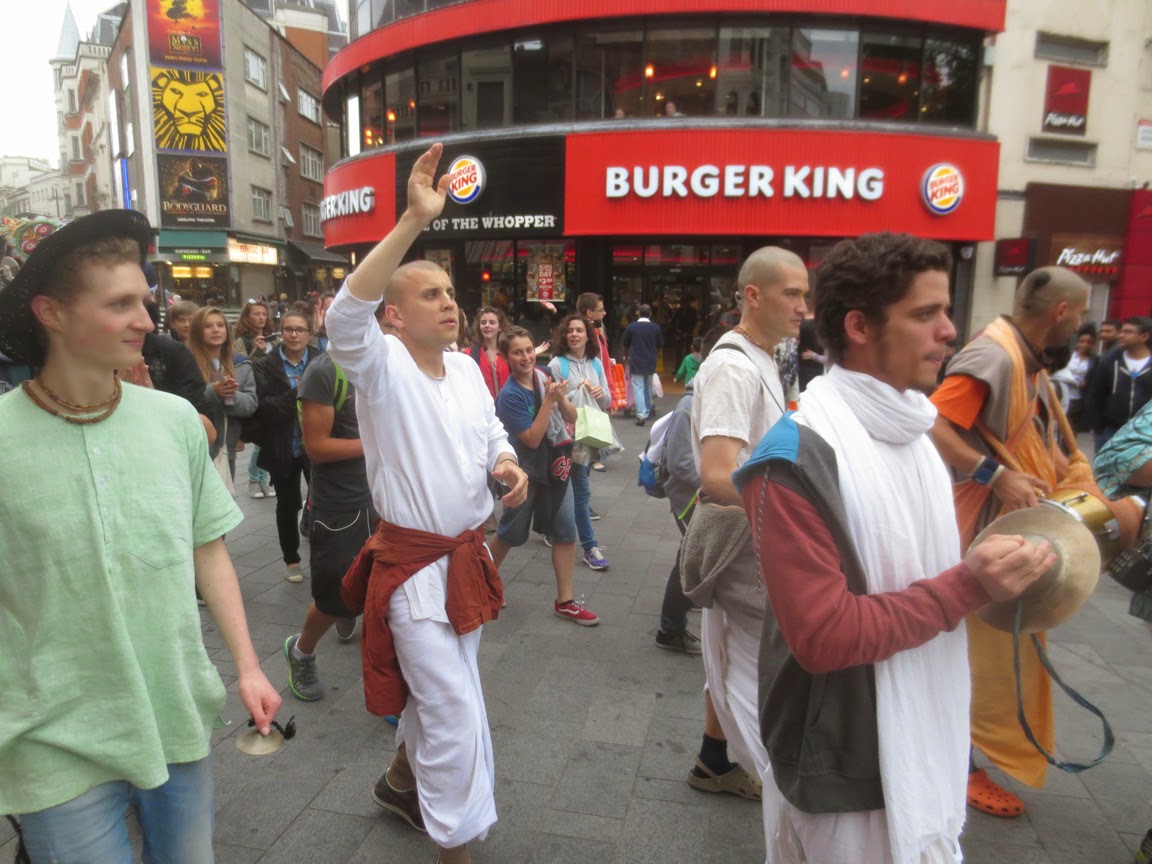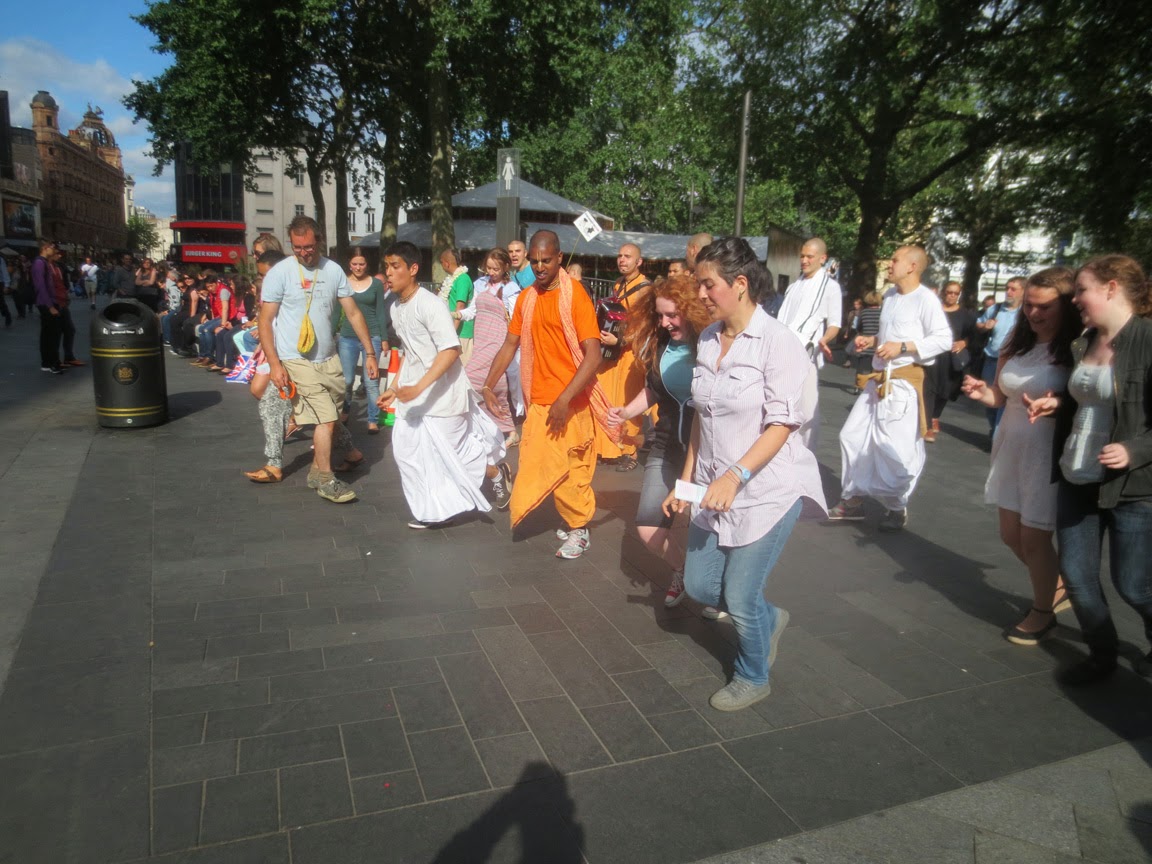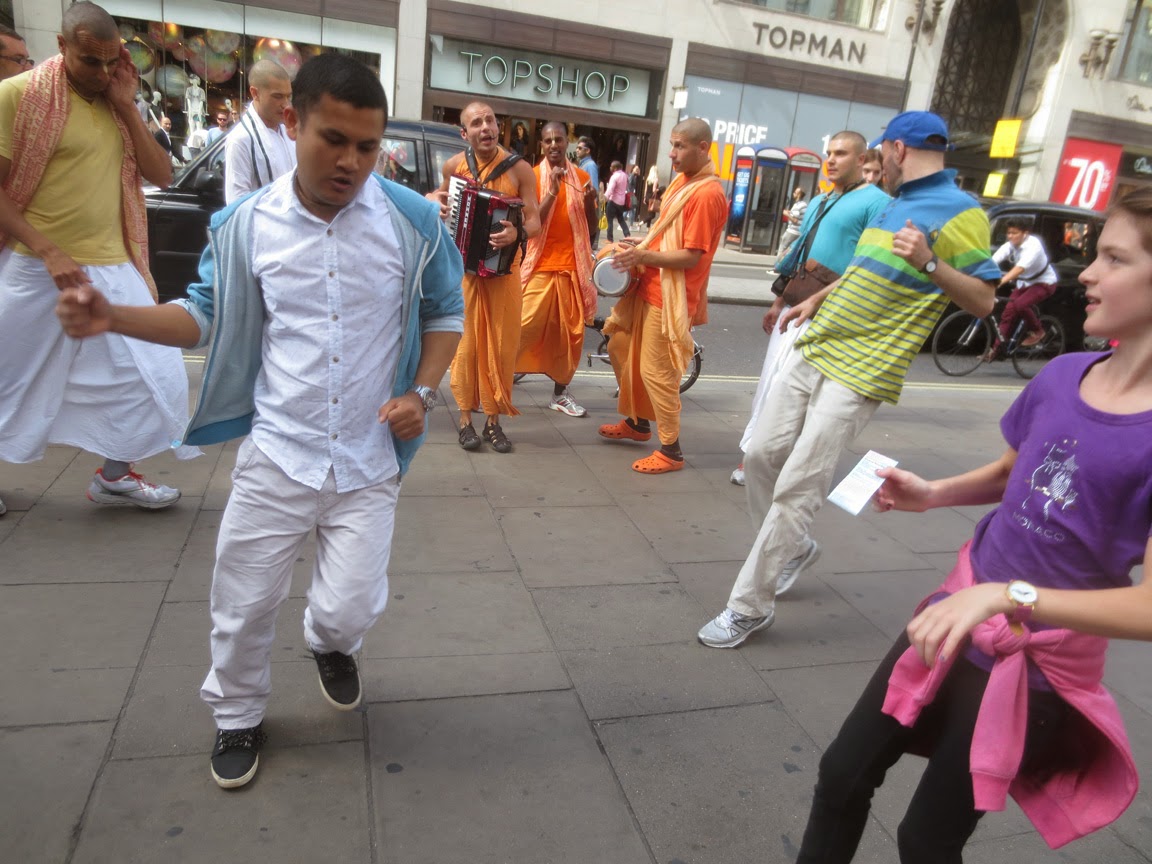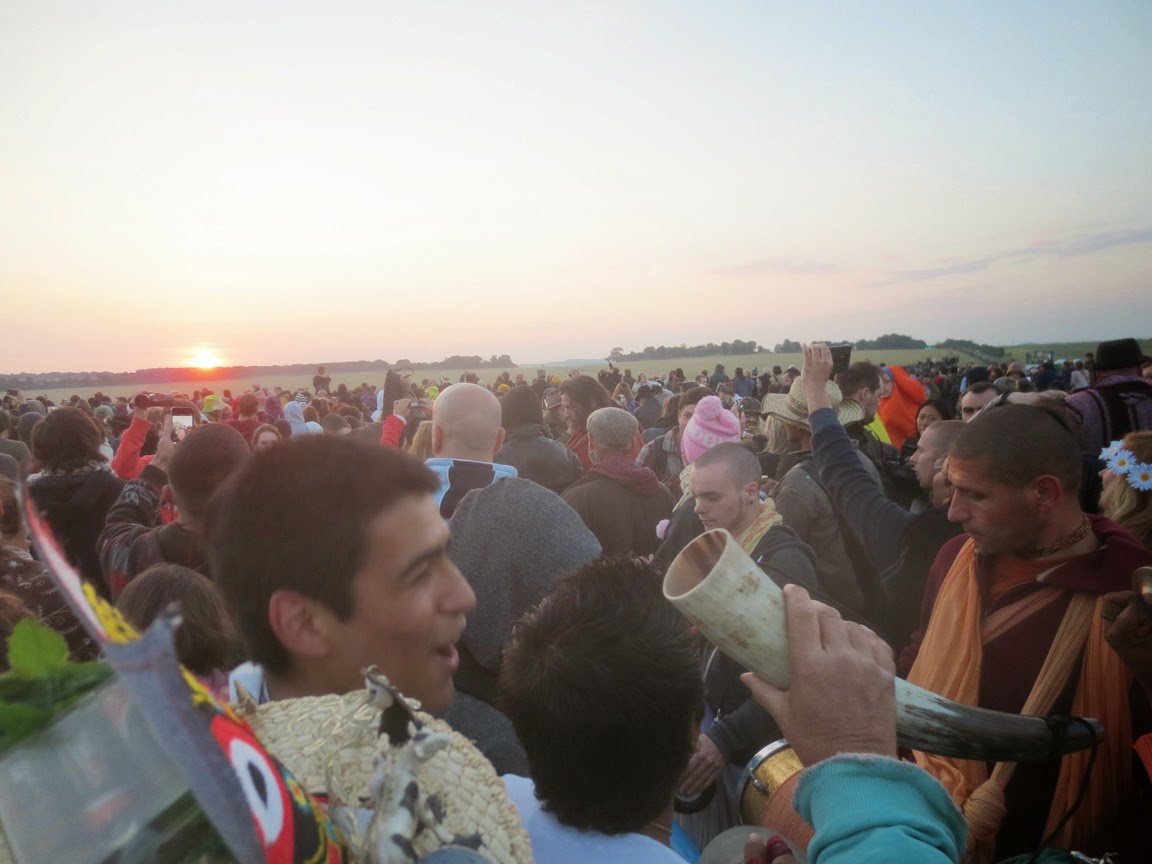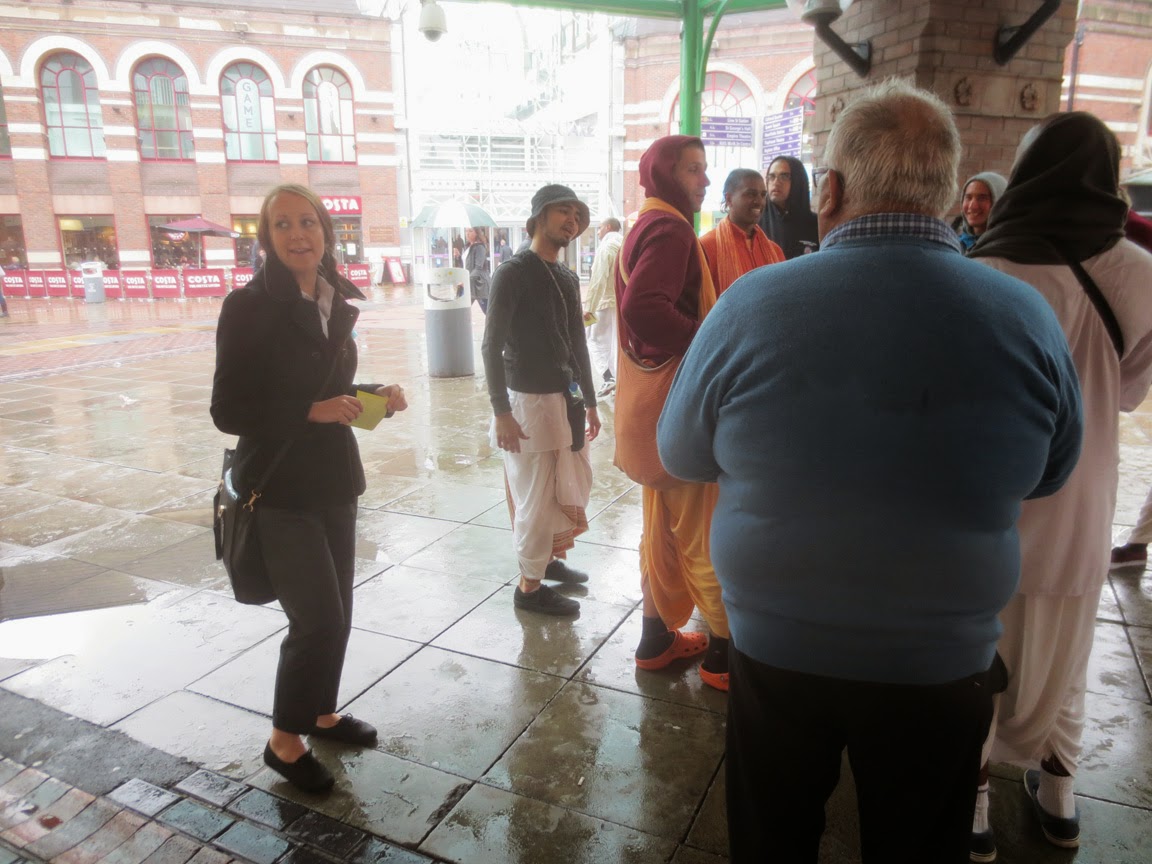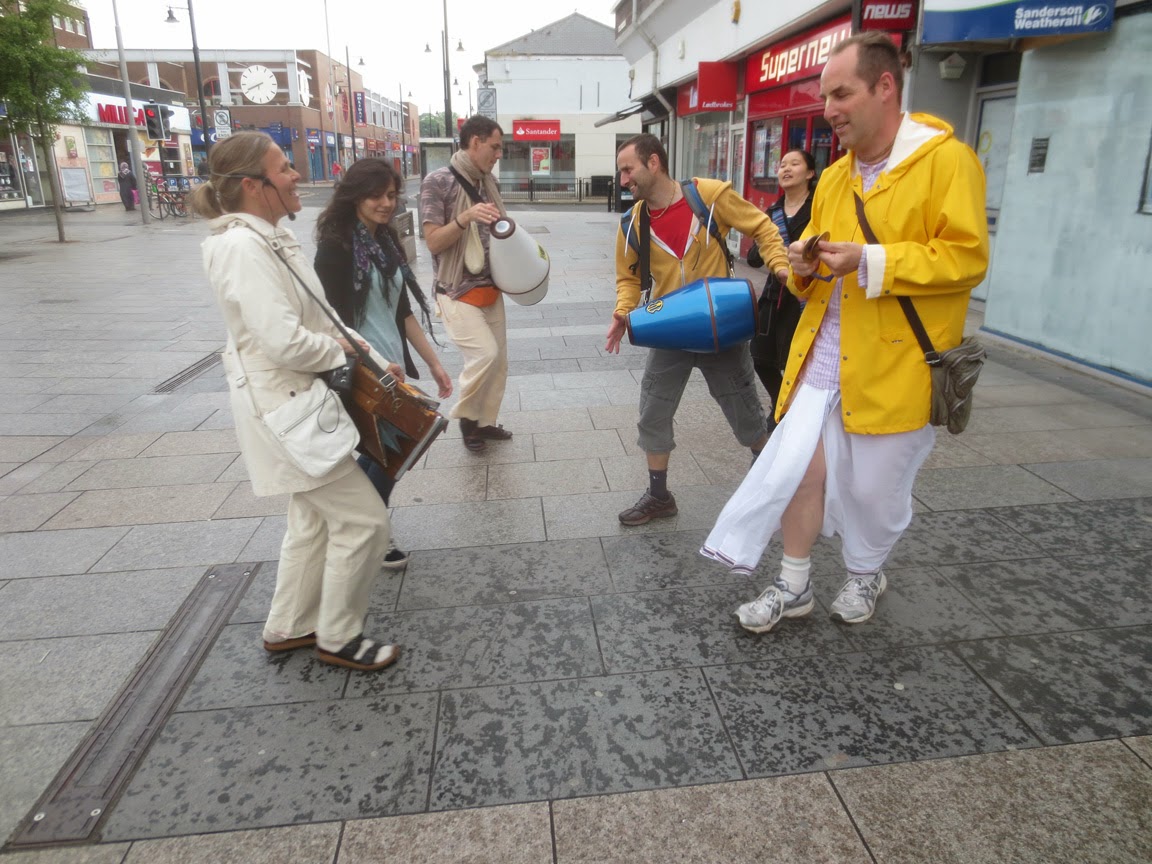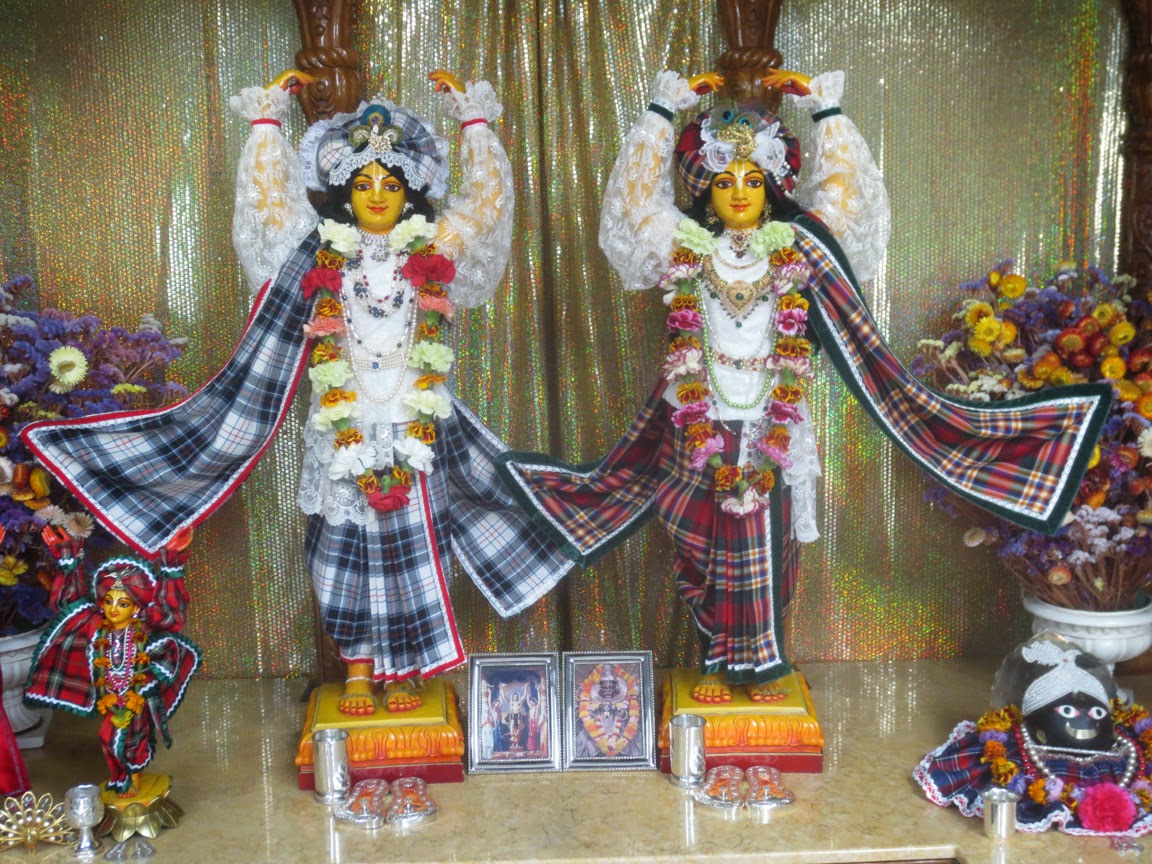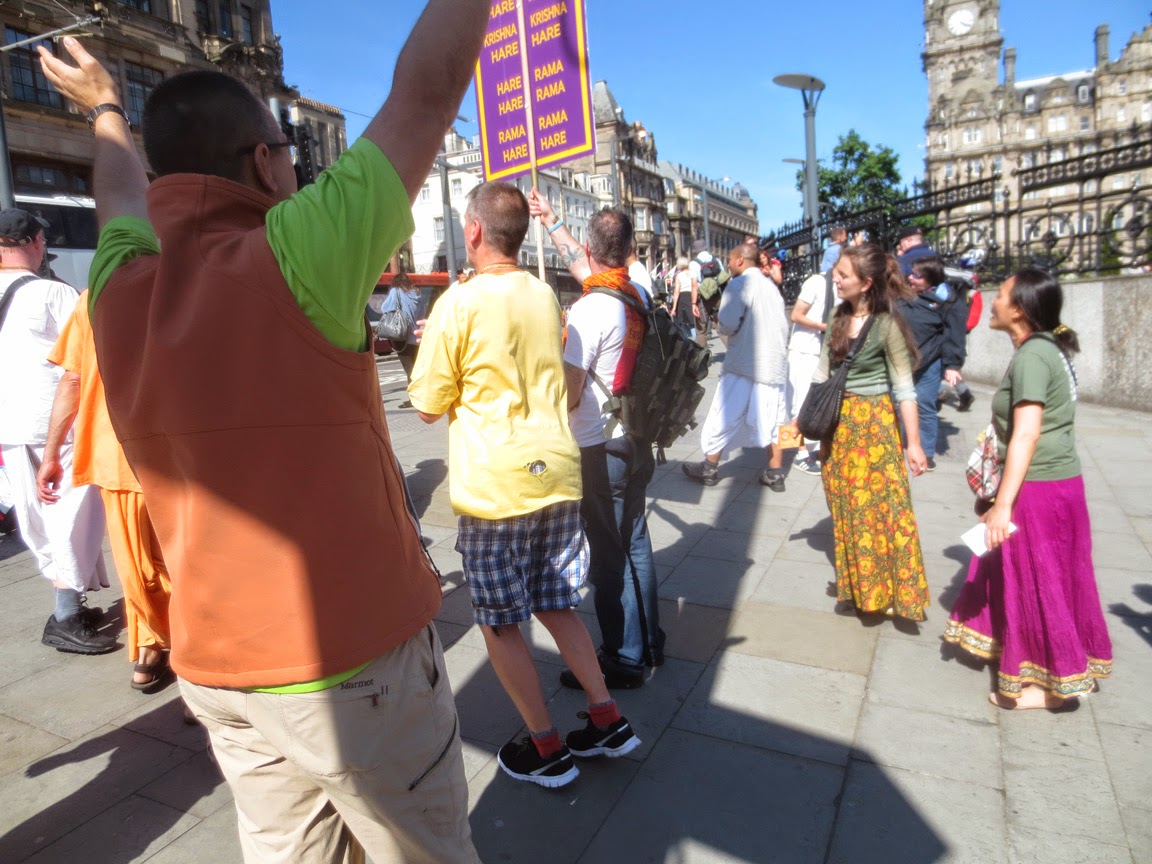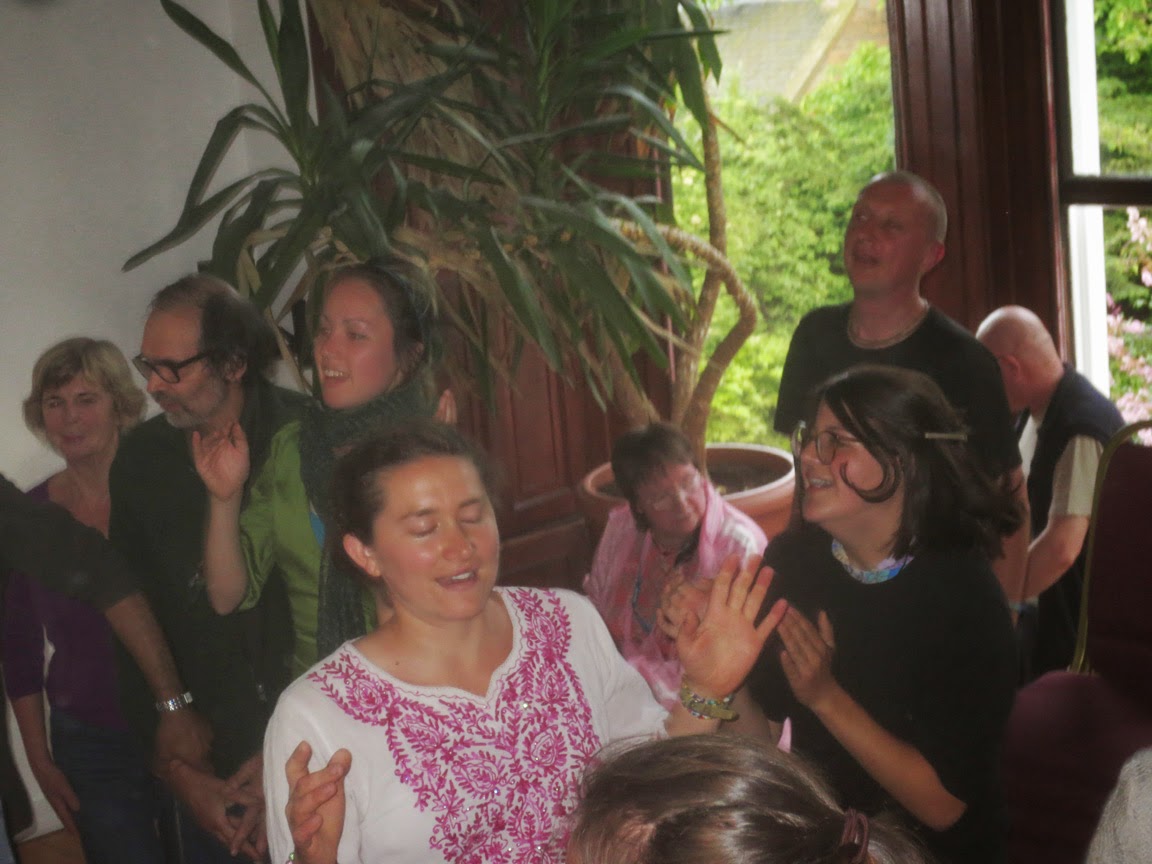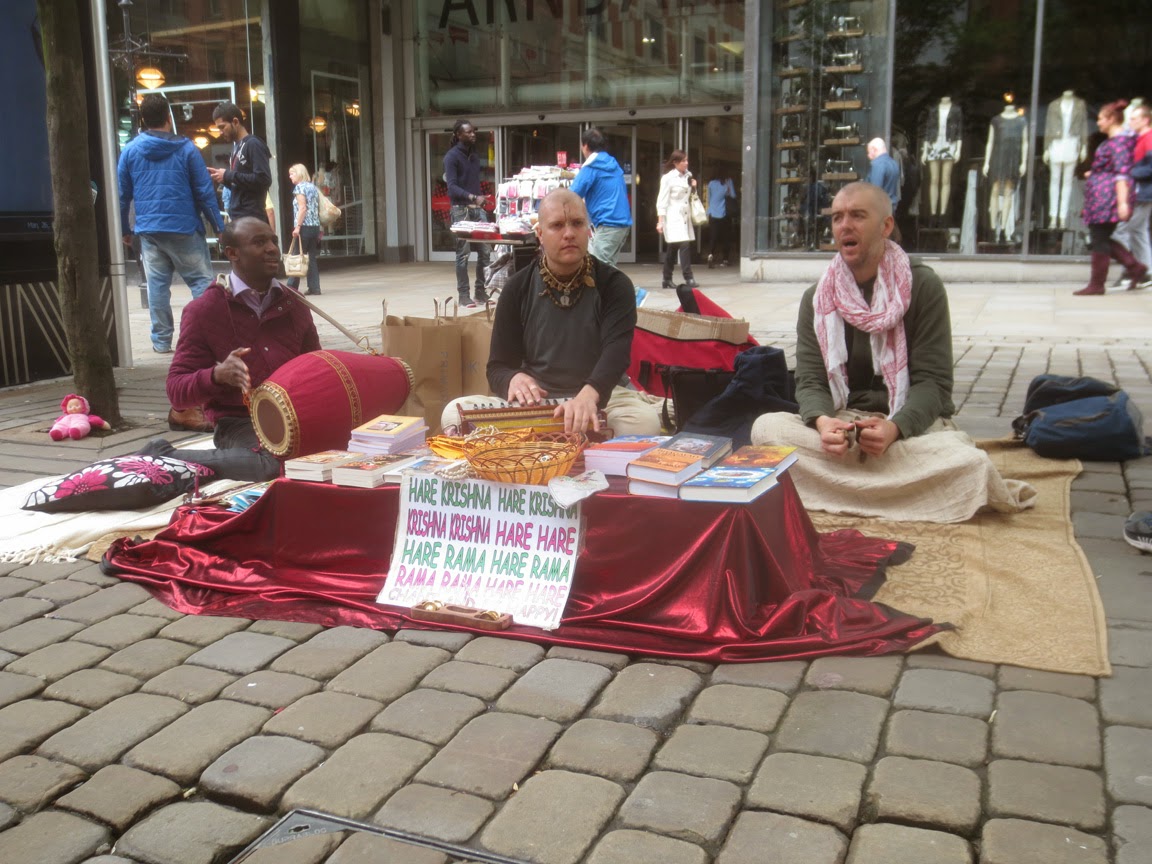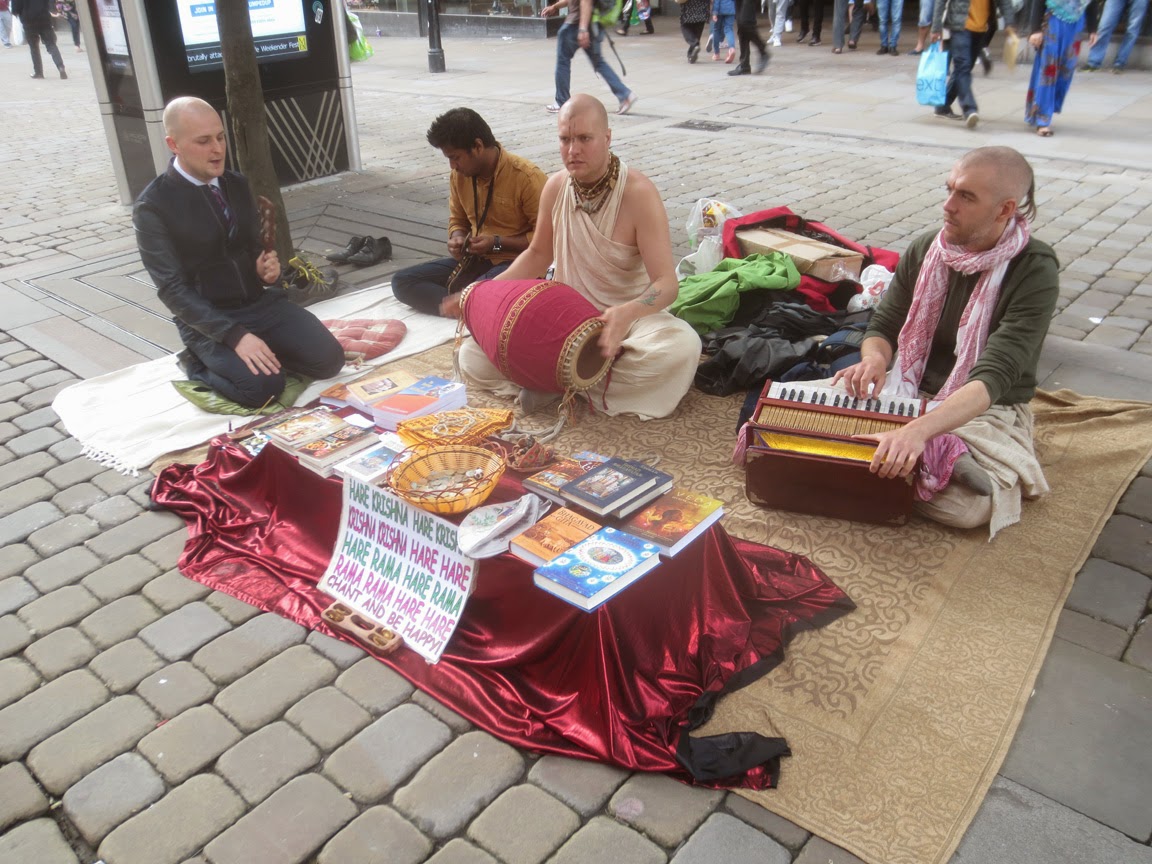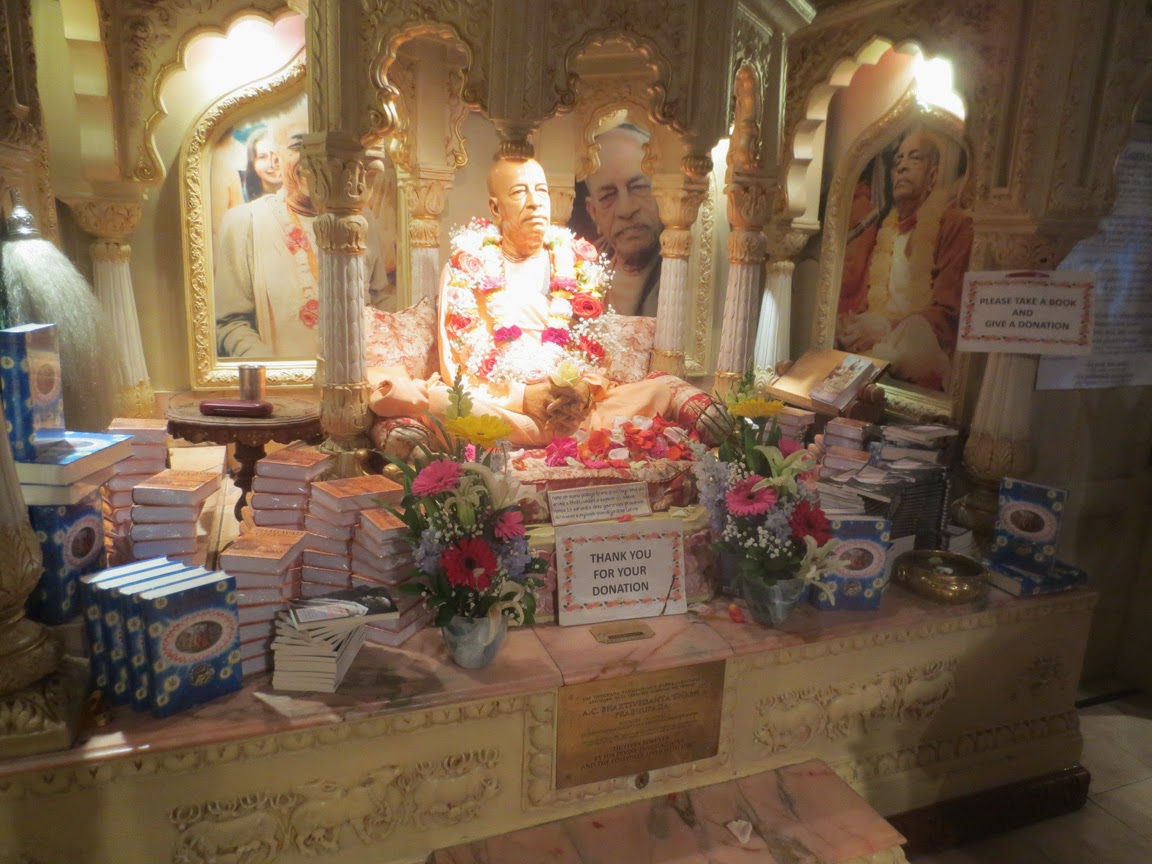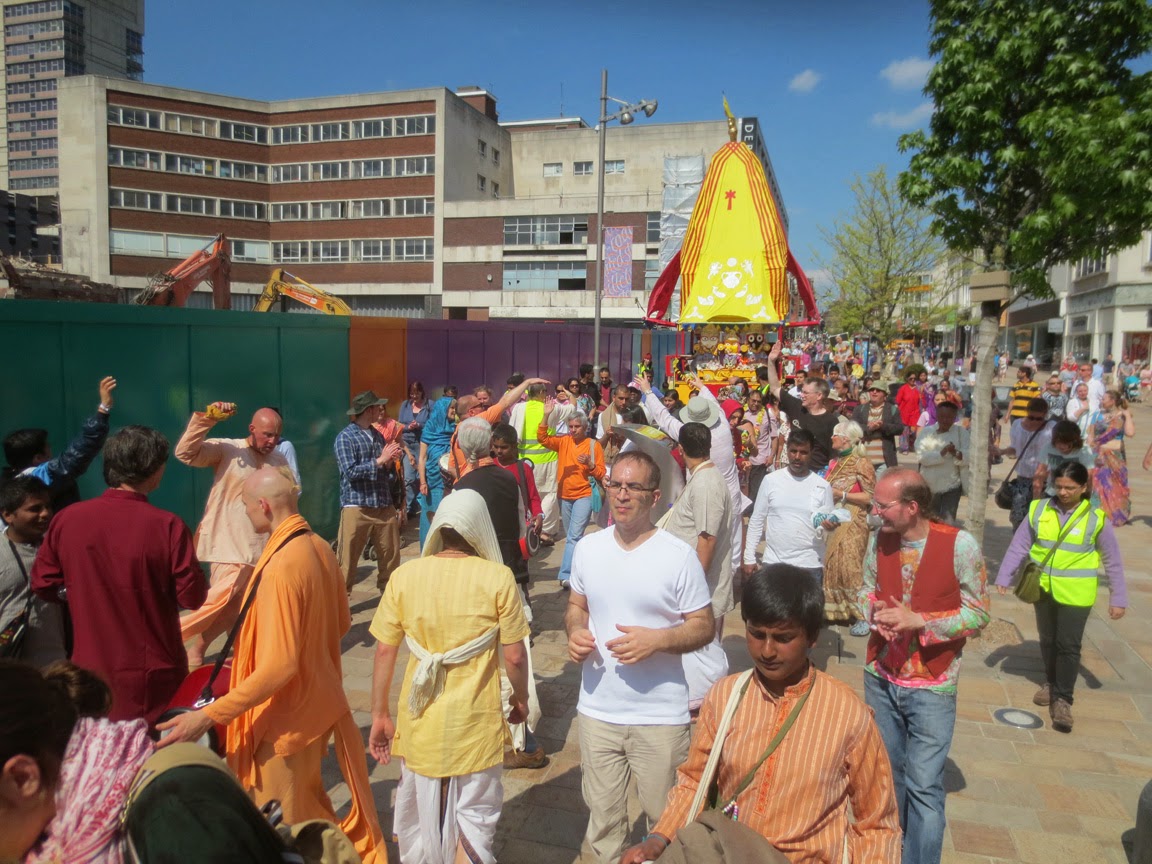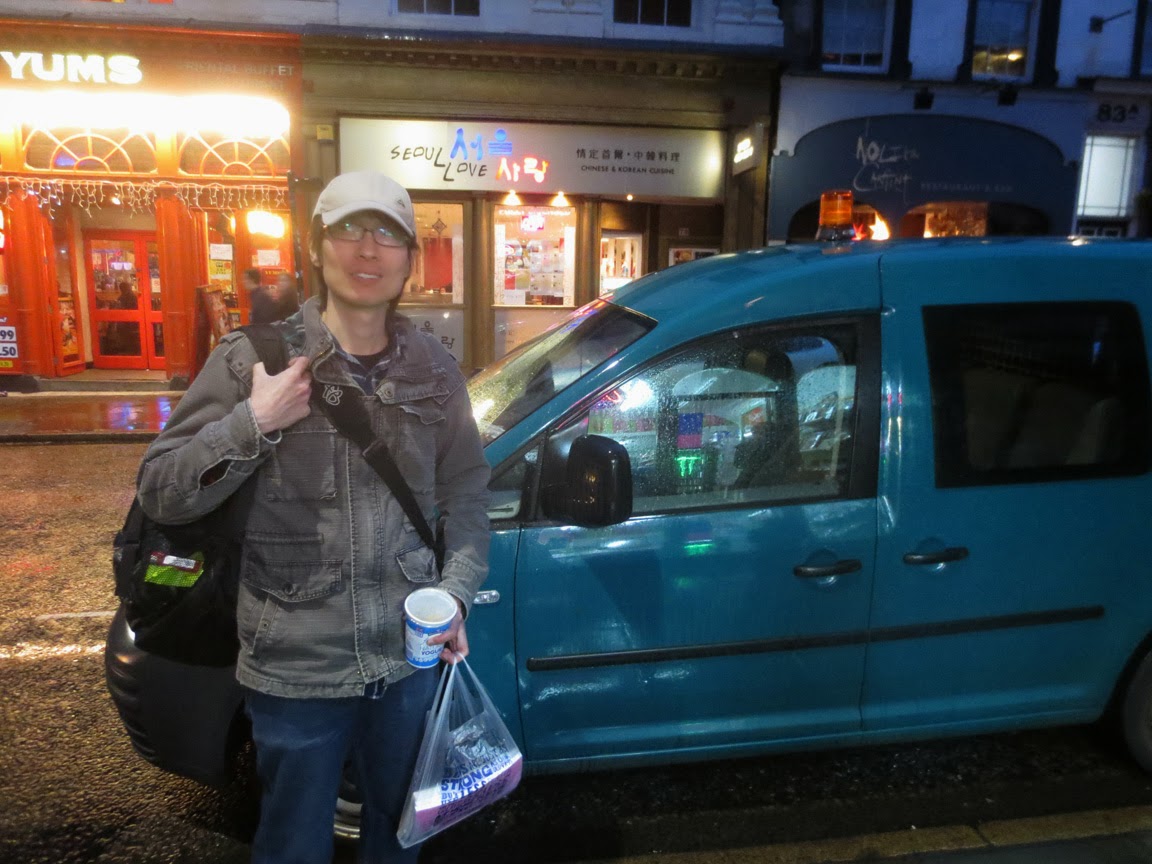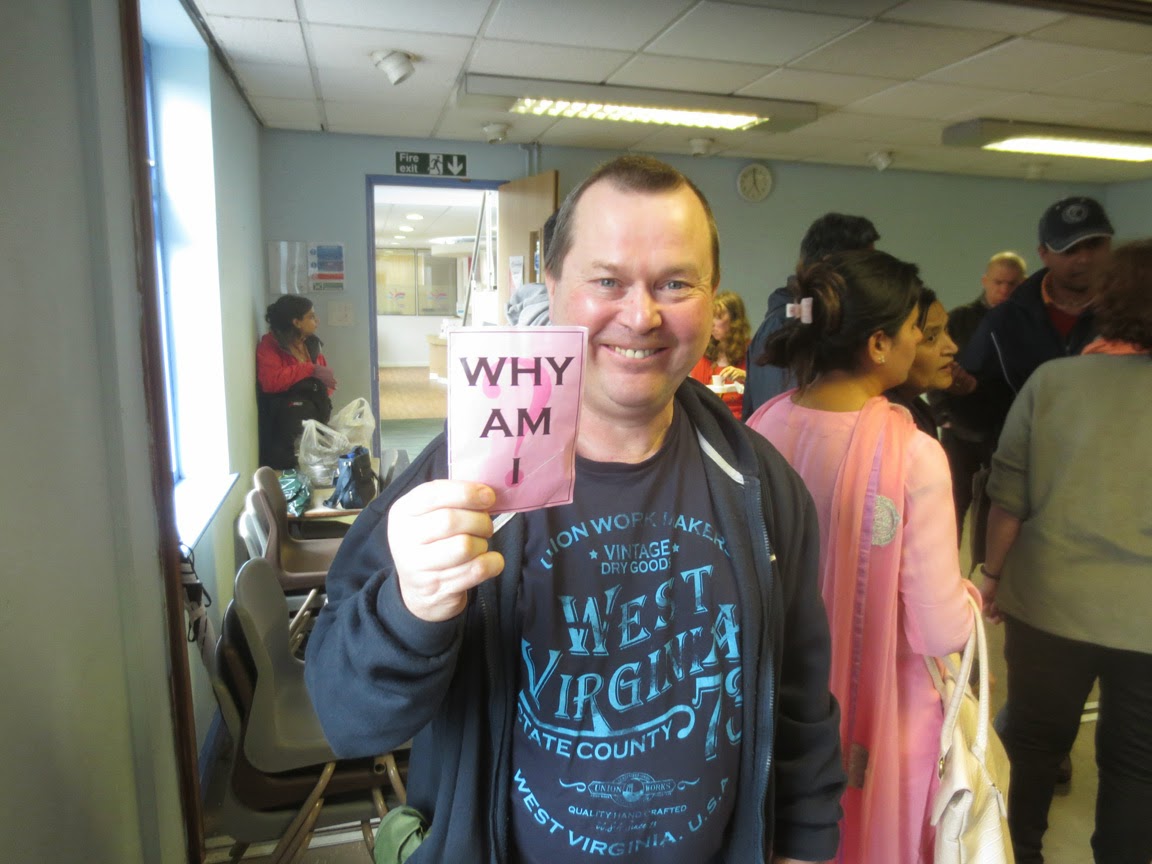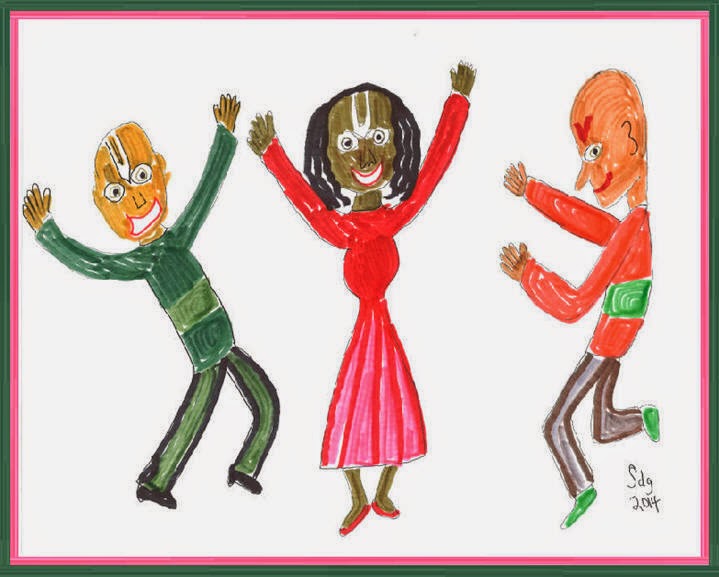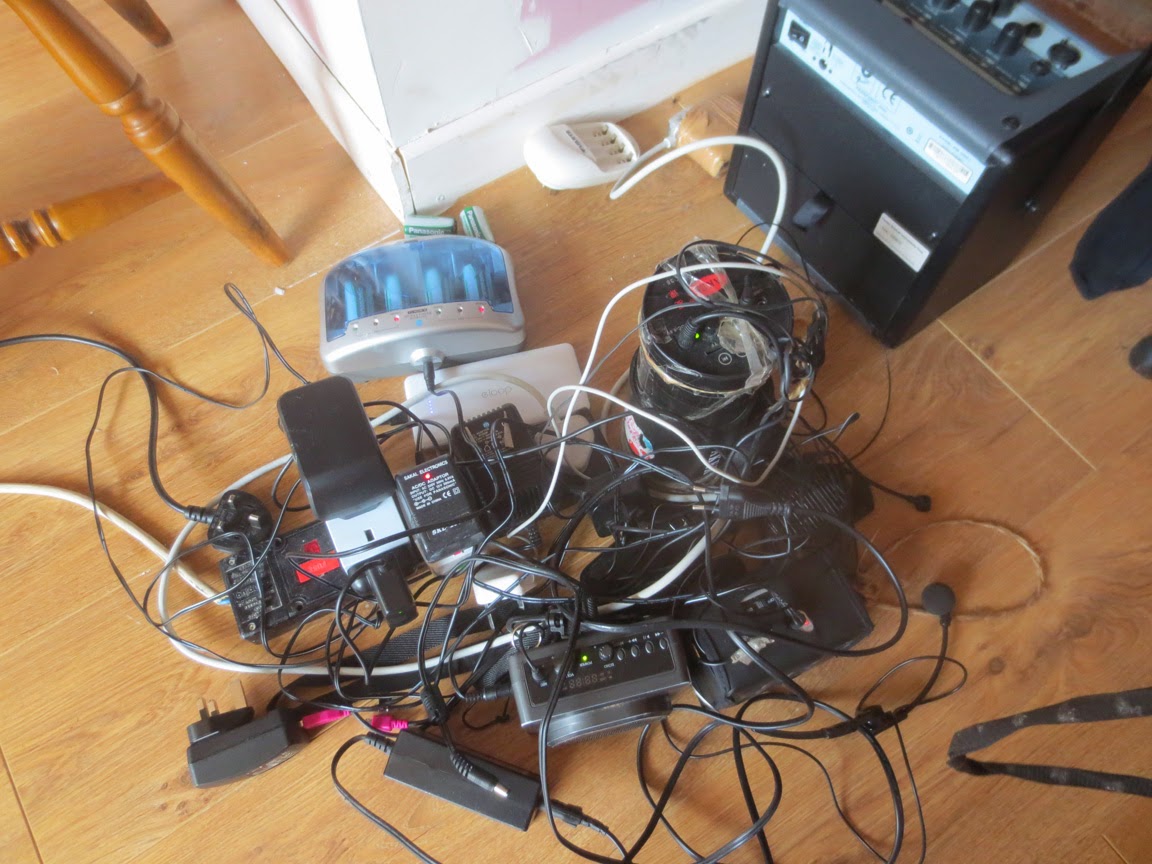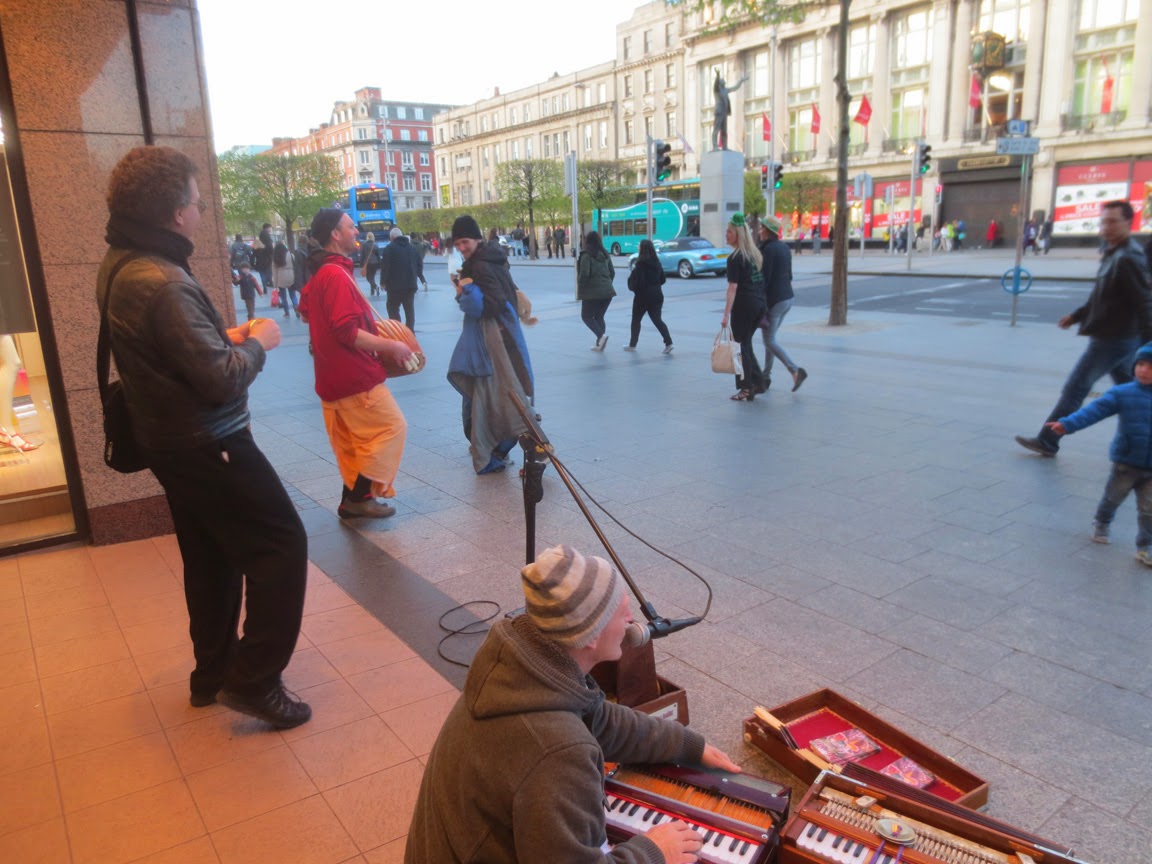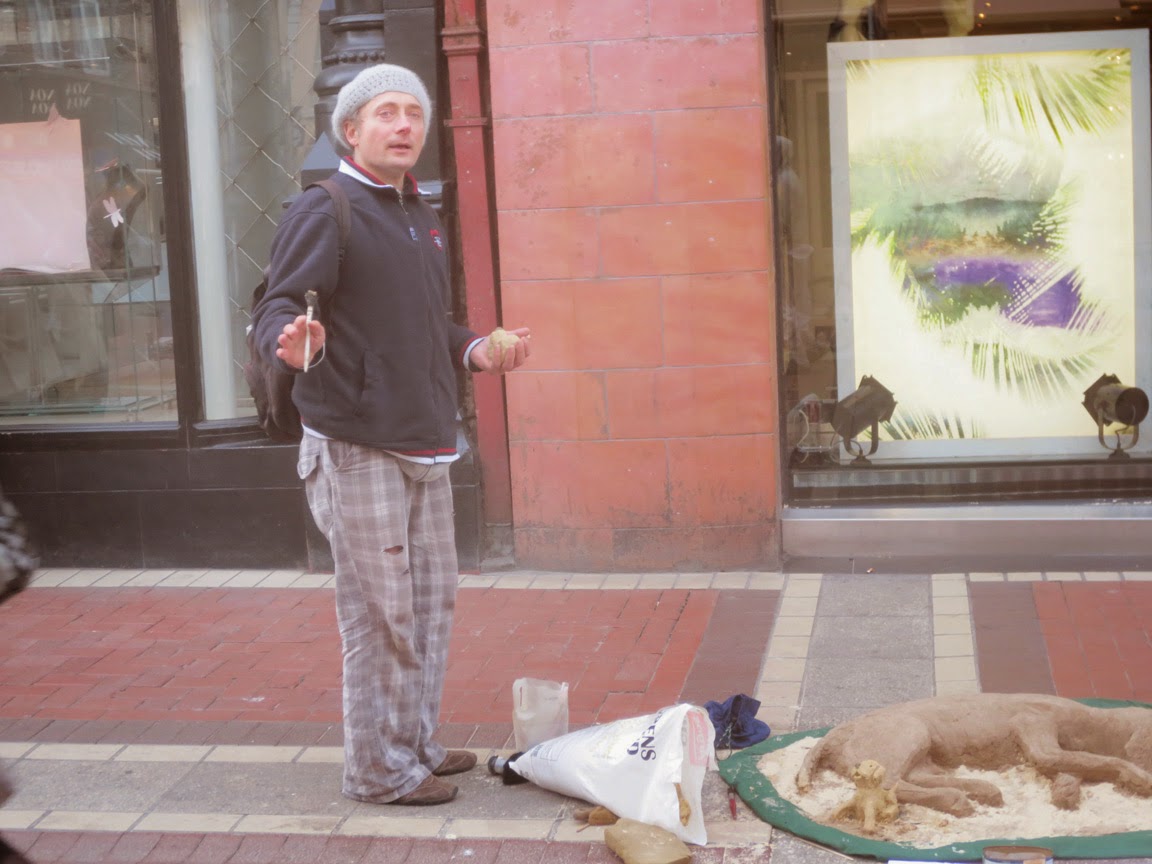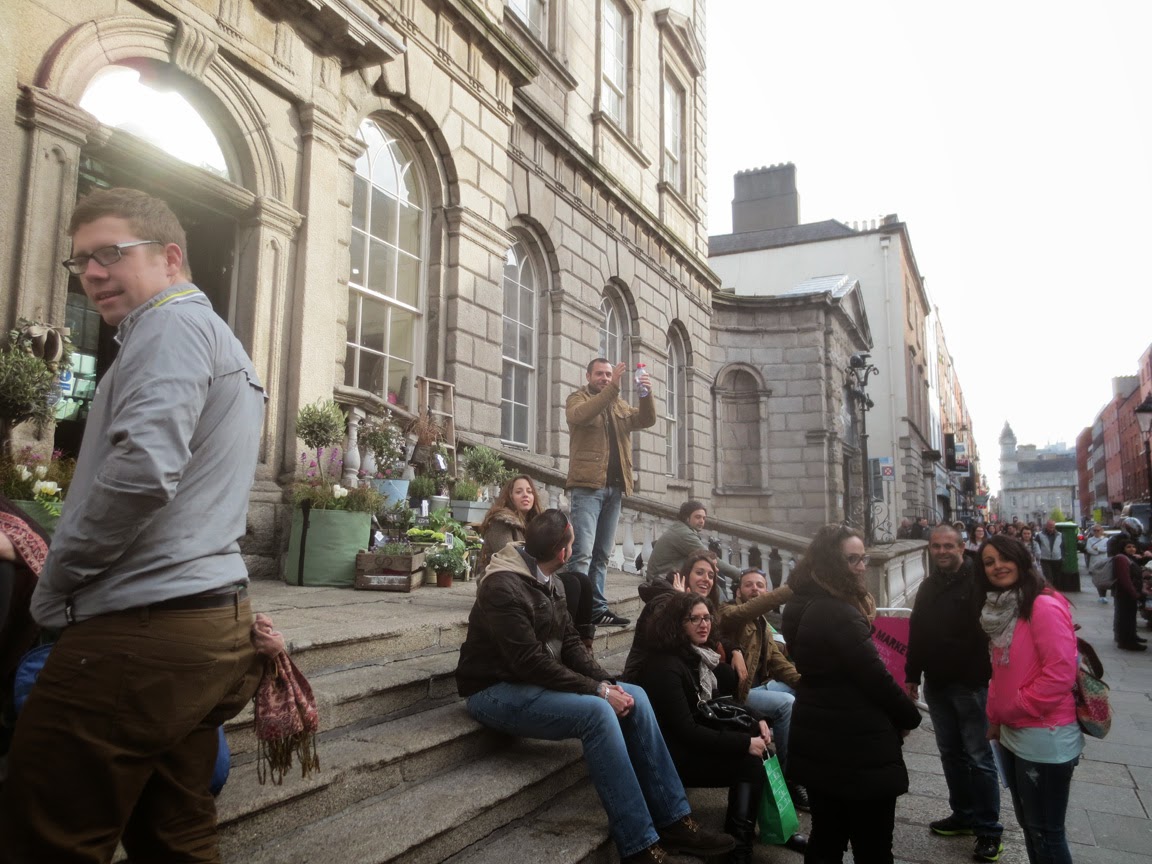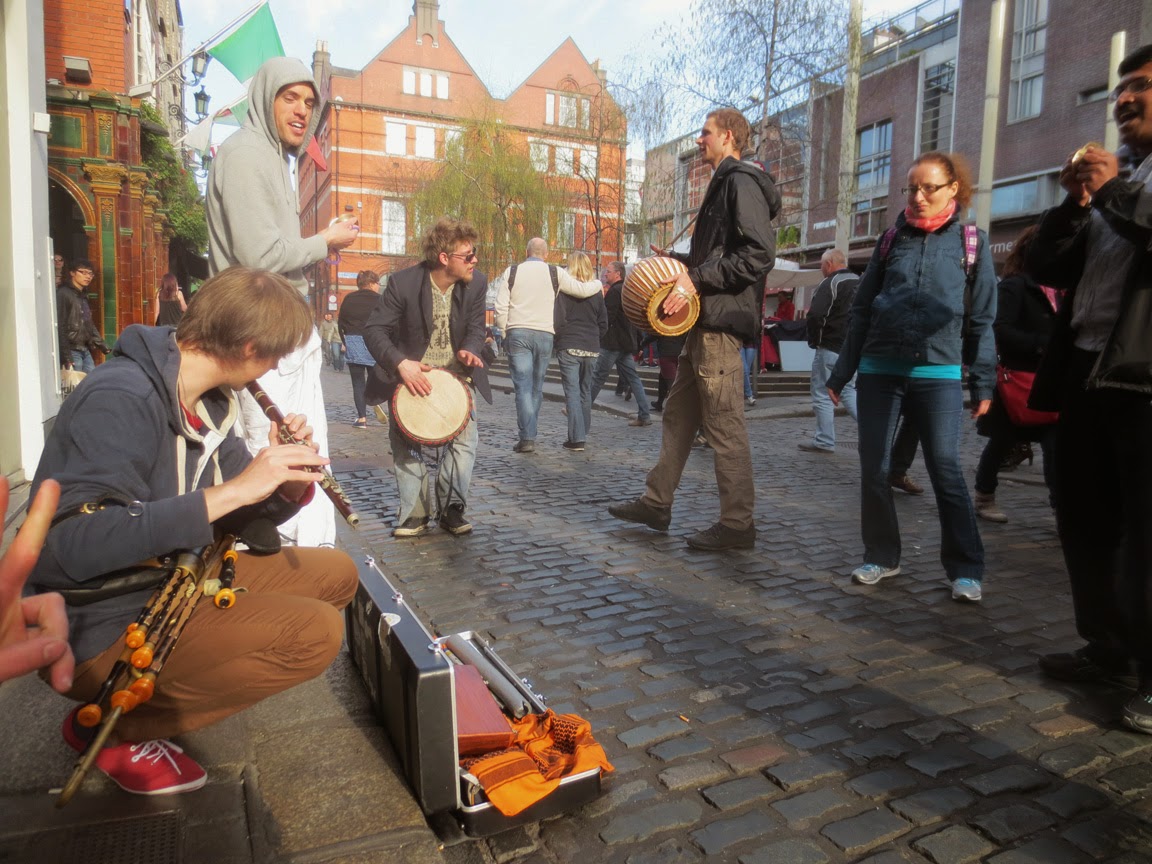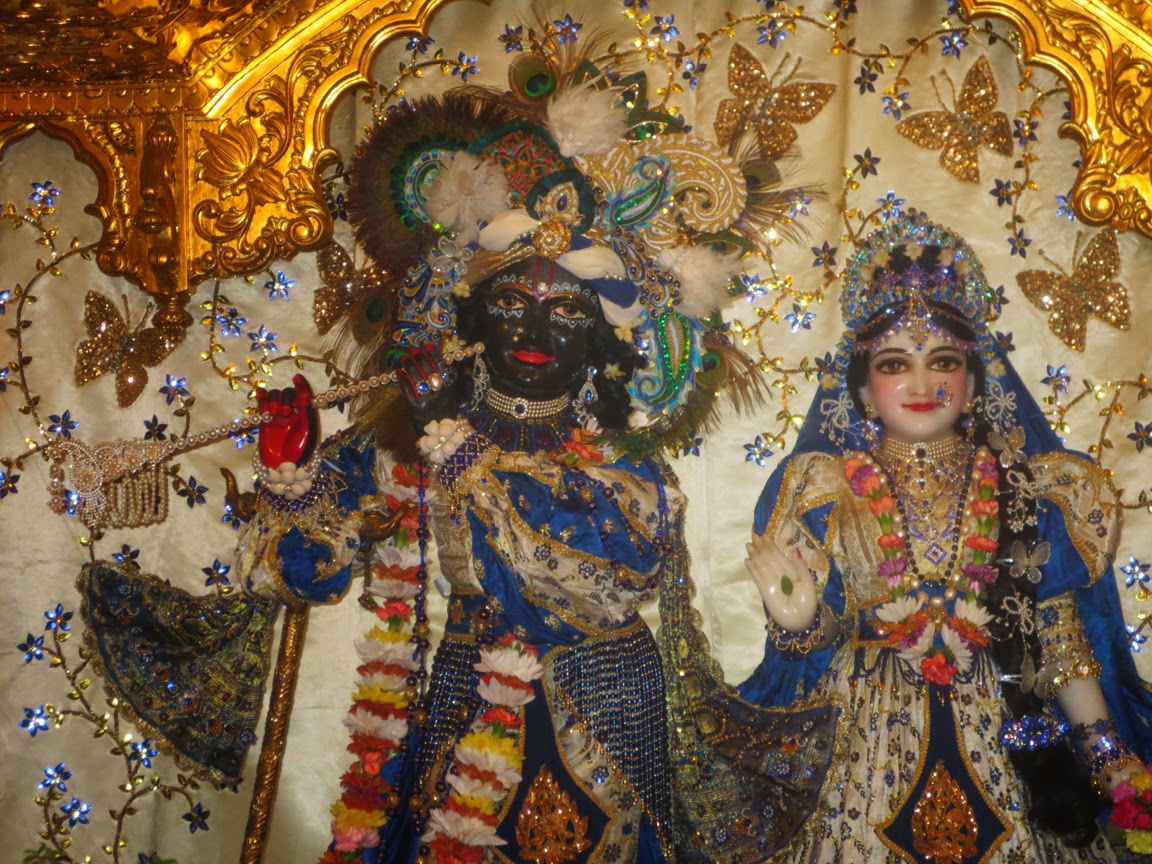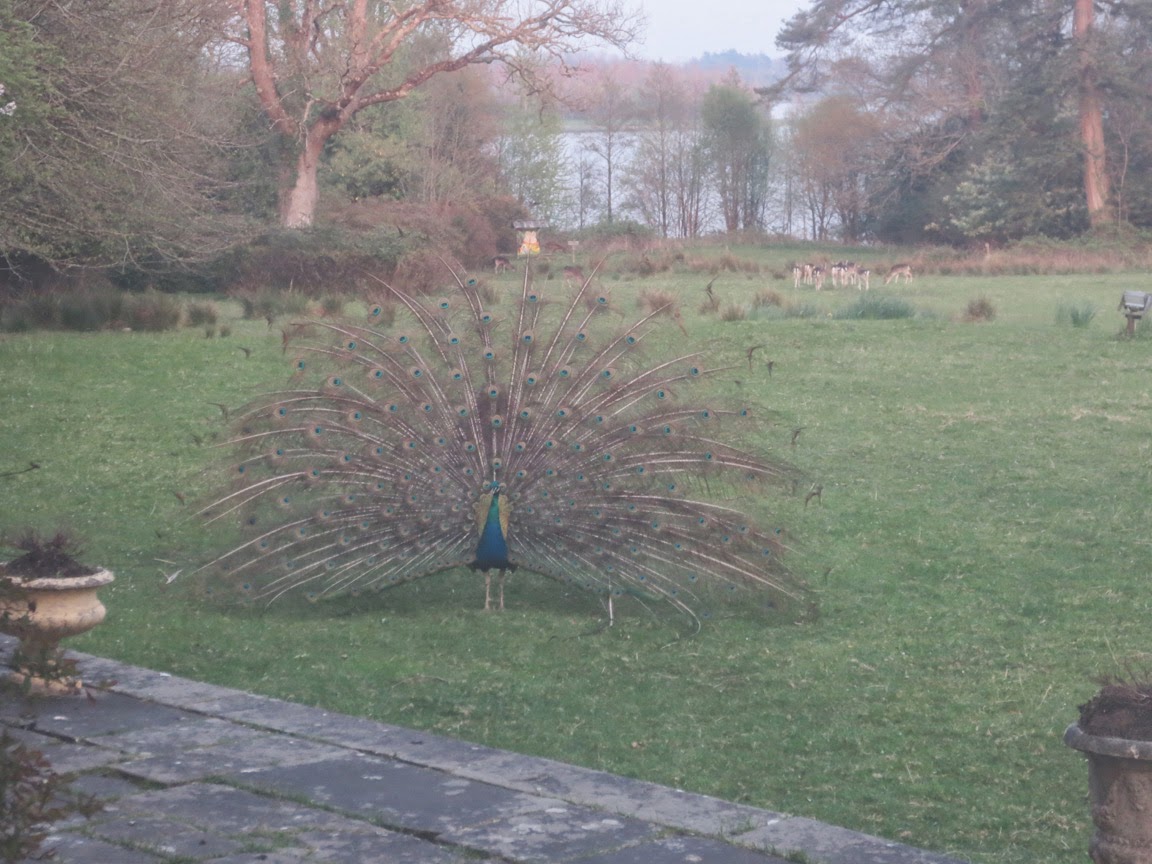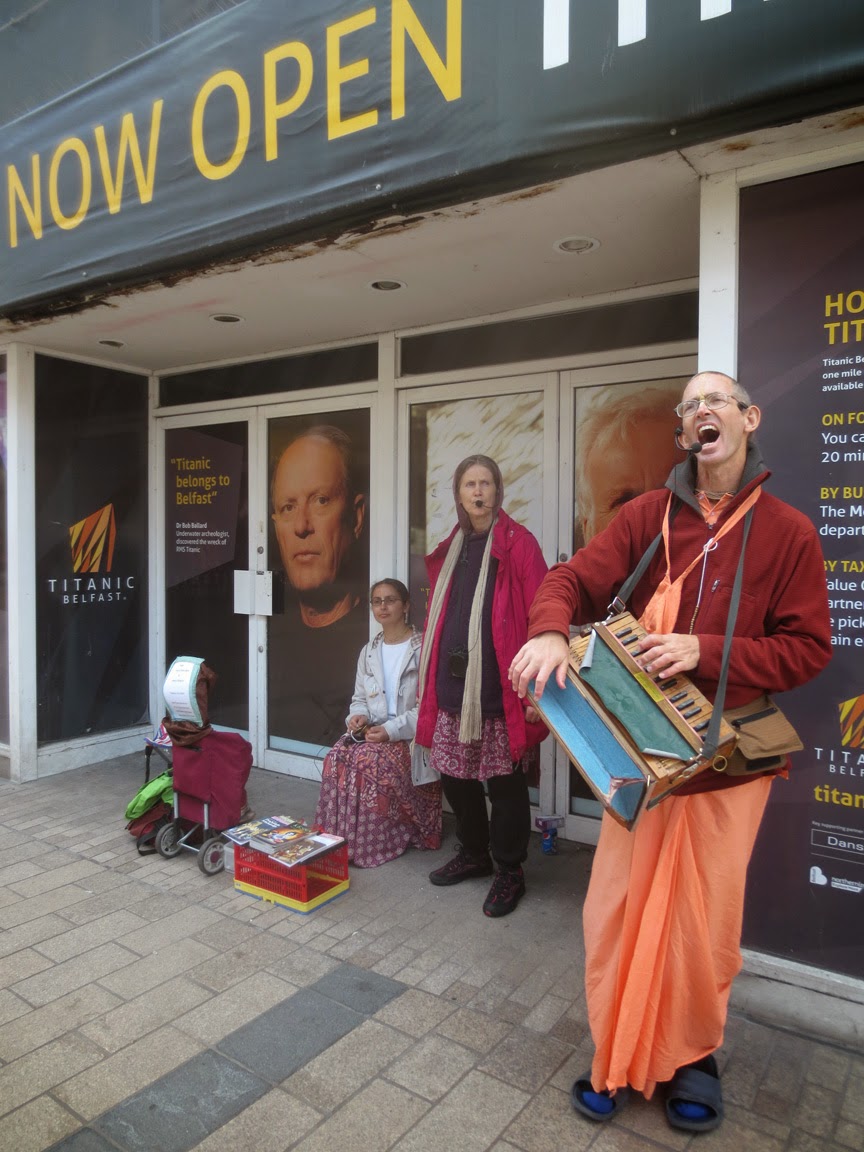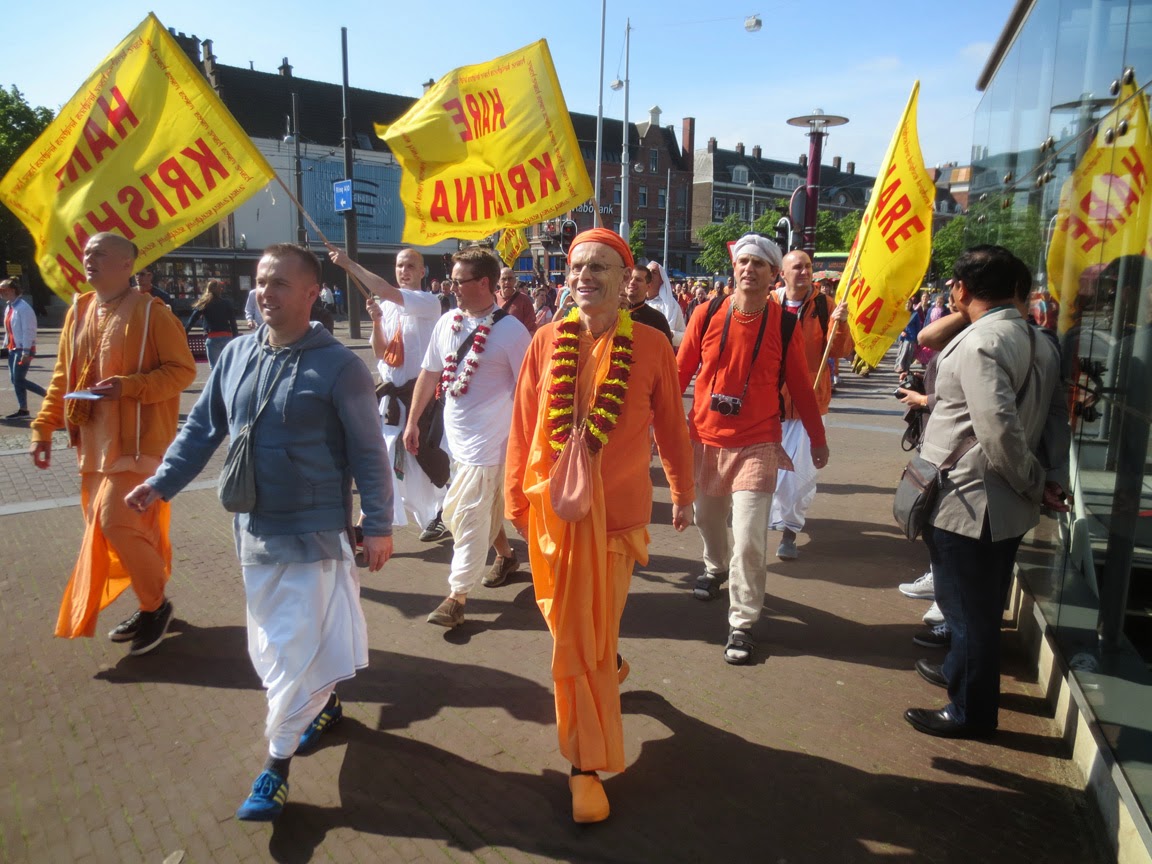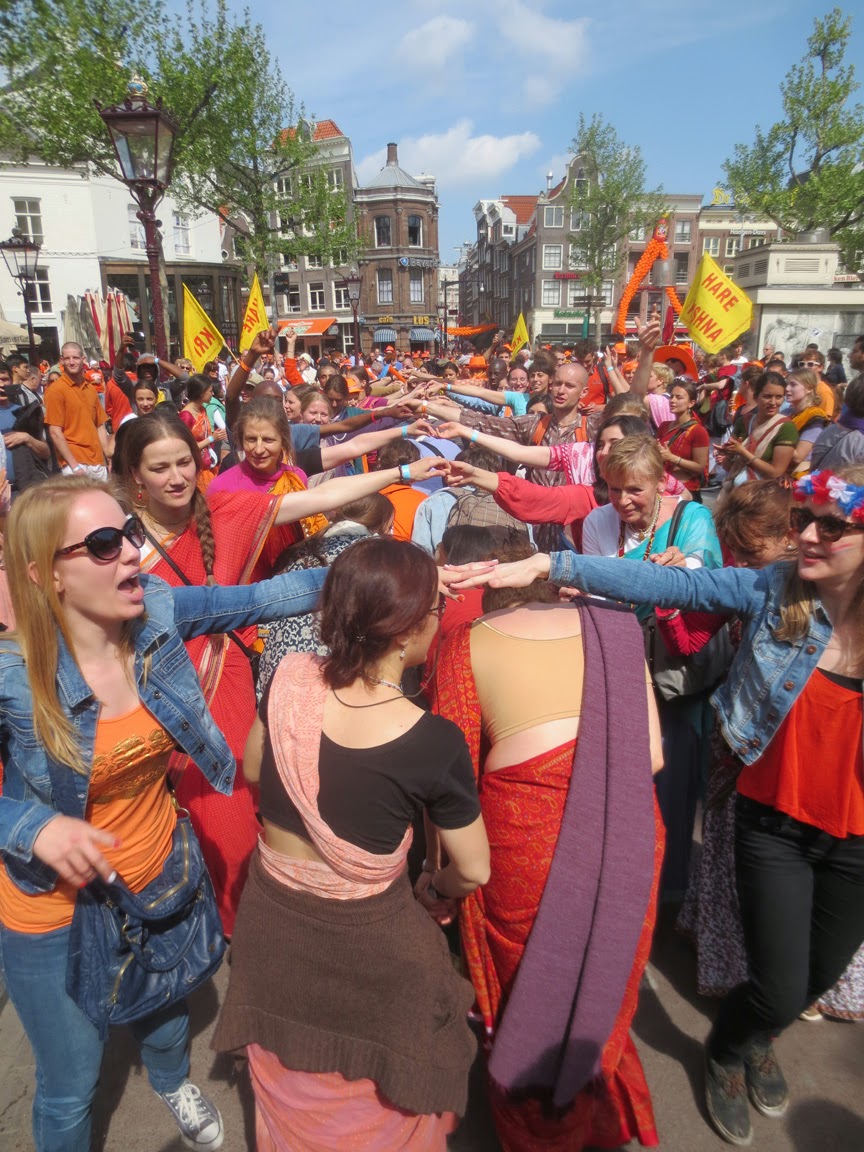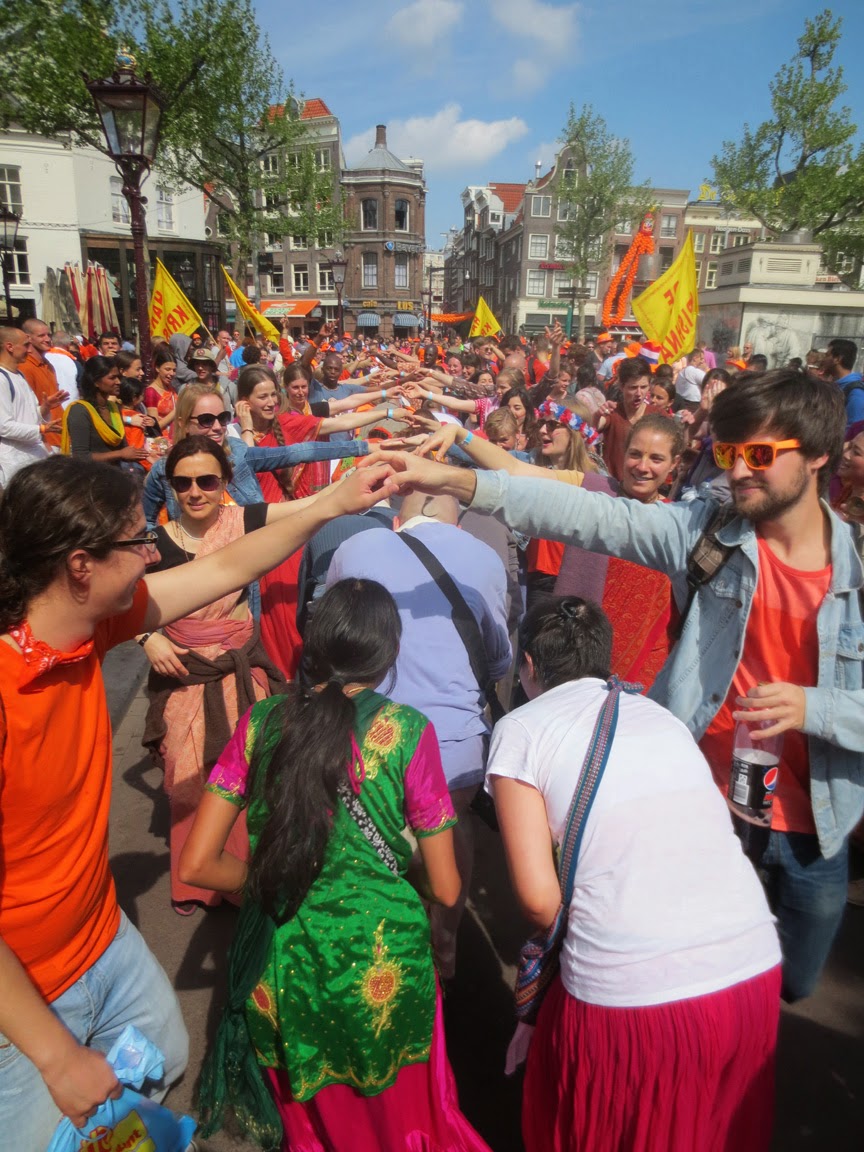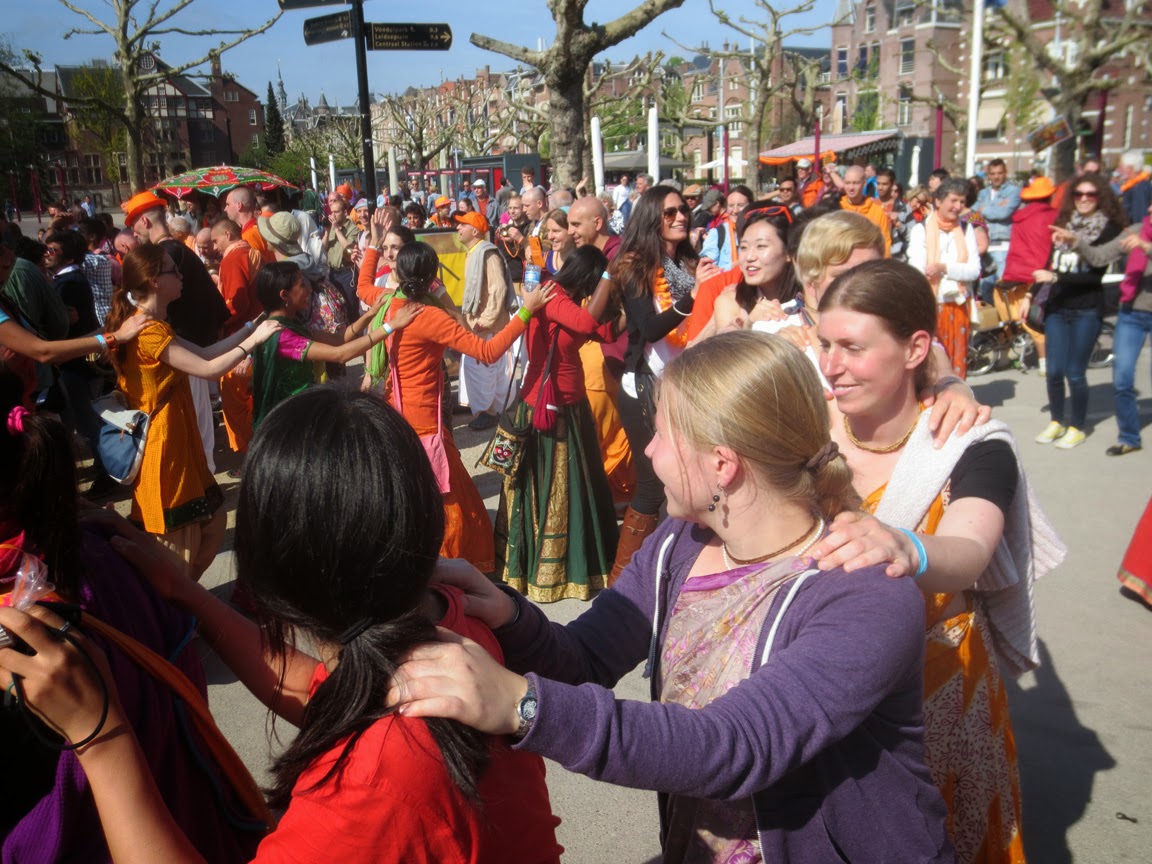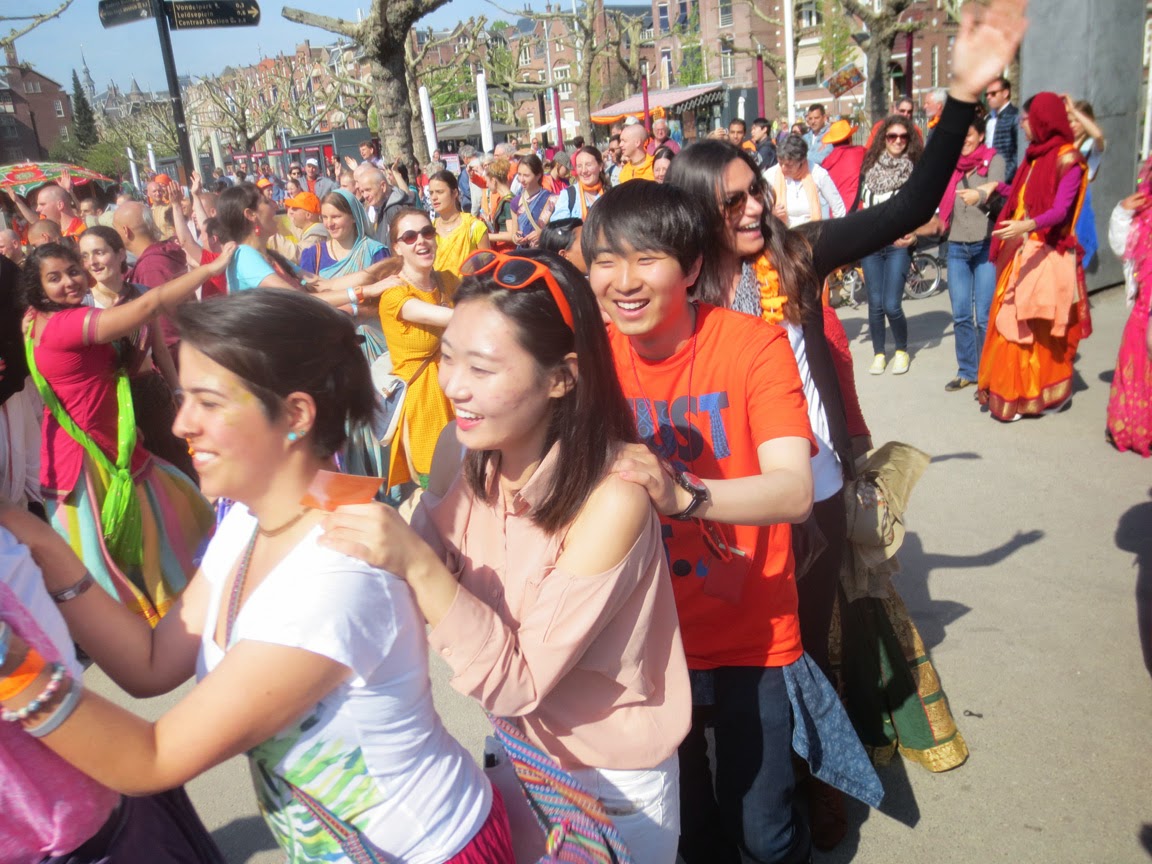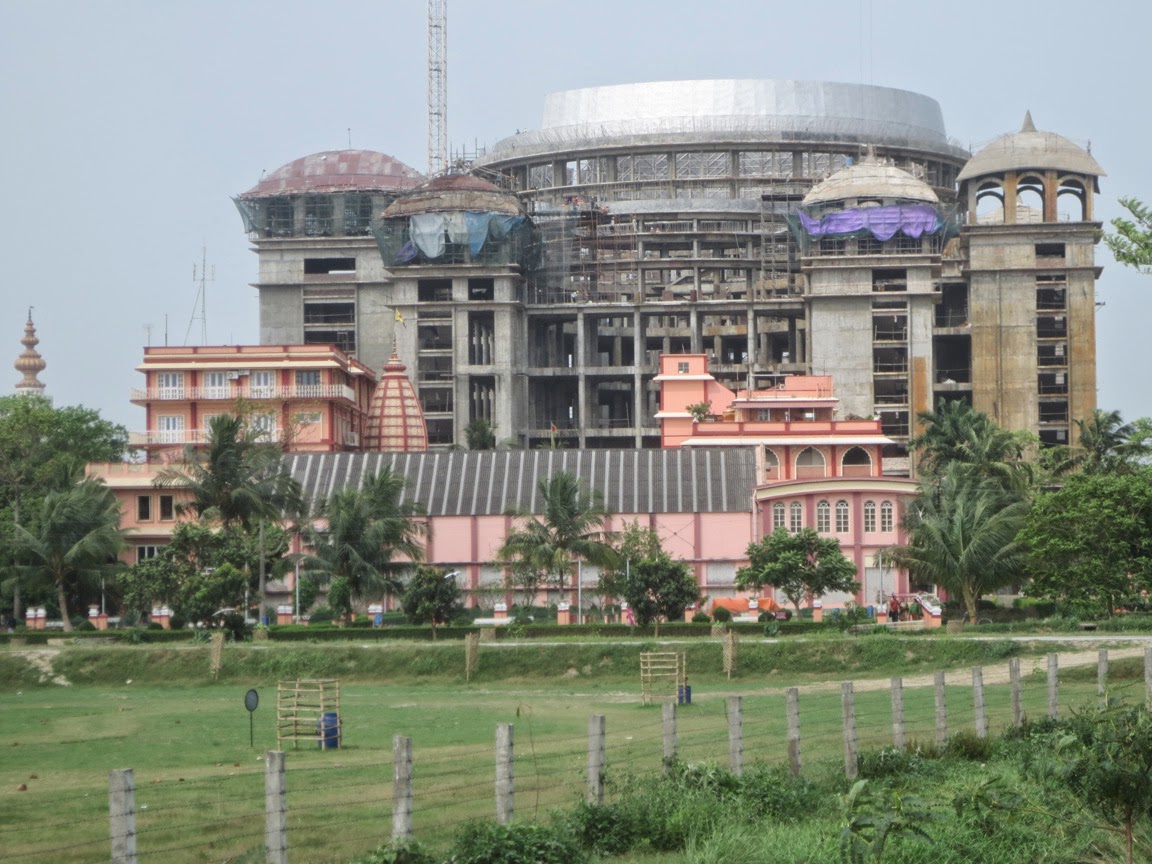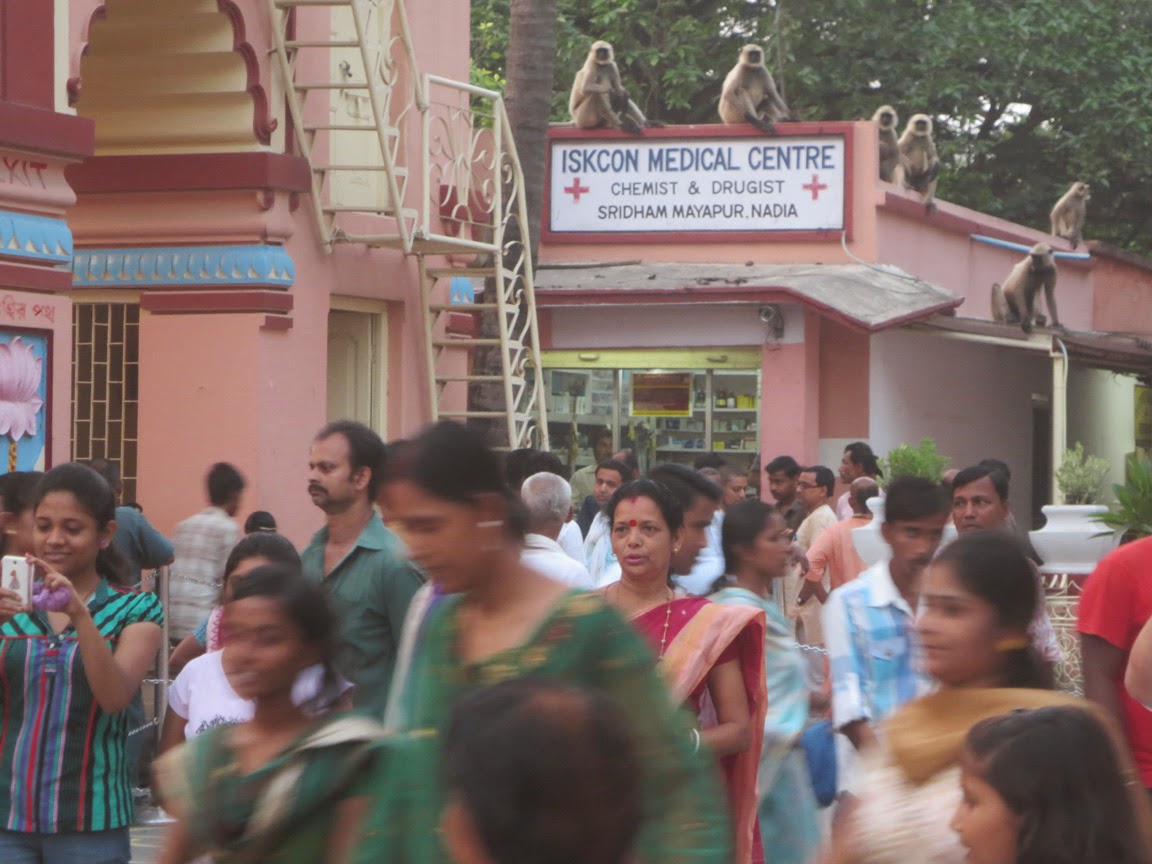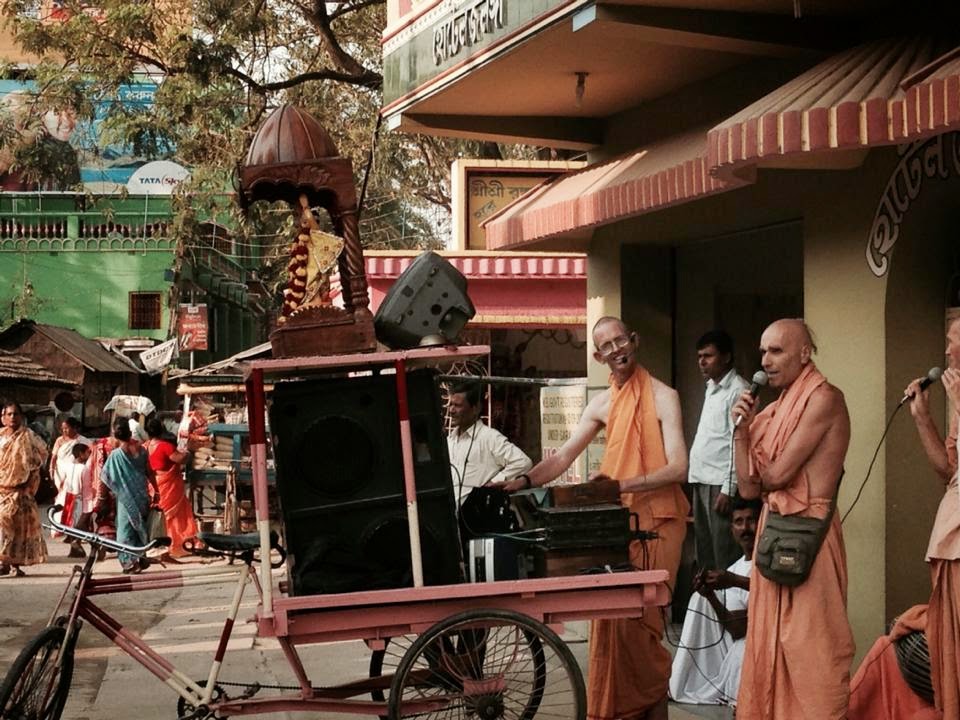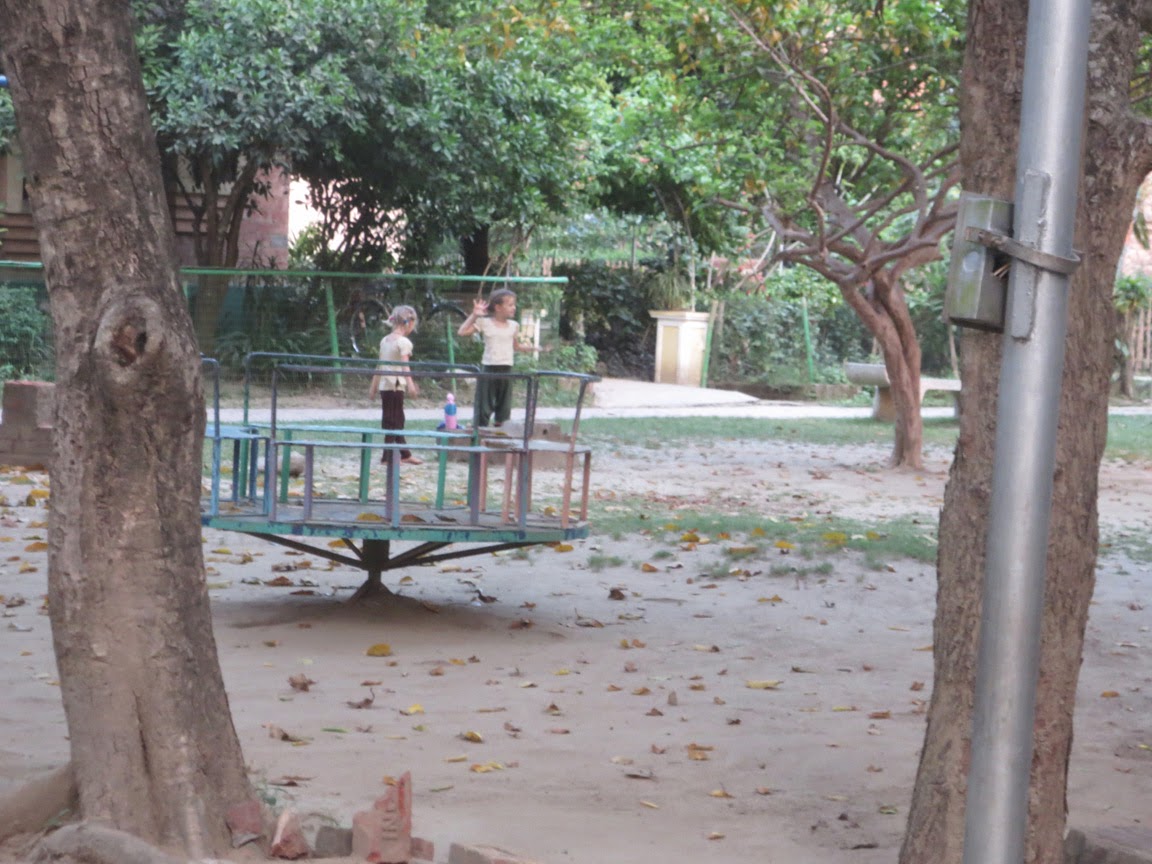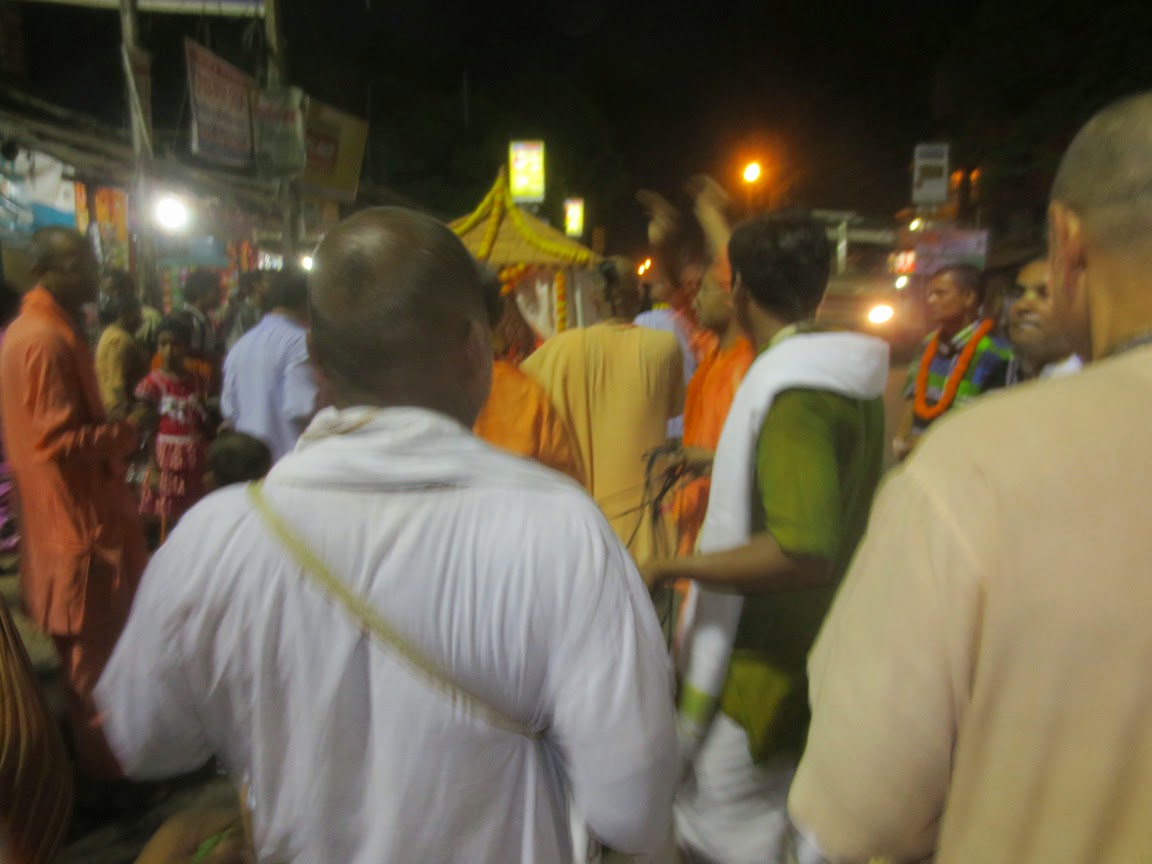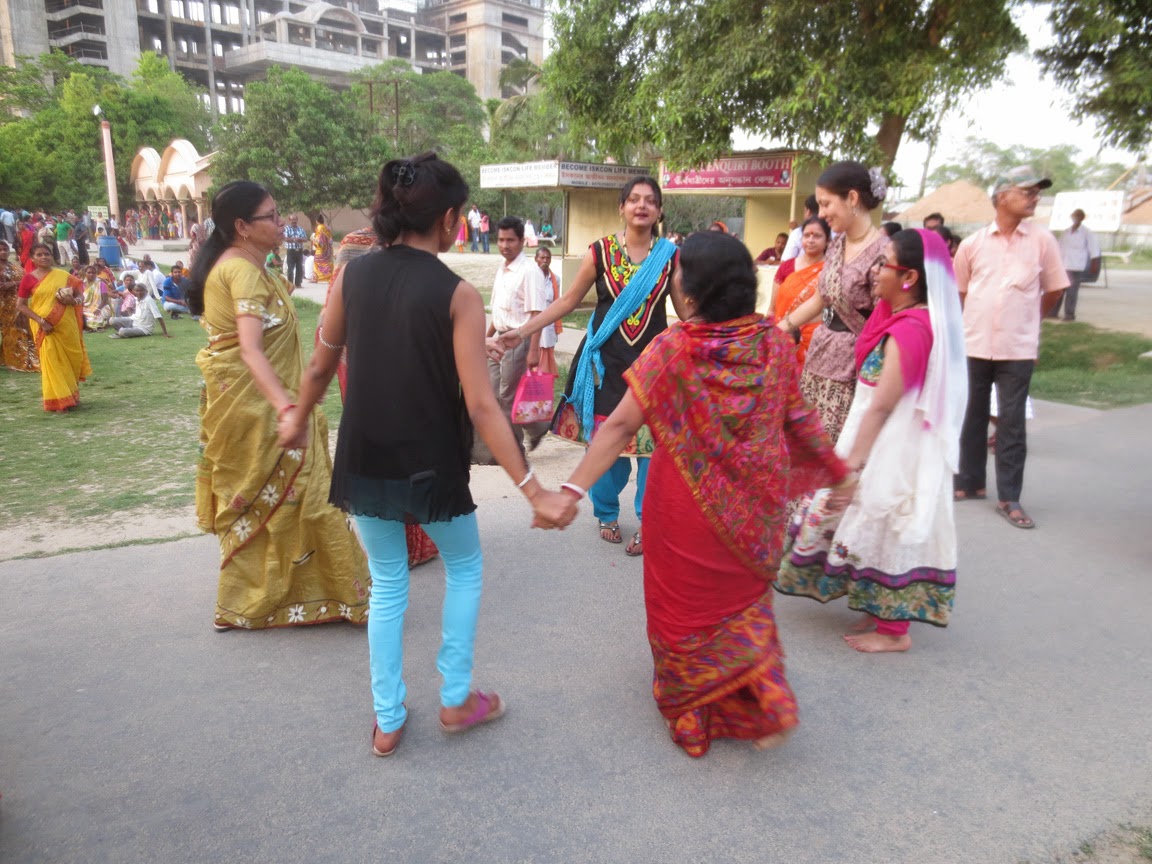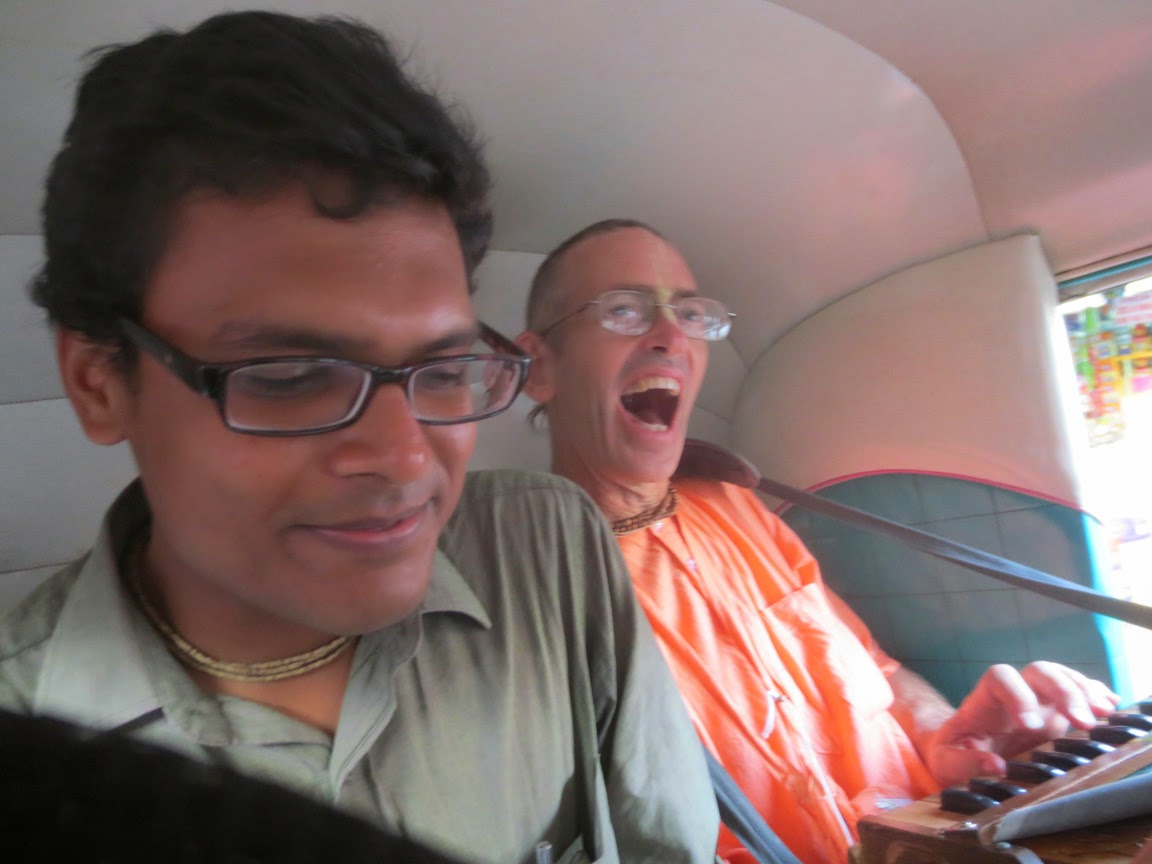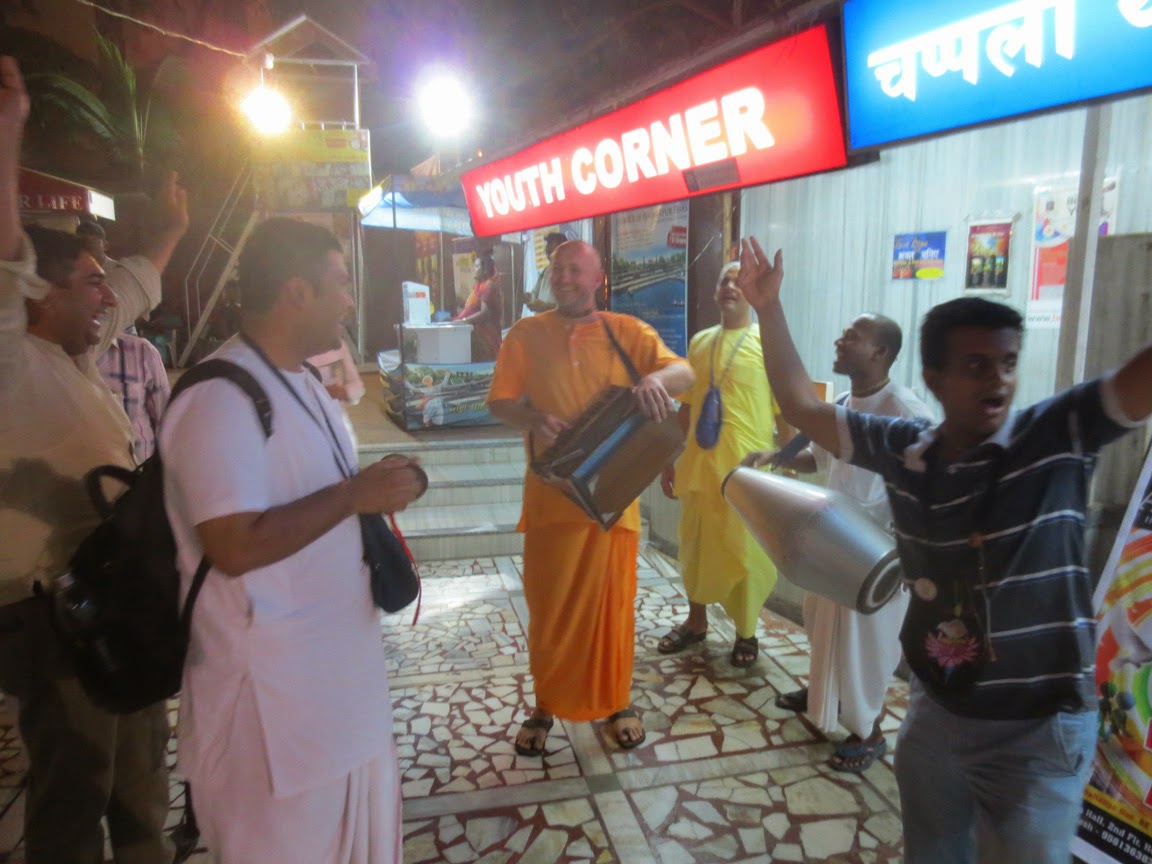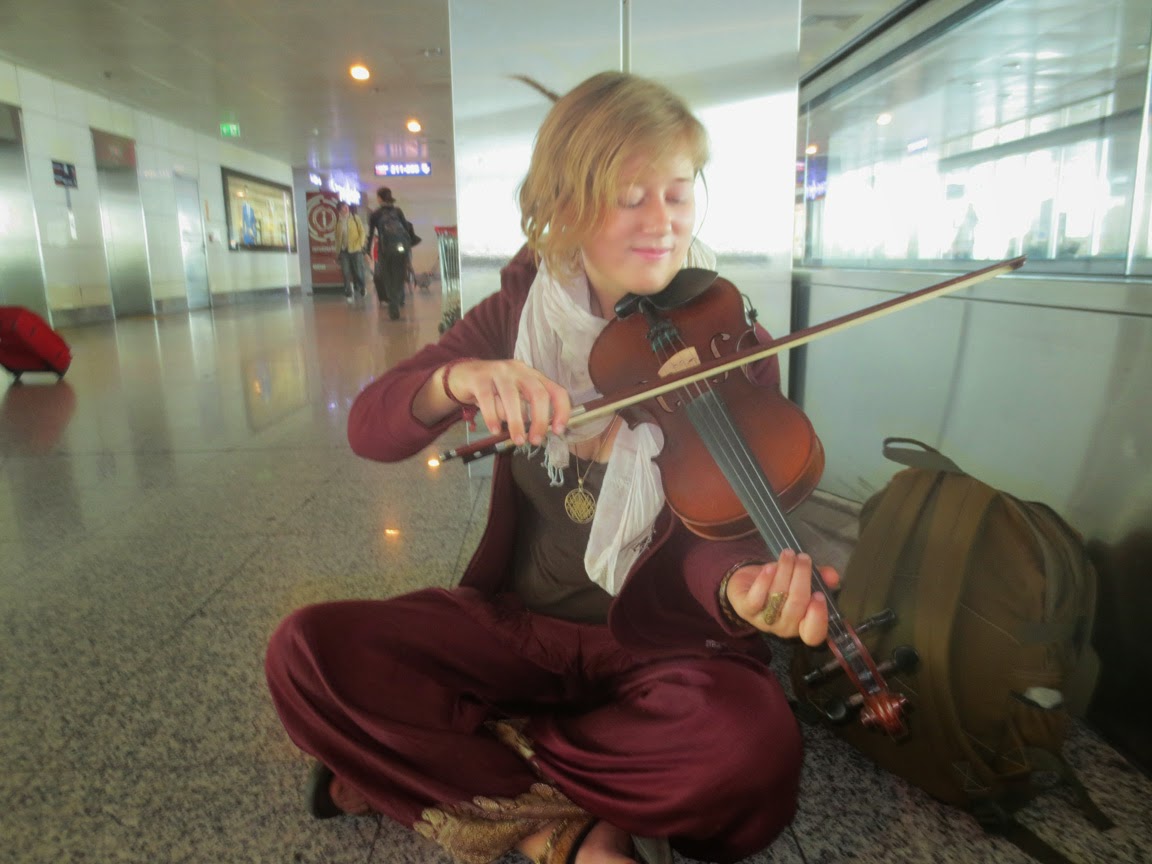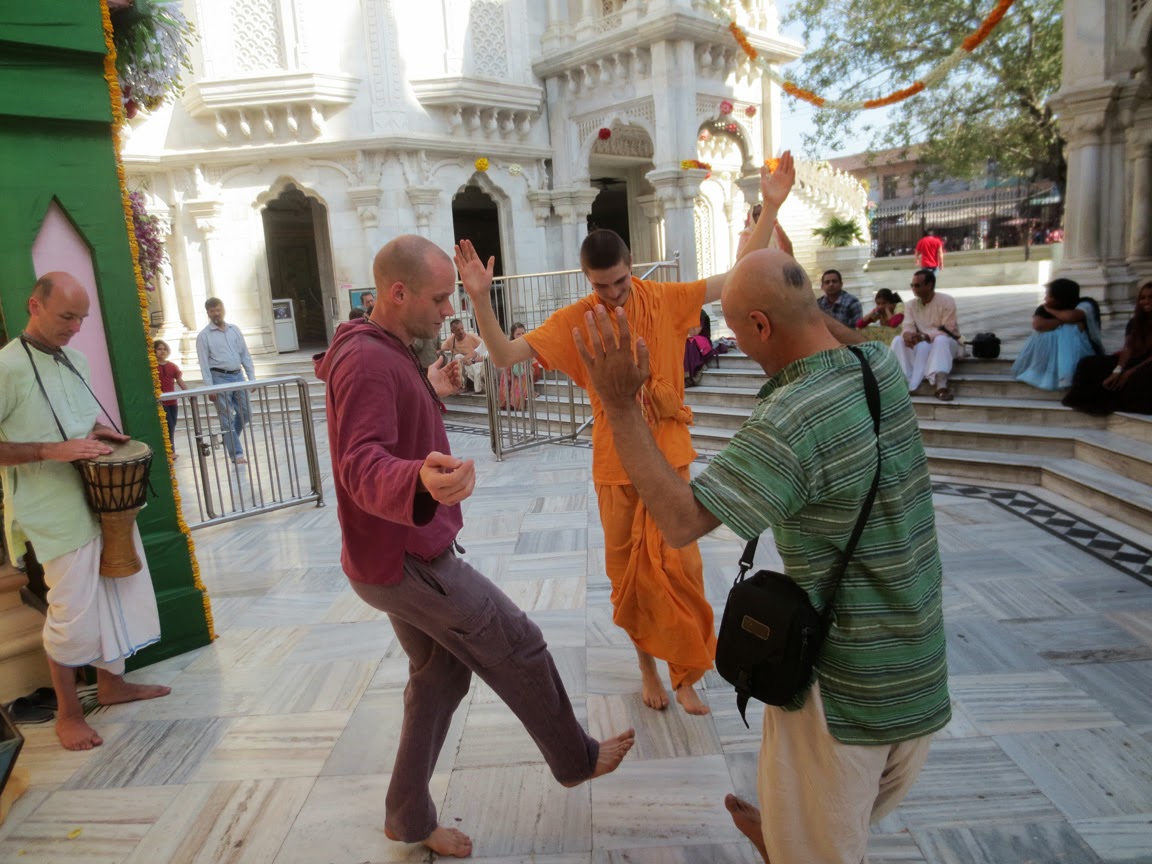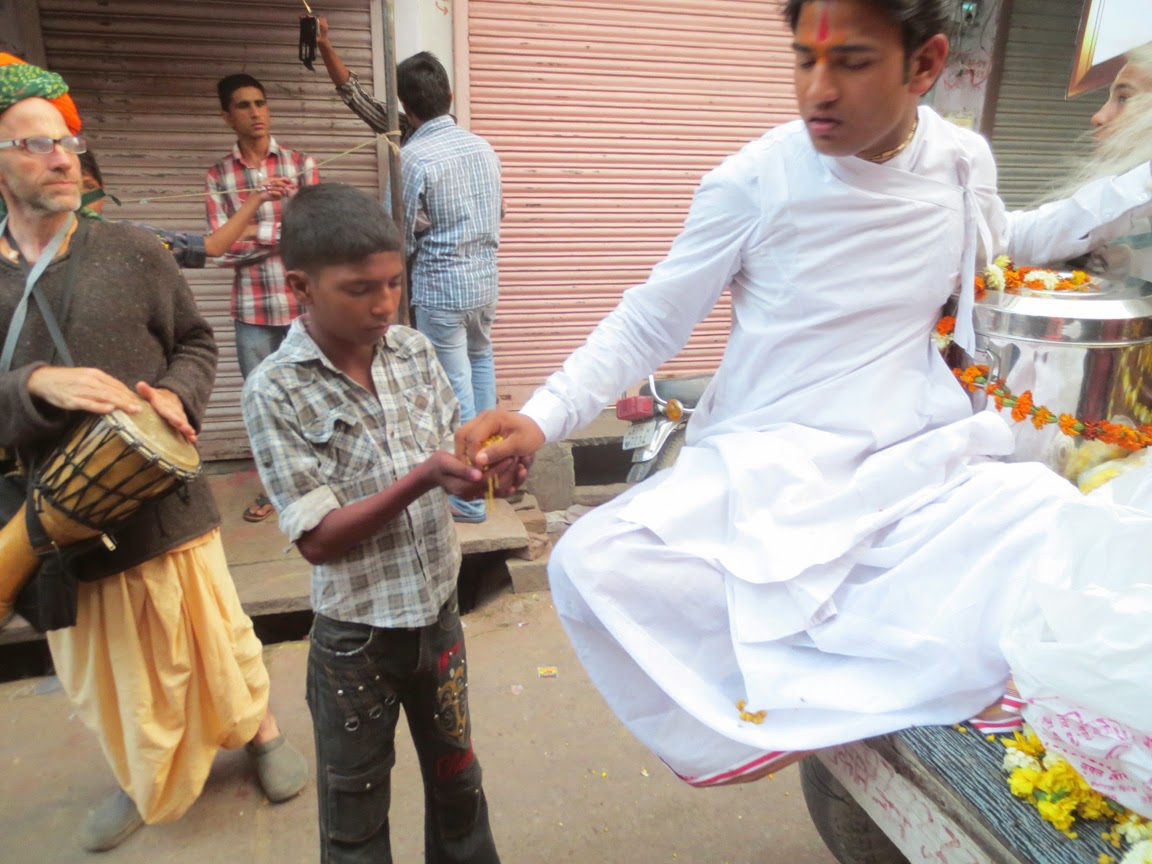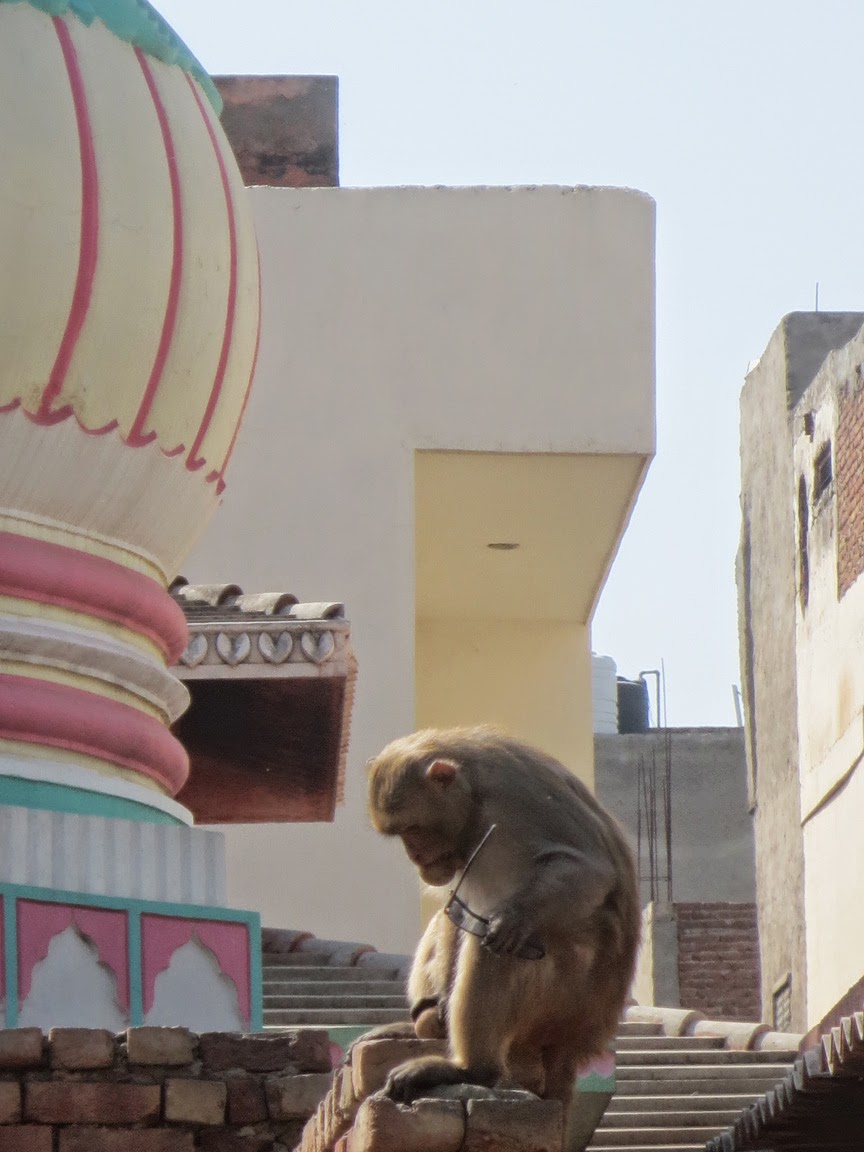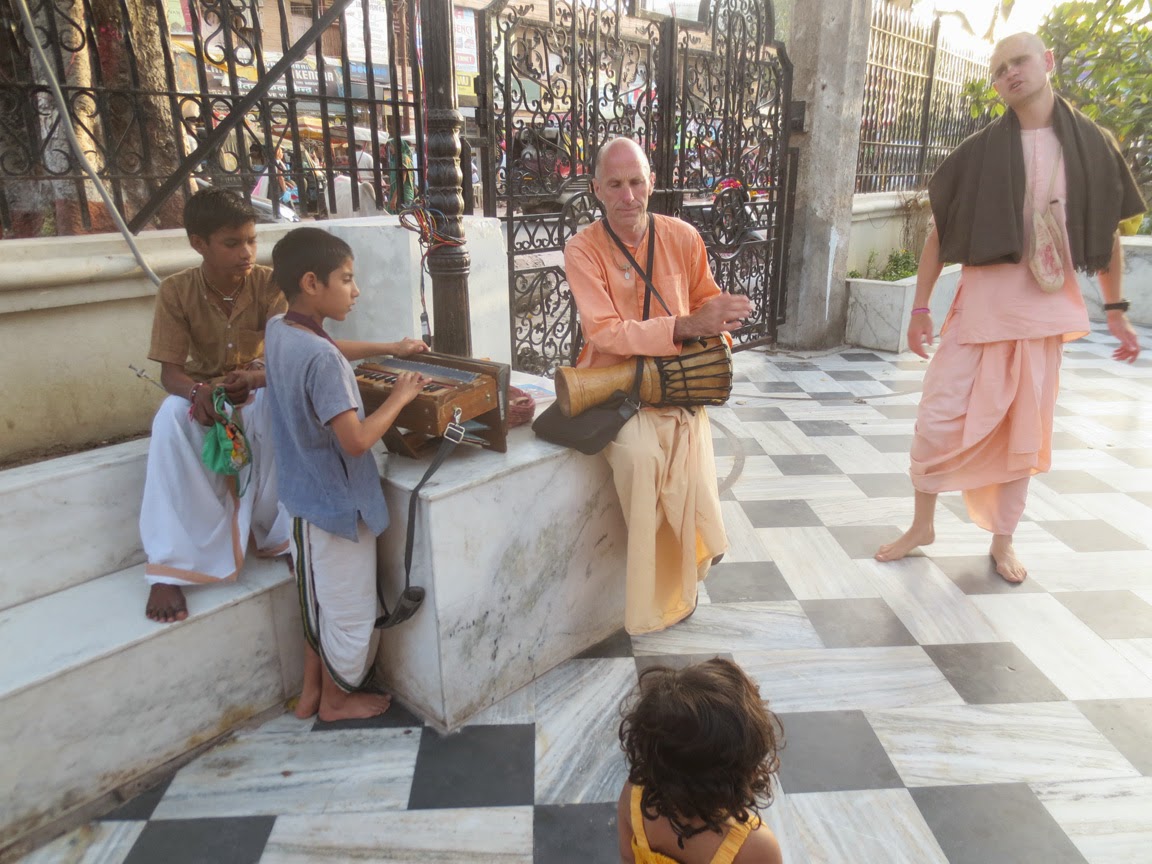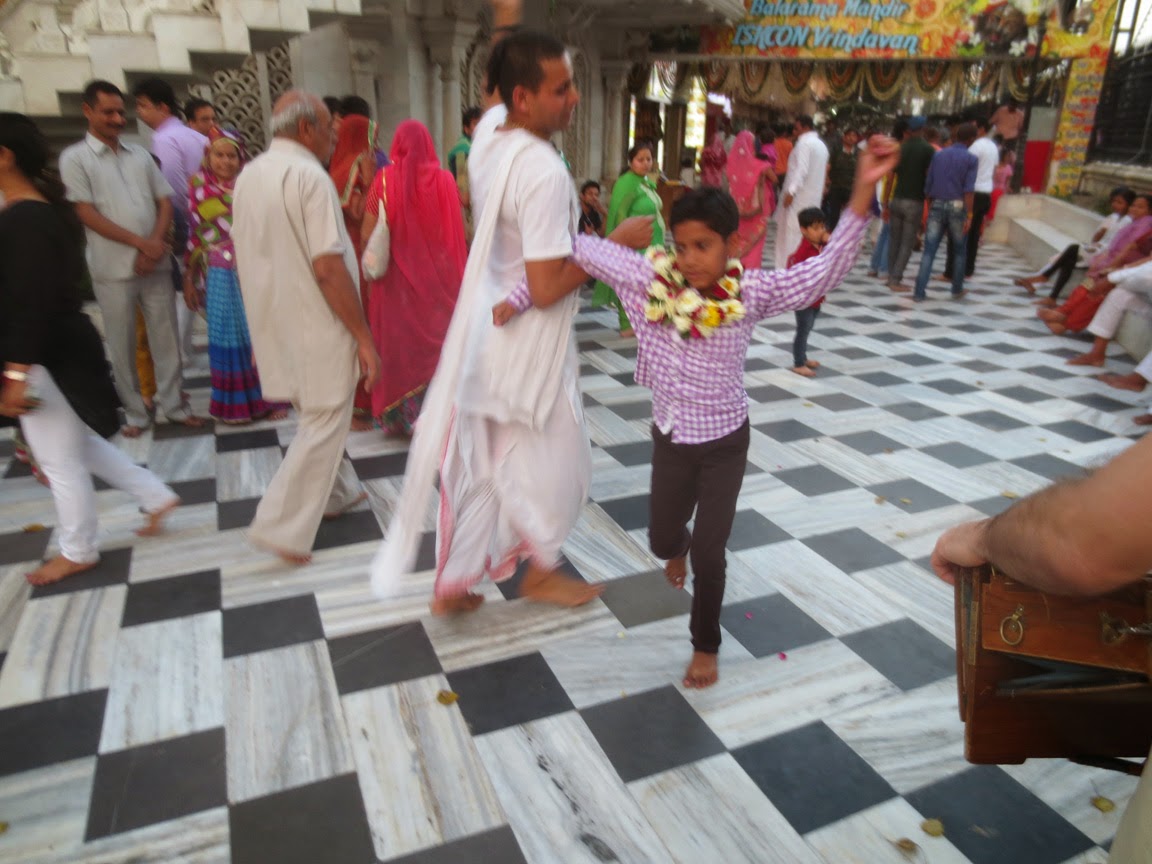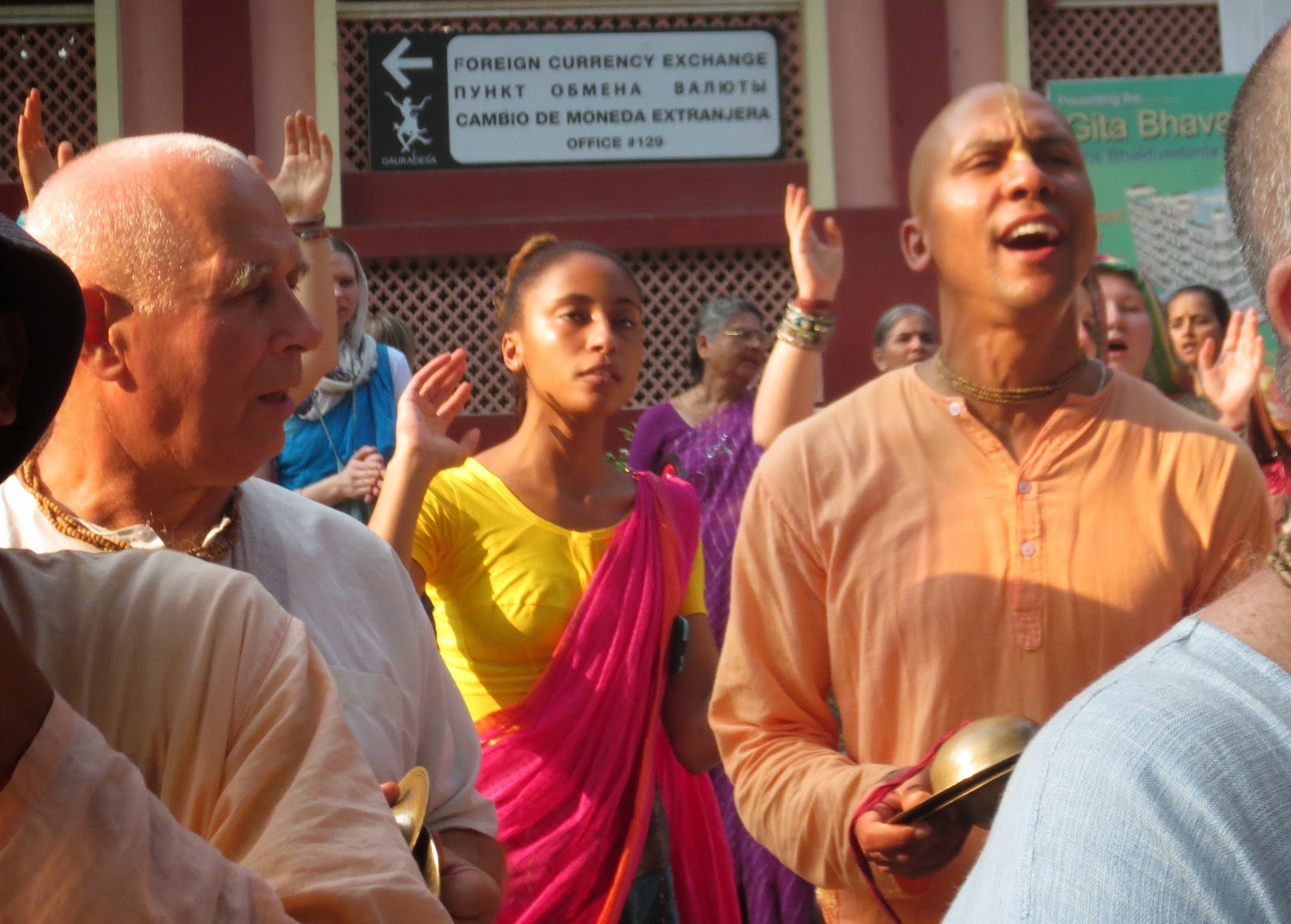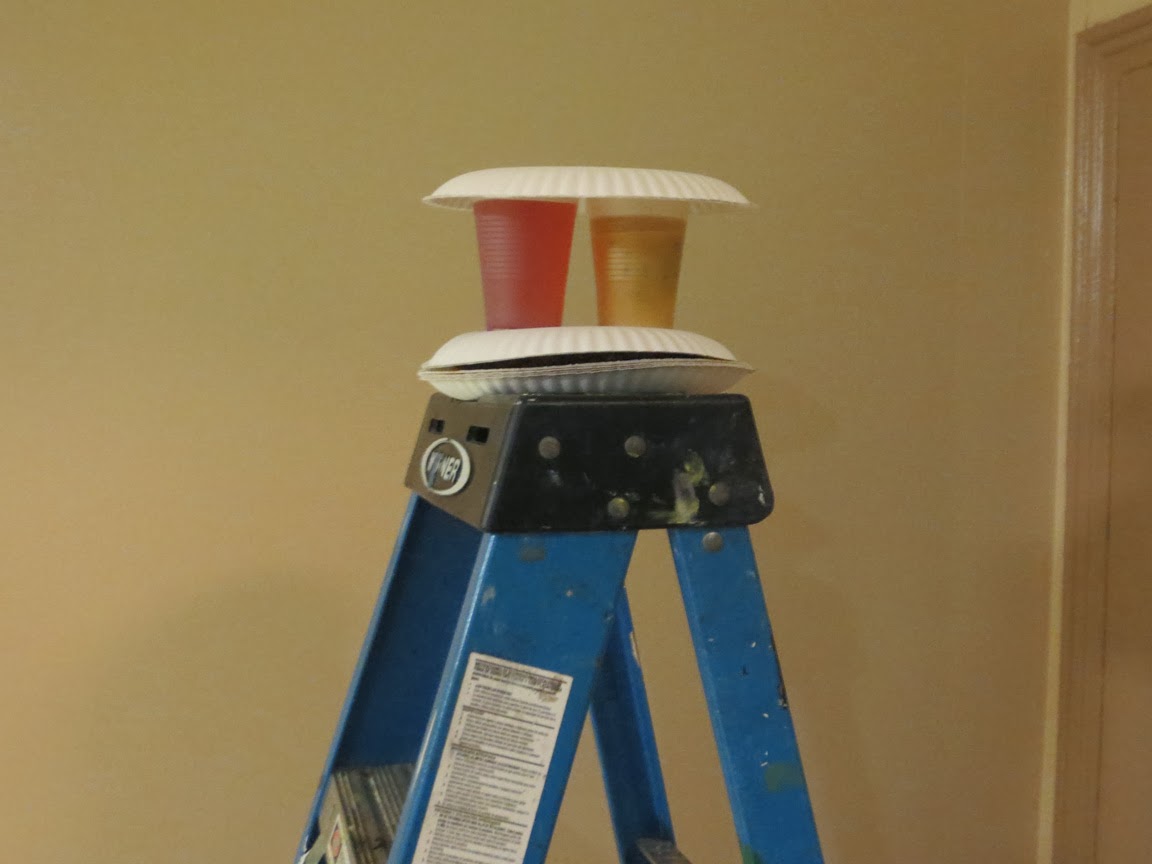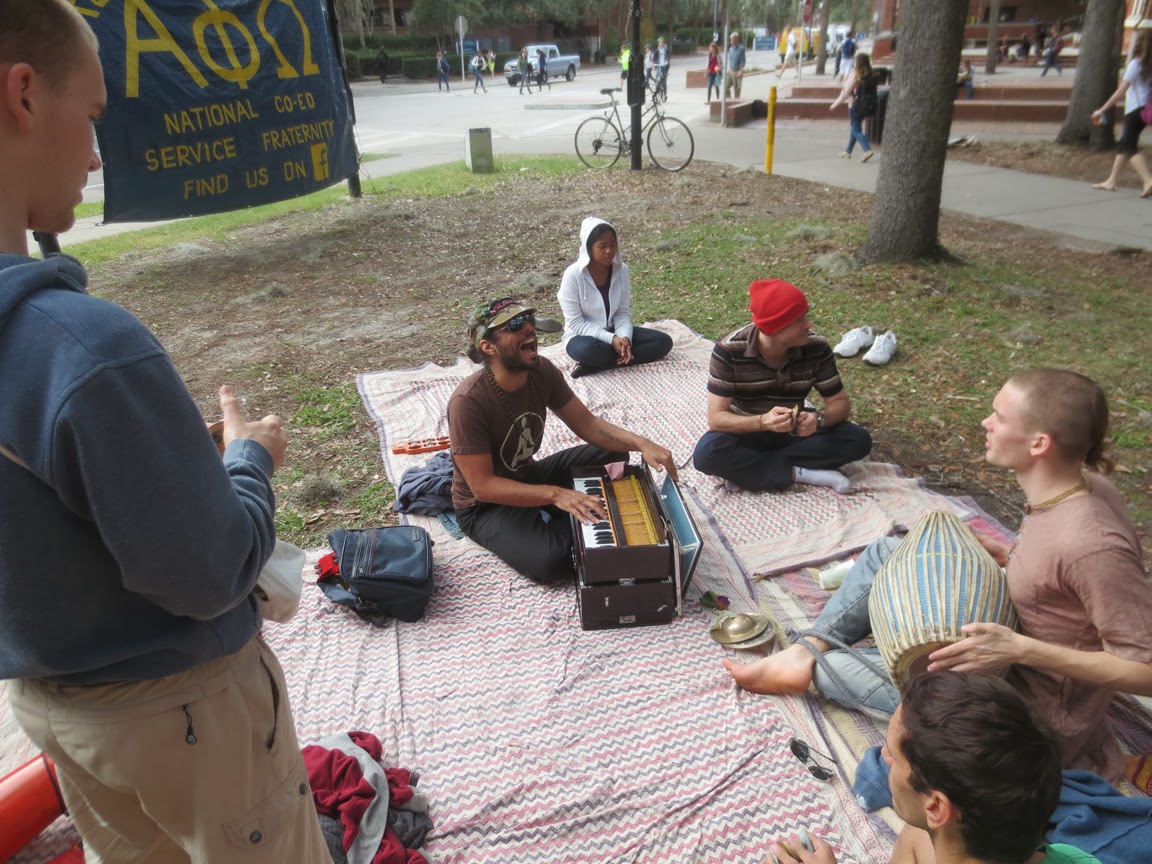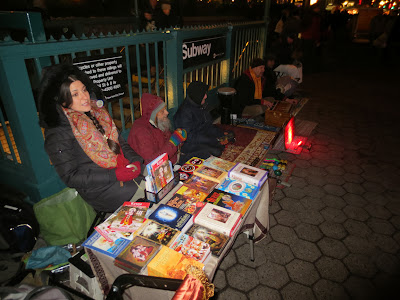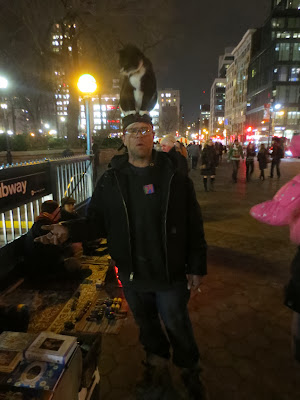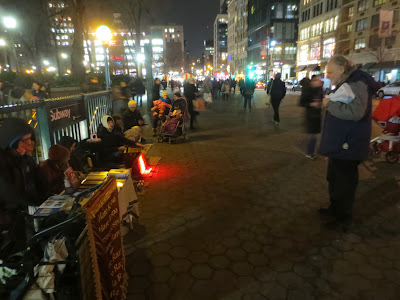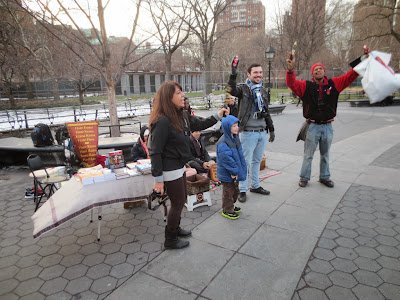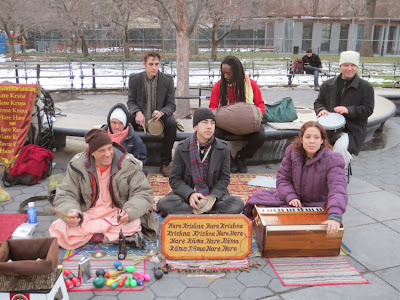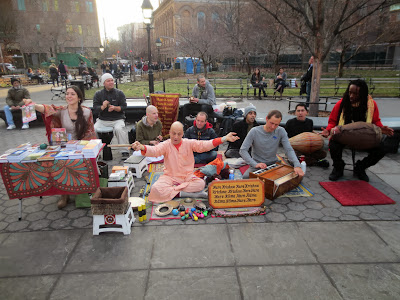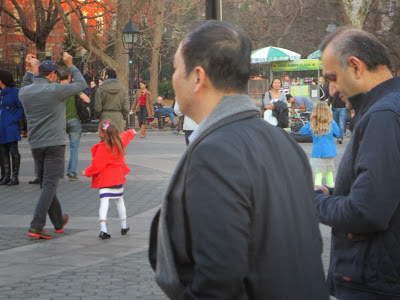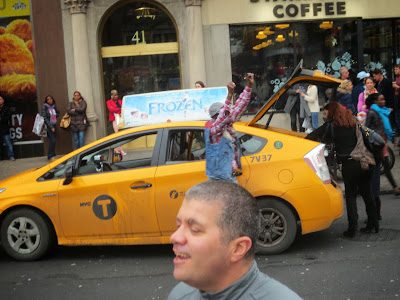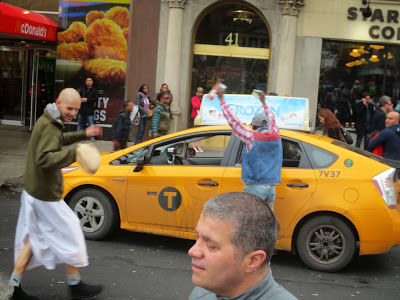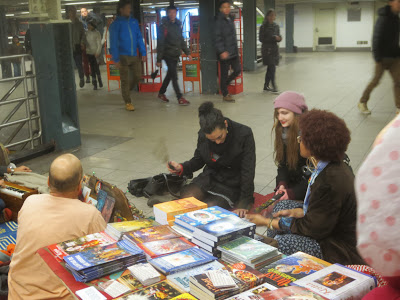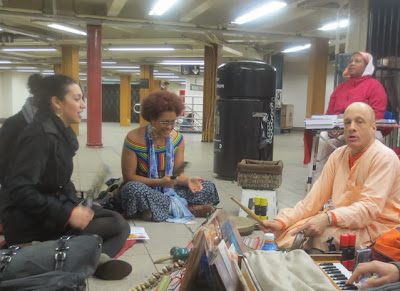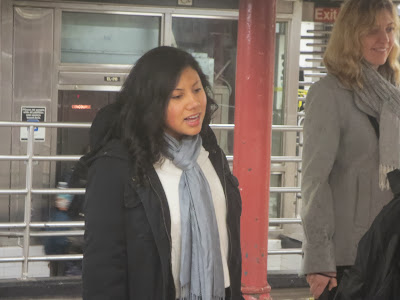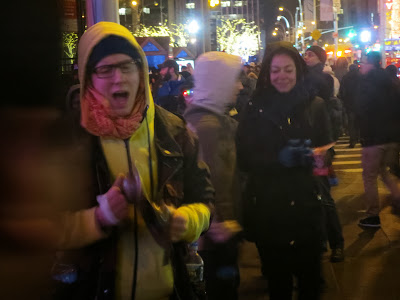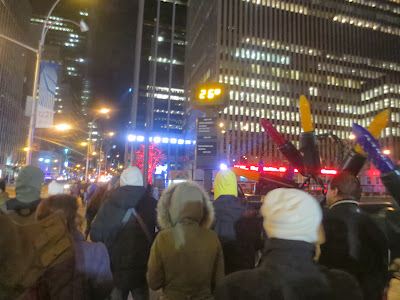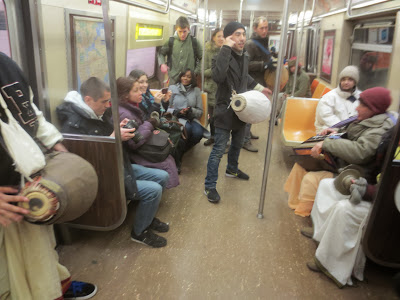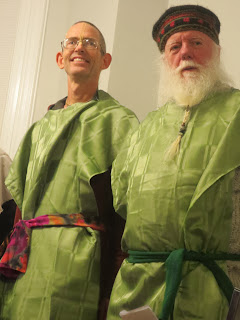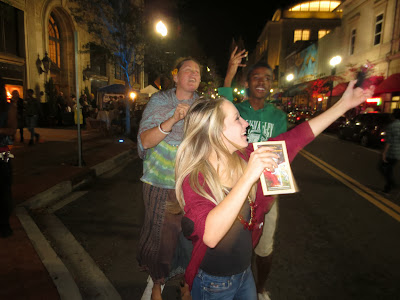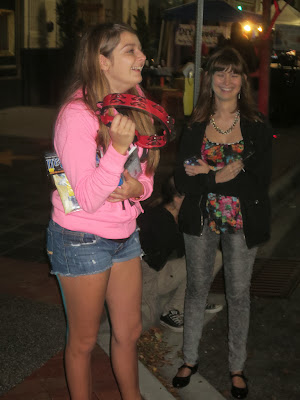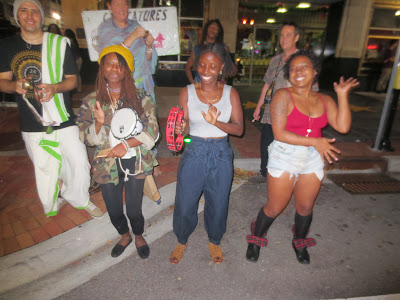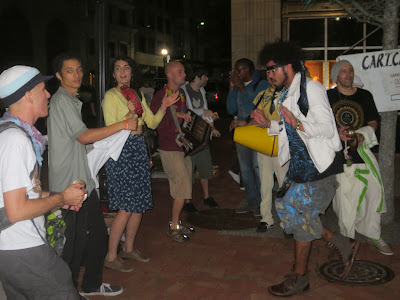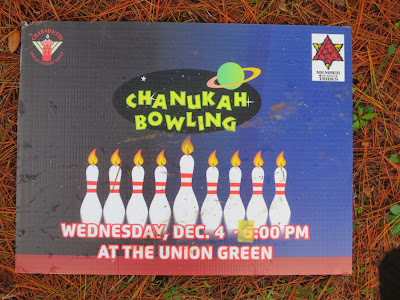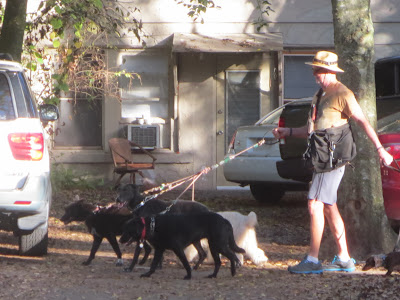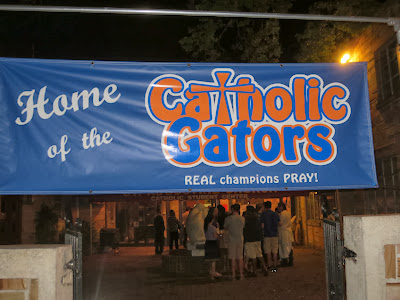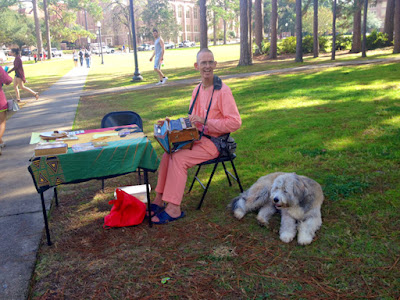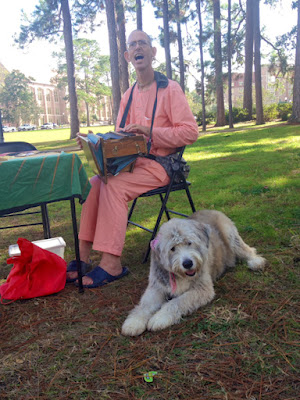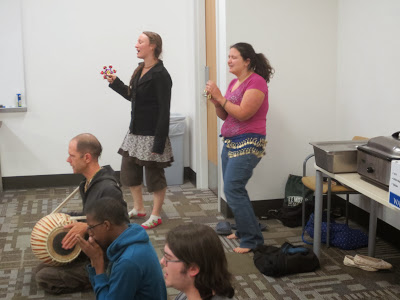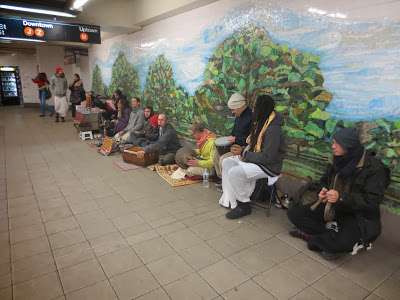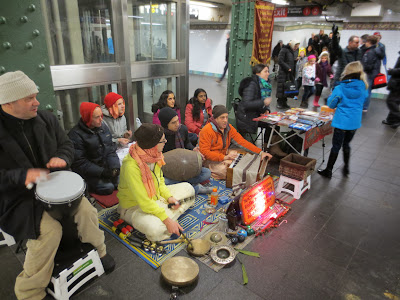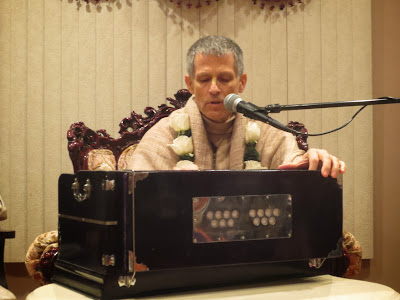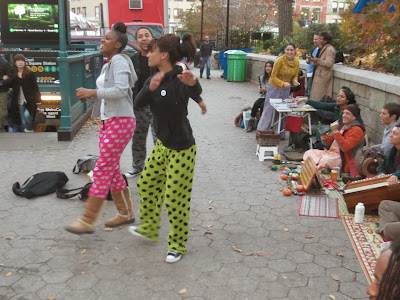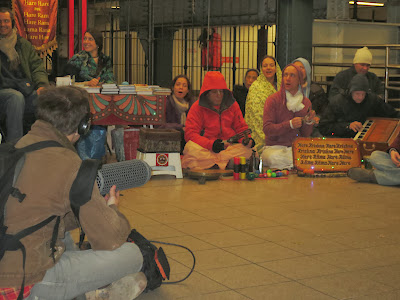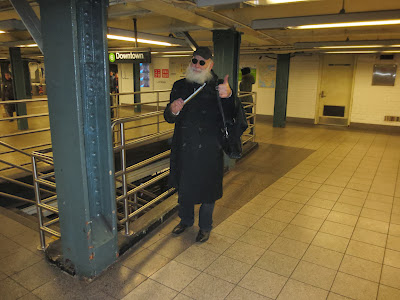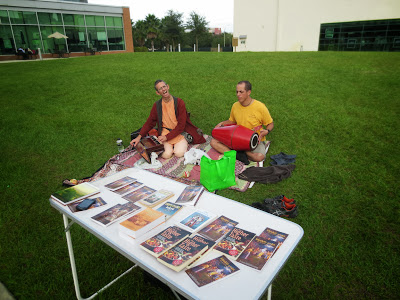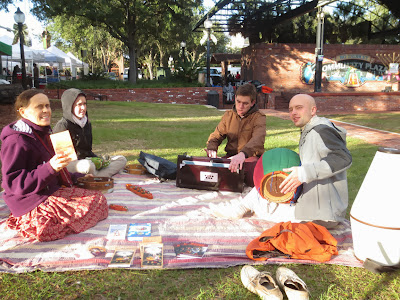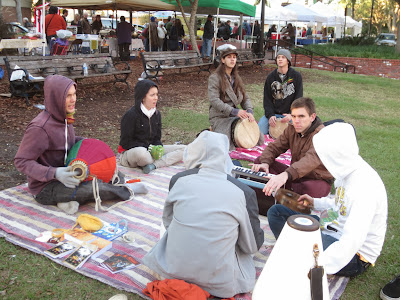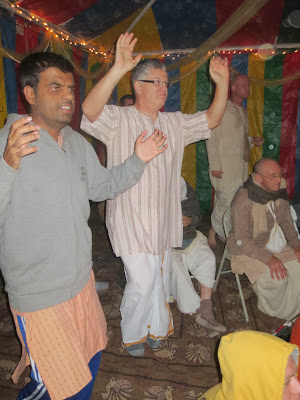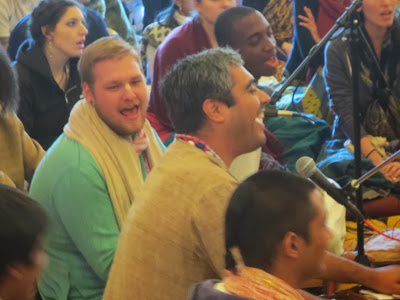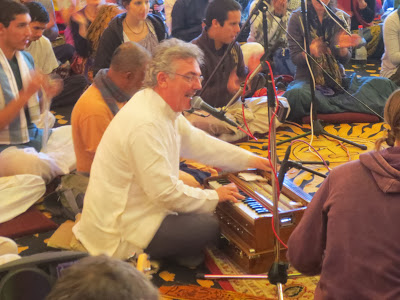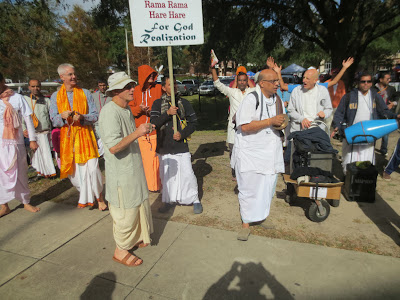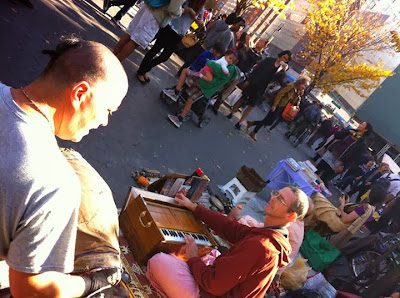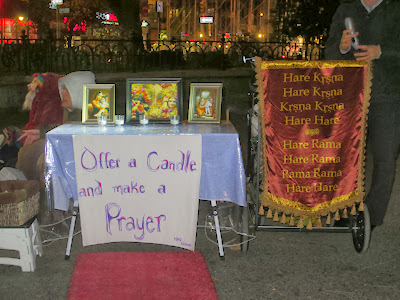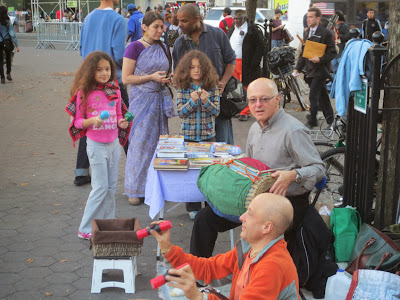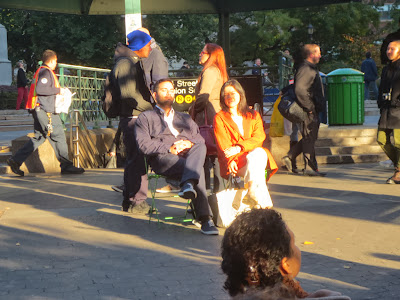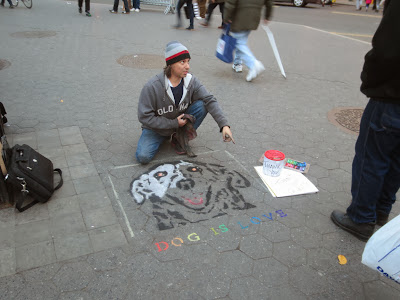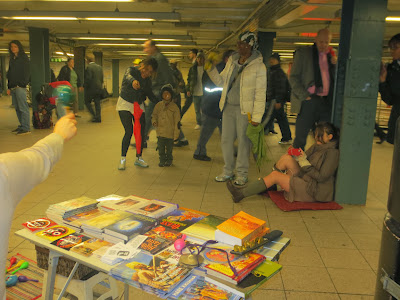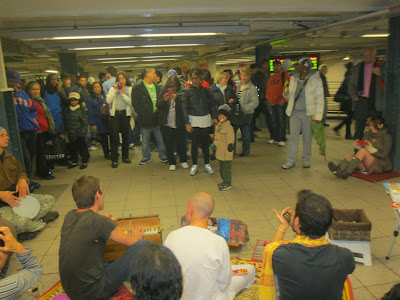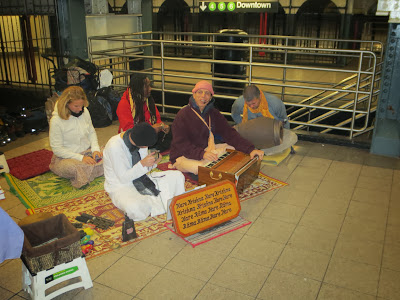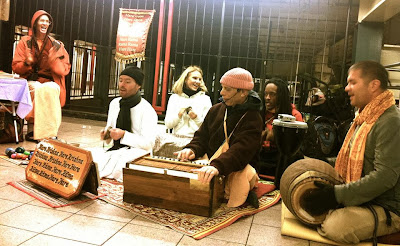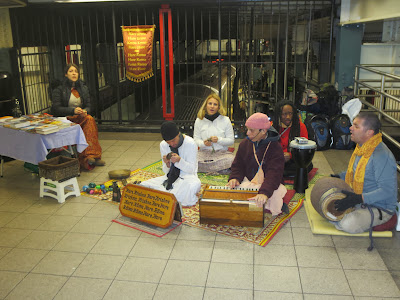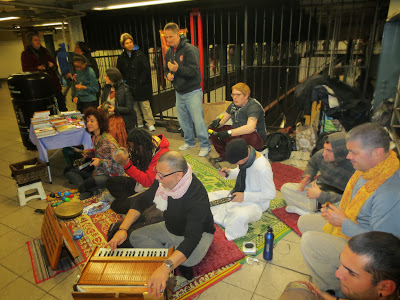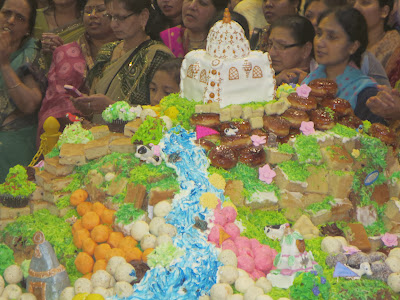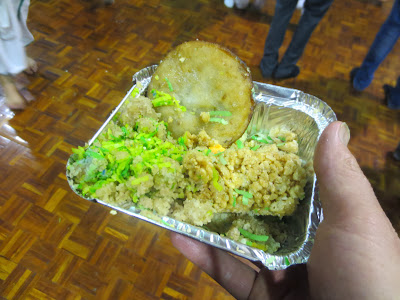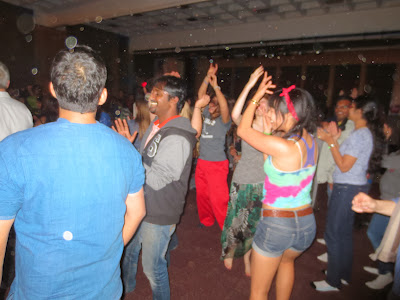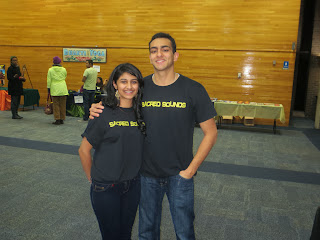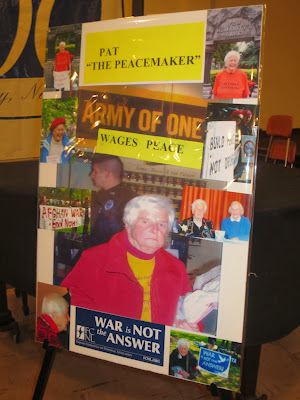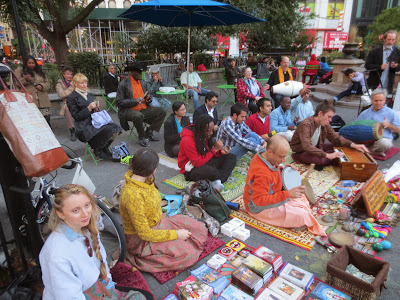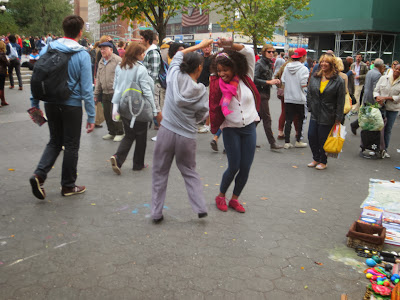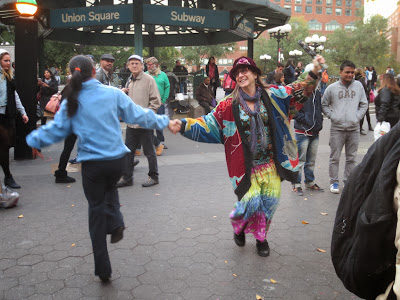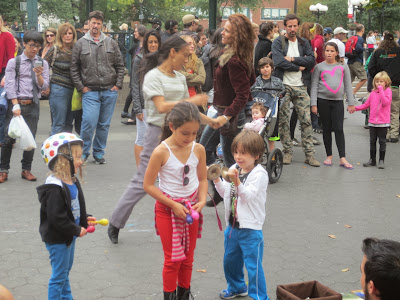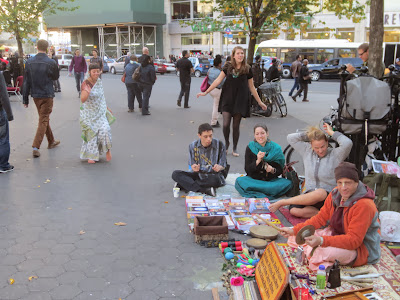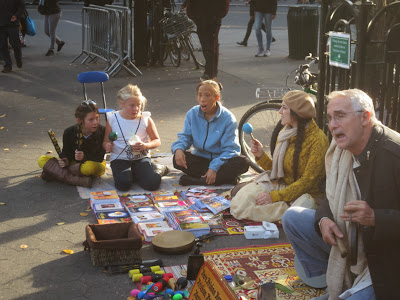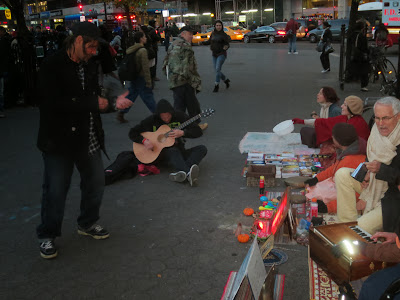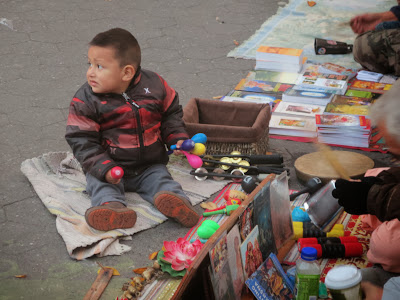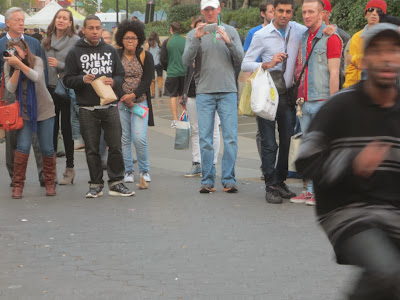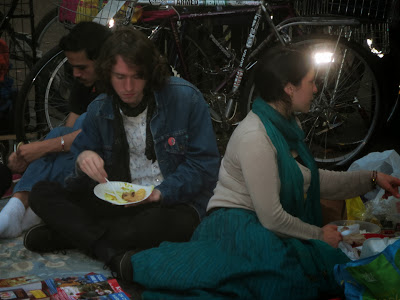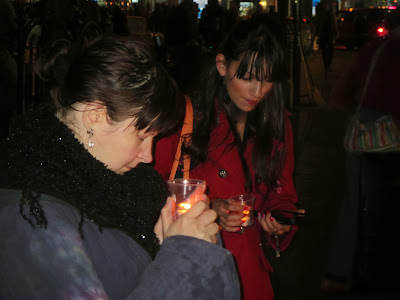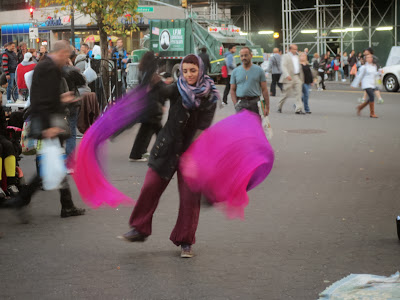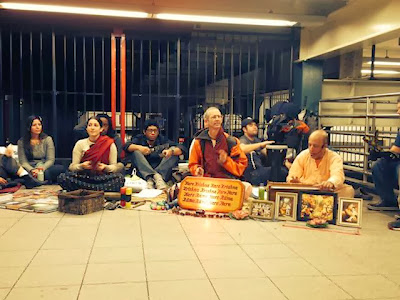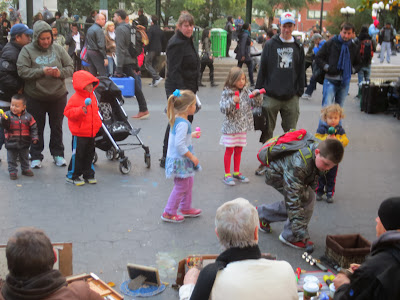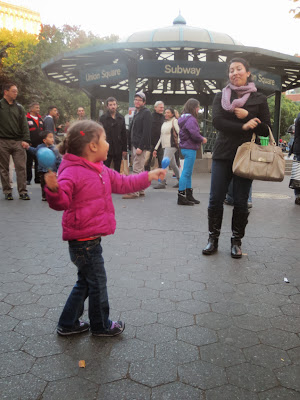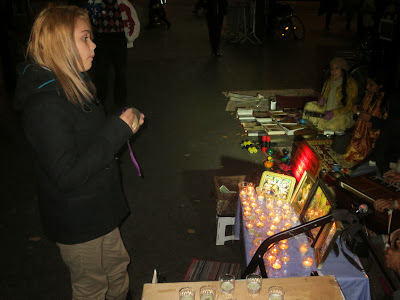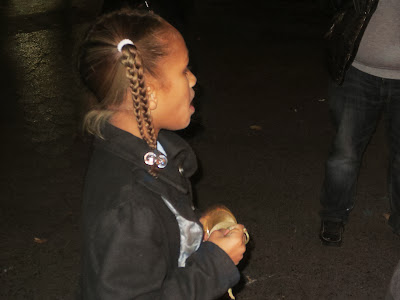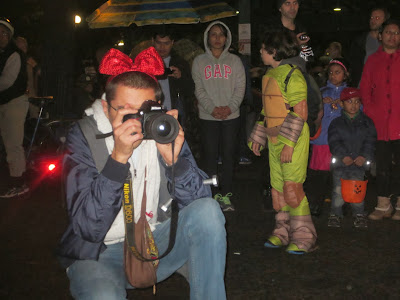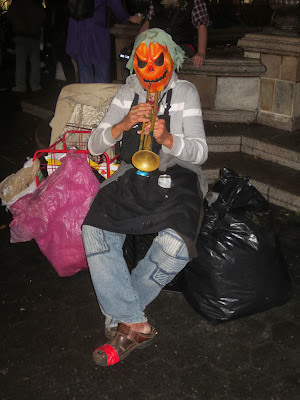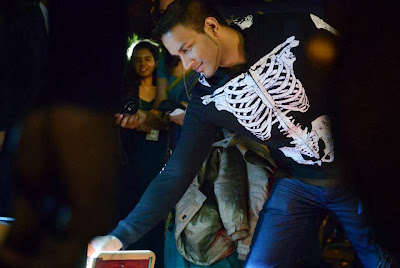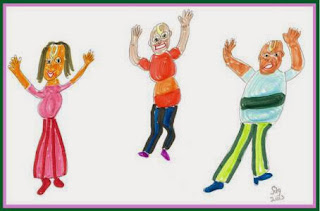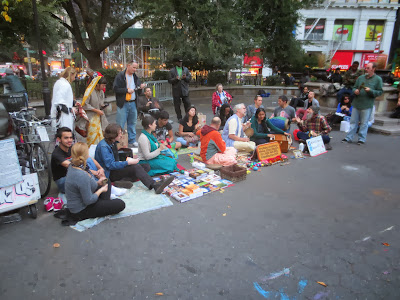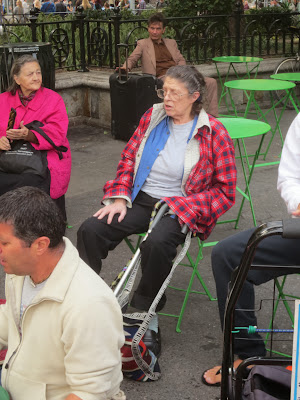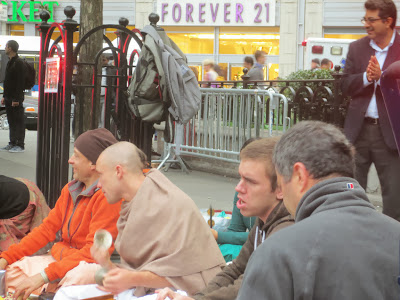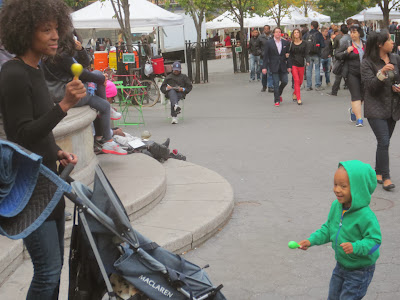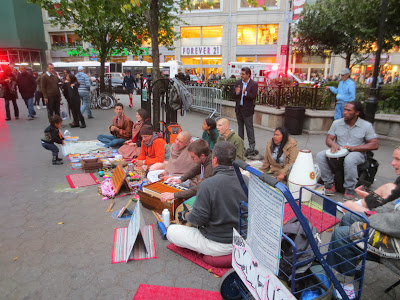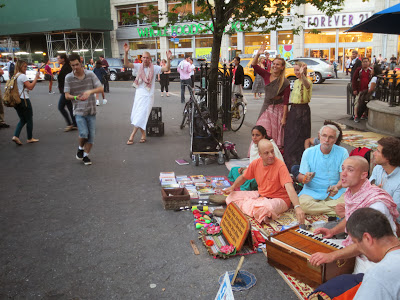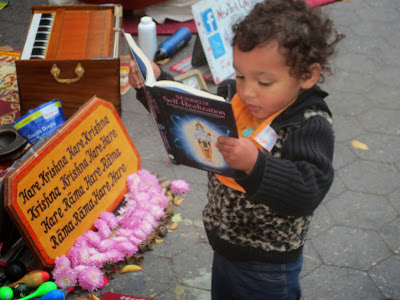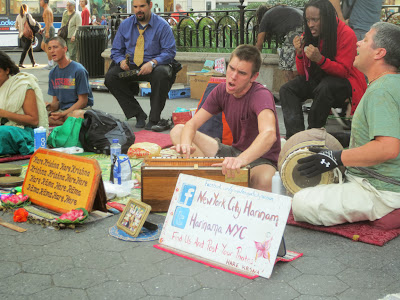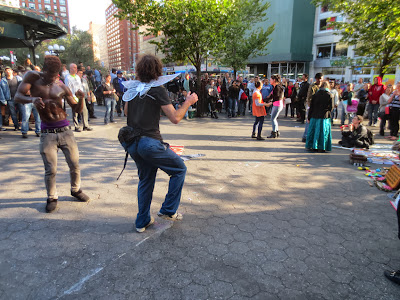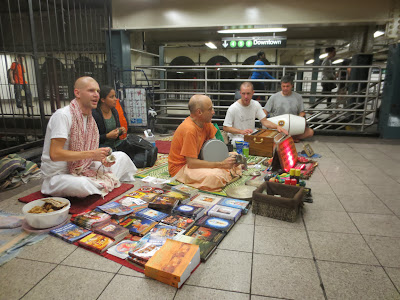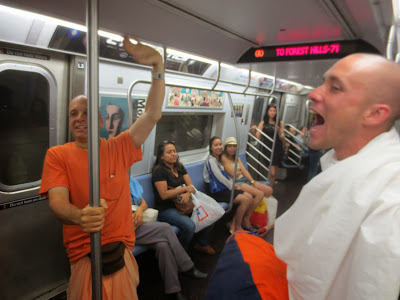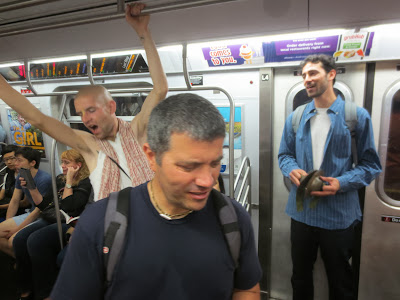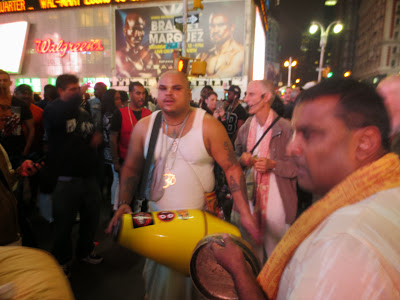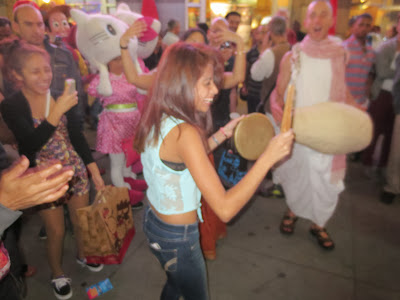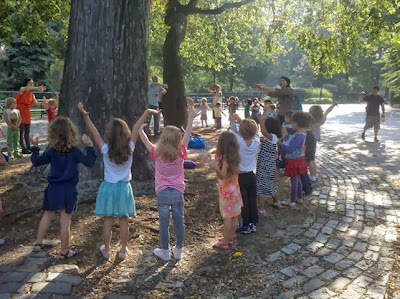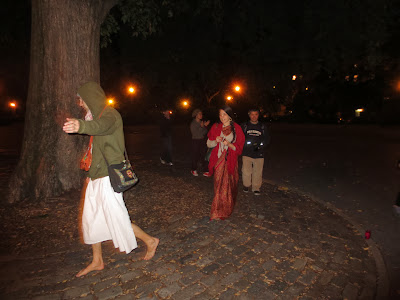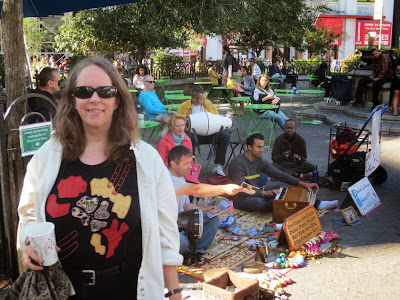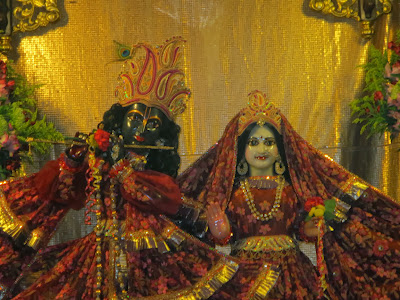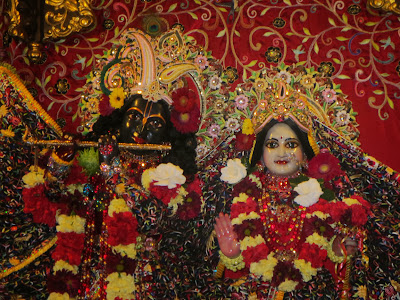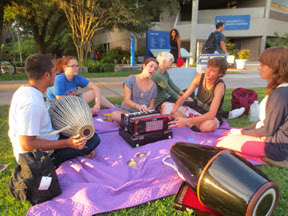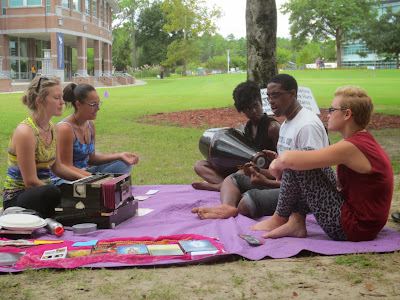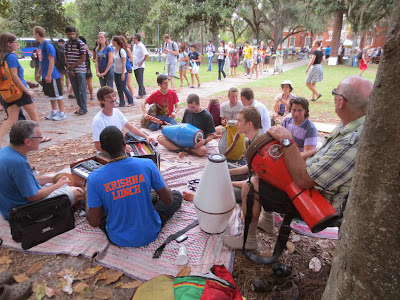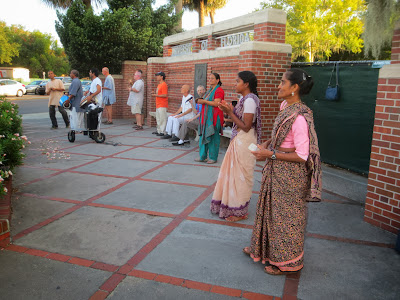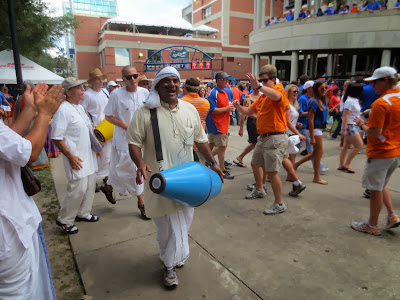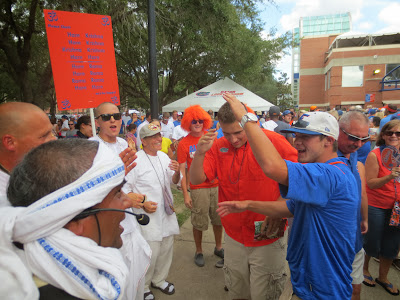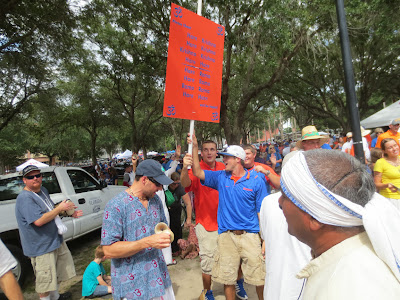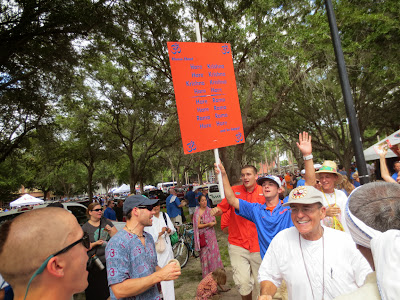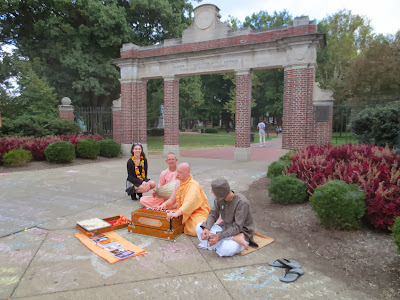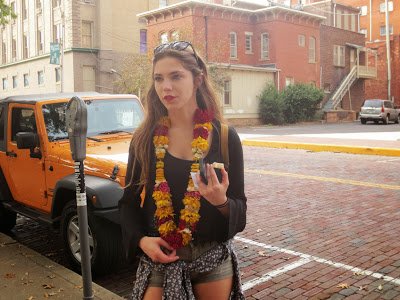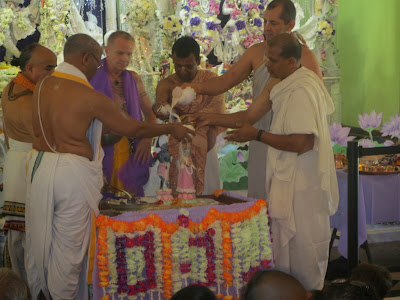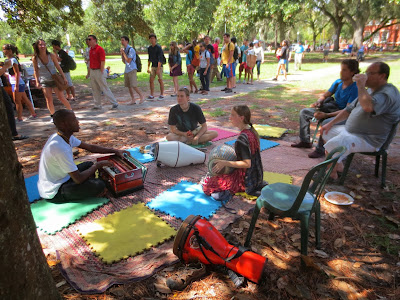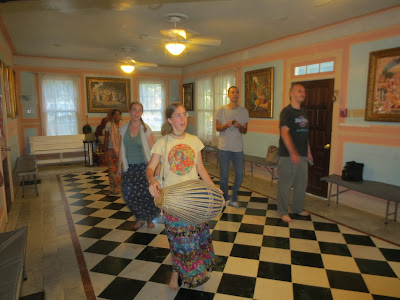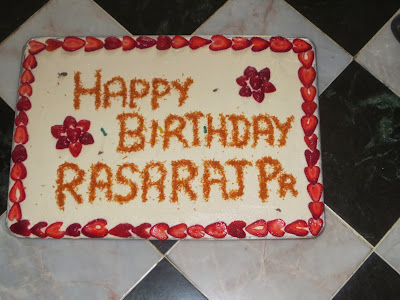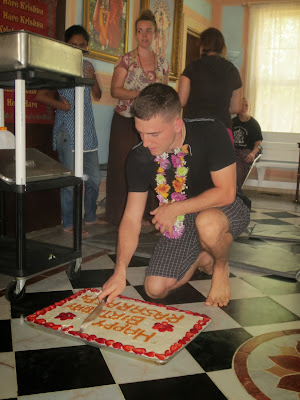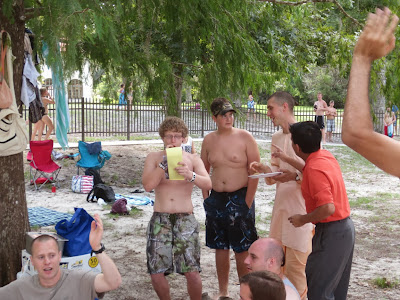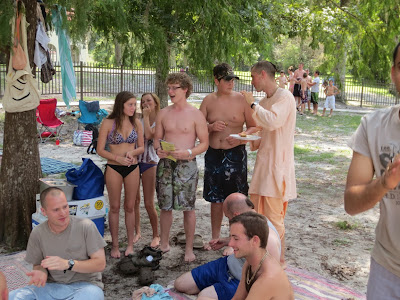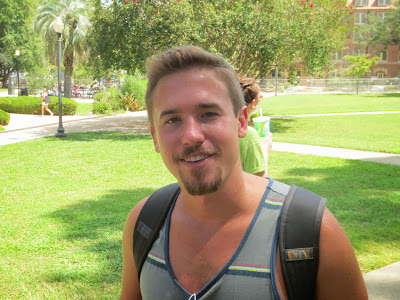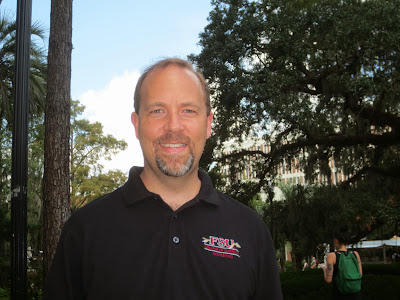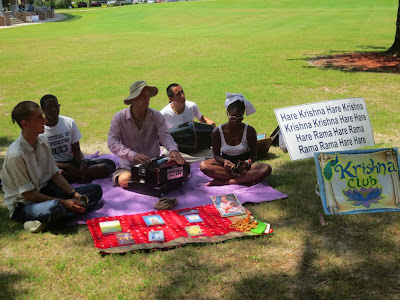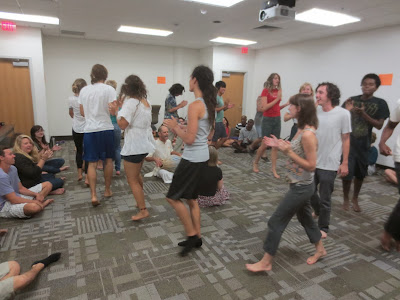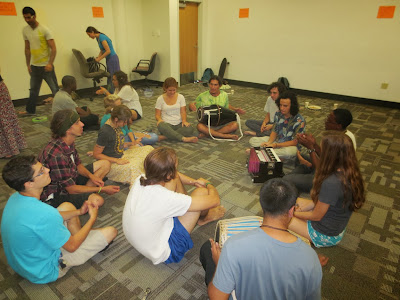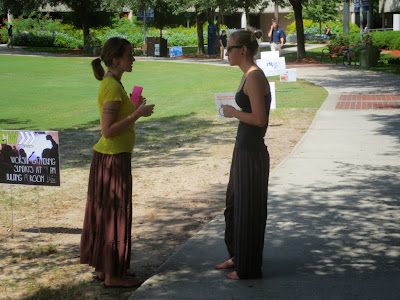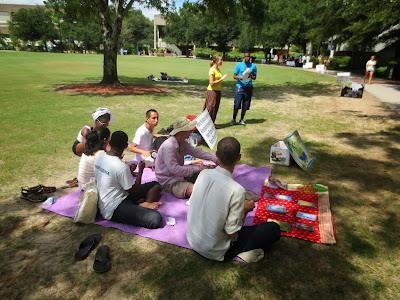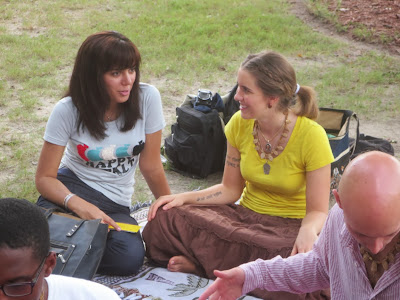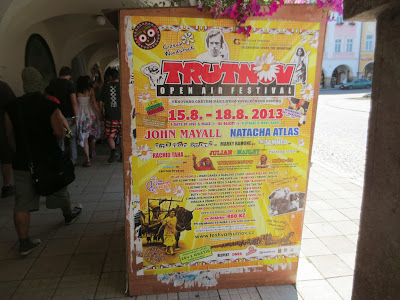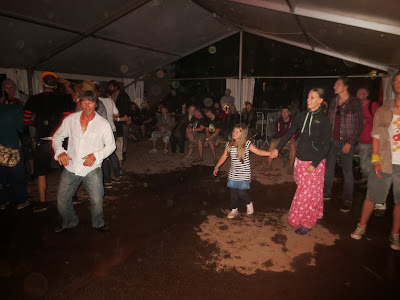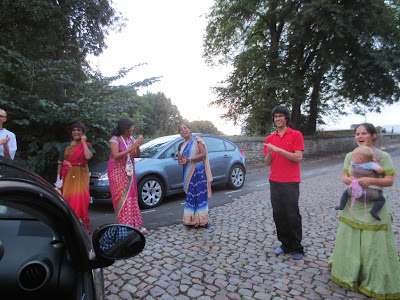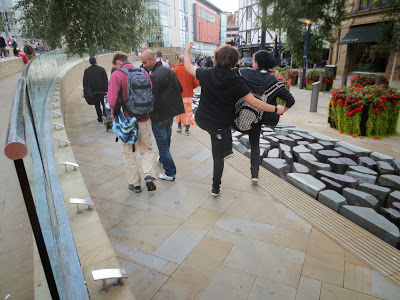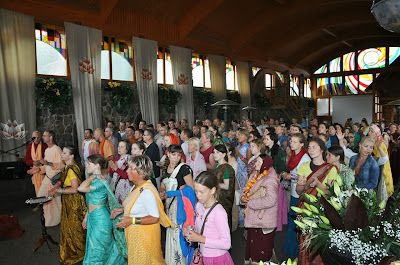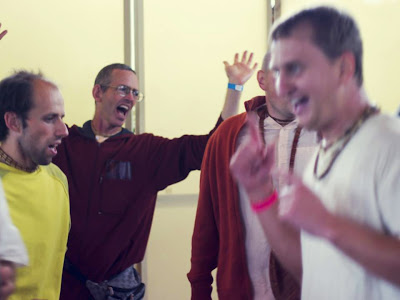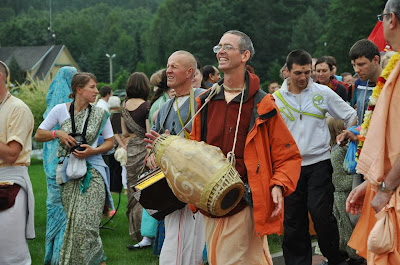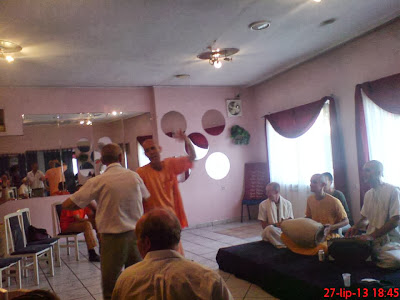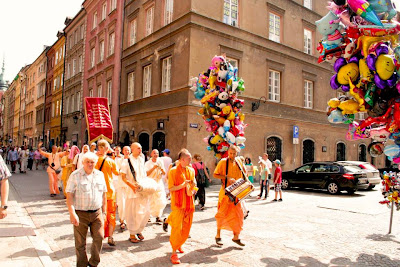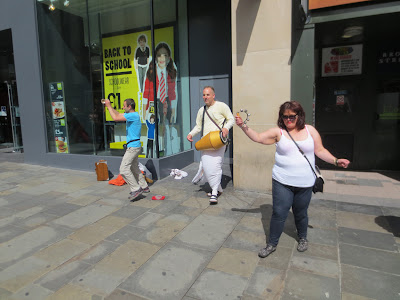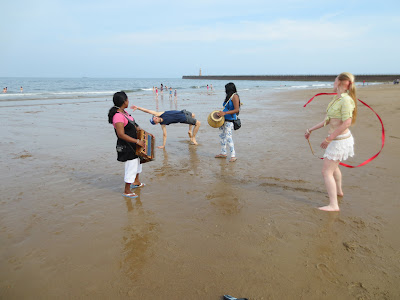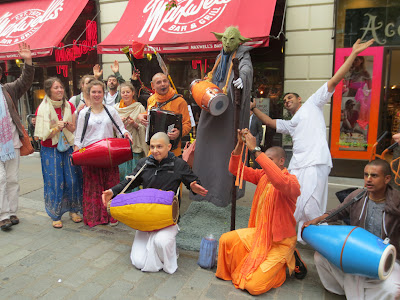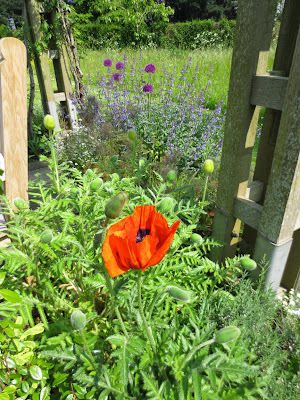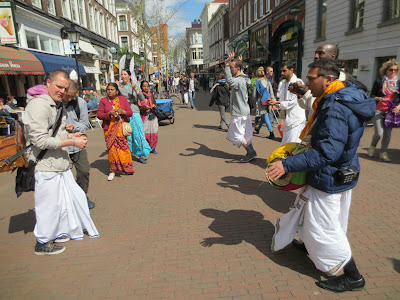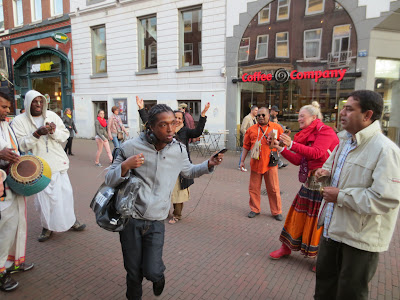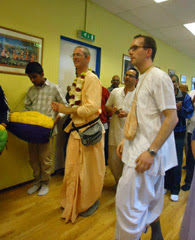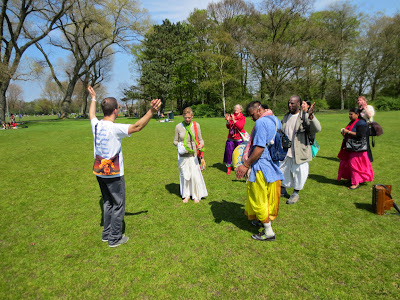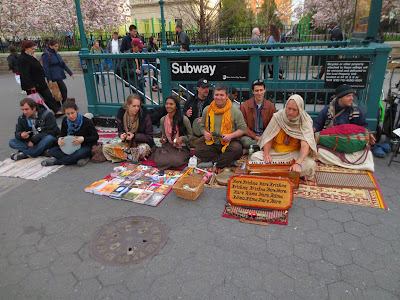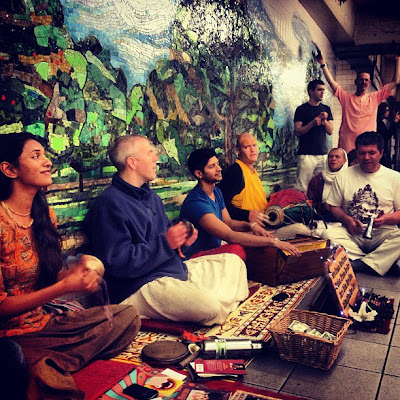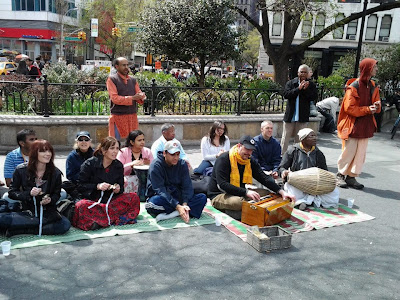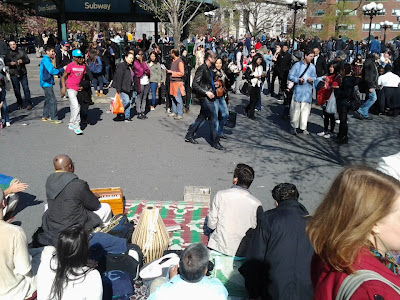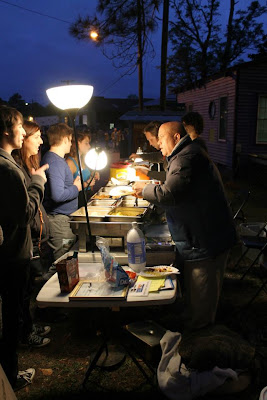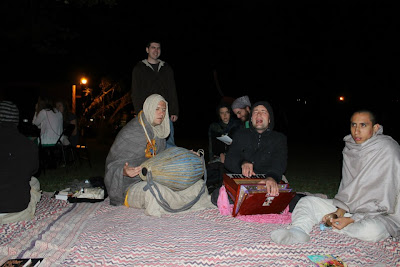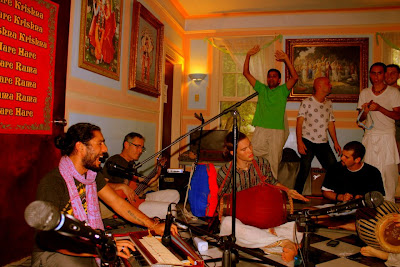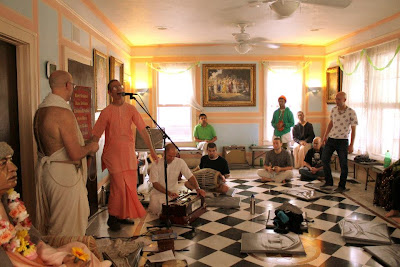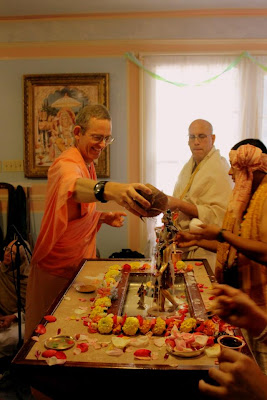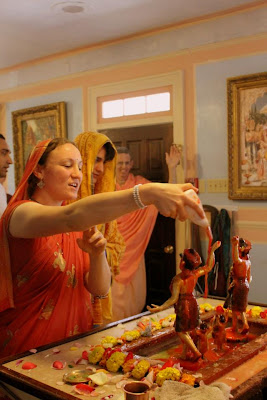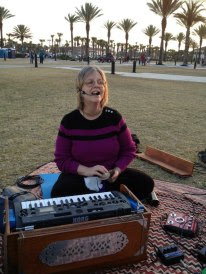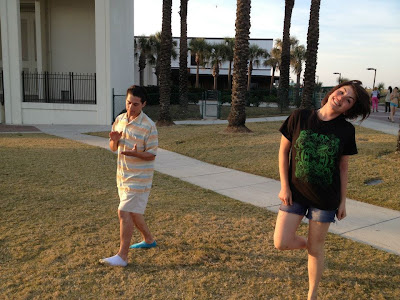By Krishna-kripa das
(June 2014, part two)
(Sent from Kostrzyn, Poland, on July 29, 2014)
Jake, on the extreme left of the above picture, who has been coming to our programs in Newcastle for a year of so, stayed an extra few days after Ratha-yatra and came on harinama.
There were many, many people who danced, chanted, and smiled, encountering our harinama party in London.
It was the first time it was clear enough you could actually see the sun rise, and I think that put everyone in a good mood.
We did it from 1:00 to 3:00 a.m. in the morning! I think it is the only Ratha-yatra performed at the time of day, or rather, that time of night.
People are attracted by the opportunity to pull the Jagannatha cart, although often they are a bit intoxicated.
“Yes,” I replied smiling, “it is all good.” And I recalled Rupa Goswami saying, “Pure devotional service is the beginning of all auspiciousness.” It was wonderful that an apparently ordinary guy could glimpse the truth that Krishna consciousness is all good, or as it is described in the Sanskrit literature, suddha-sattva, pure goodness.
One young man pushing the steel railing of the Ratha cart said, “This is the best steel I have ever touched!”
I went to give her my card, saying I could tell her about all our festivals in the UK, but she said she still had my card from Rishikesh.
In Leeds we chanted in a natural cosmetics shop, and all the employees were happy we were there.
Dayananda Swami, who was visiting York for some North UK meetings, joined us.
Some girls took pleasure in dancing to our music two and possibly even three times. We also encountered a natural cosmetic shop in York, and all three employees loved the kirtana, and they also danced around in a circle (https://www.youtube.com/watch?v=WyvAONyGwuE).
We even all danced in a circle at one point. I do not recall ever getting such a nice reception in a shop! Thanks to Nikhil Padhiar for the great video! Who would guess that natural cosmetics sellers in The North of England would have a spontaneous attraction to kirtana?
Travel Journal#10.11: Scotland, The North of England, Nottingham, London
→ Travel Adventures of a Krishna Monk
By Krishna-kripa das
(June 2014, part one)
(Sent from Manchester, England, on July 13, 2014)
July 28–August 3: Kostrzyn (Polish Woodstock)
August 4: Bratislava
August 5–7: Czech Padayatra
August 8: Ancient Trance Festival (near Leipzig)
August 9: Leipzig Ratha-yatra
August 10: Ancient Trance Festival
August 11–13: Prague
After we chanted an hour together I chanted another half an hour alone. One young man, who had eaten at our restaurant, but preferred other mantras than Hare Krishna, gave me a donation and ate a sandwich with a friend nearby. One middle-aged man came by and stood in front of me yelling nasty things about Hare Krishna at me for a minute or two without letting up. I just kept chanting as I did not want to hear what he was saying. I was at an advantage because I had an amplifier. After he passed me, he called someone on his cell phone and then returned, going in the other direction. Again he yelled at me, and I just kept singing. After he left, a young man who had been passing out invitations to a business just across from me the whole time, and who watched the whole incident, came up and gave me a donation, as if to show he approved of my ignoring the angry rascal, and the young man who had previously given me a donation, smiled as he left and indicated he was happy I did not let the angry man disturb my transcendental vibrations. I would like to spend more time in Nottingham elevating the consciousness of the place and helping promote our restaurant there.
Thanks to Vishnujana Prabhu for the picture of Lord Jagannatha and Maha Raw for the pictures of me.
“Real, pure Vaishnavas never nourish or encourage narrow, sectarian mentalities. Without understanding a Vaishnava’s most magnanimous and ideal character, if one considers that Vaishnava to be narrow-minded or sectarian, then it does nothing but expose one’s own narrow-minded, mean mentality.” (p. 15)
“Since the minute conscious living beings’ existence in the material world as demigods or human beings causes them excessive distress, that existence is simply punishment for them. Enjoying in heaven and suffering in hell because of one’s aversion to Hari are both impediments to the happiness they would derive from performing eternal service. For the living beings, both the desire for temporary happiness and the desire to free themselves of distress are simply obstacles on the path to attaining the unlimited and pleasant service to the Supreme Lord.” (p. 18)
“We have been coming here for the last three years. Some of us have come forward to speak the truth after sacrificing everything we had. Still, people are in the same darkness they were in before. They are completely disinterested in their actual advancement. They have time for everything else. They have a taste for everything else, but they have no time to hear the truth. This is because when serving the Absolute Truth there is no opportunity to gratify one’s own senses. In discussions about the Absolute Truth there is no discussion of material enjoyment or liberation. There is only the desire to please that One without a second, that nondual substance; there is only a desire to please Krishna’s senses.” (p. 34)
“It is not that sinful, business-minded people are not disregarding these teachings, but anyone who is inquisitive about the actual truth realizes there is no validity to what those envious, business-minded people have to say.” (p. 35)
“Offenses to the spiritual master and the Vaishnavas is the root of the
kirtanafamine: Because people nowadays disrespect the spiritual masters, there is a kirtanafamine. These days, kirtanarefers to kirtanaabout matter, kirtanaabout business, kirtanato accumulate money, women, and fame – in other words, kirtanafor sense gratification. Kirtanais not being performed to please Krishna’s senses or to please Lord Hari. Mahaprabhu called dancing, singing, and playing musical instruments intoxicating, and if these are done to serve Lord Hari, they are the best form of bhajana.Kirtanatoday has fallen into the category of mundane intoxication.” (p. 39)“There are three kinds of aversion to the Supreme Lord, namely, the endeavor to accumulate wealth, the endeavor to enjoy women, and the endeavor to accumulate name and fame. One should engage his entire body, mind, and senses in the service of the Supreme Lord, and then only will this enjoying mentality go away. Then only will he realize that Krishna is the sole enjoyer and we and everything else in this world are meant for His pleasure.” (pp. 40–41)
“Chanting about Hari is the only way to display mercy toward other beings. There is not – nor can there ever be – a better way to show compassion toward others than by performing
krishna-sankirtana.” (p. 41)“When someone sees a person entering a hillside forest filled with different kinds of trees, he may imagine that person merging with the forest rather than understanding what has actually happened – the person remaining an individual and enjoying the beauty of the individual trees. The actual truth is invisible to the observer: the seer, the process of seeing, and the object being seen have remained intact. Similarly, because people who follow the path of dry argument and see only from the world below Brahmaloka don’t understand the varieties present in Vaikuntha, they imagine the nondual substance as formless.” (p. 44)
“The object of
aisvarya-rasais Lord Narayana, husband of Laksmidevi, and the supreme object of madhurya-rasais Lord Krishna. In the thin love of aisvaryaKrishna feels no satisfaction. The followers of aisvarya-rasathink that if they have a mood of love and affection toward the Lord, their service will slacken. This is not a fact. Service with love and affection is more intense and brings one closer to the object of one’s love.” (p. 45)“Because the Supreme Lord, who is fully
sac-cid-ananda, always resides in Nanda’s body, he is also full of bliss, and that is why his name is Nanda.” (p. 47)“We can never repay in our unlimited millions of lifetimes even one-hundredth of a portion of the amount of debt we have incurred at Sri Rupa’s lotus feet. Sri Rupa Gosvami Prabhu’s
Bhakti-rasamrita-sindhu [The Nectar of Devotion] is the sole compass for pure devotional service.” (Vaktrtavali, p. 102, from a lecture in Malda, West Bengal, on February 14, 1925)“Simplicity and truthfulness are the only identifiers of a brahmana. Only simple-hearted and sincere persons can take shelter of devotional service without duplicity.” (p. 112)
“Those who think there is sense gratification in prema-dharma should understand they are harboring a desire for sense gratification in their hearts.” (p. 117)
“All human beings, who are like co-wives, are servants of Krishna alone. When we understand this, we don’t feel any difficulty and we realize our eternal constitutional form – that is, we realize ourselves as Vaishnavas. Then the natural affection between one Vaishnava and another develops.” (p. 117)
“If we are duplicitous, we can worship for millions of lifetimes, play mridanga for millions of lifetimes, perform kirtana for millions of lifetimes, and try to demonstrate deceit as religion, but while worshiping or playing the mridanga or performing kirtana we will end up as travelers on the path of fruitive activities. We will not develop bhakti.” (p. 119)
“If a person gets a boil and the doctor advises him to slit his throat so he can forever be relieved of the pain, even if the ignorant praise such an act, it is still foolish. To bewilder the demonic, Lord Vishnu incarnated as Buddhadeva and Shiva incarnated as Sankaracarya to teach people to alleviate their distress by destroying themselves. But the most magnanimous Lord Gaurasundara [Caitanya], who shows the kind of compassion that causes no inauspiciousness, did not preach in such an unreasonable way.” (p. 132)
“Sri Vallabhacaryaji Maharaja offered a great service to the world of Vaishnavas, and so the Vaishnavas of the whole world are indebted to him. He properly refuted the arguments of Mayavada philosophy. His Anubhasya commentary on Brahma-sutra is evidence of that.” (p. 142)
“One who has full faith in the Supreme Personality, Krishna, does not separately worship any demigods or goddesses. Rather, he is aware of the Srimad-Bhagavatam verse (4.31.14) that begins yatha taror mula nisecanena tripyanti tat skandha bhujopasakhah: ‘As pouring water on the root of a tree energizes the trunk, branches, twigs, and everything else, and as supplying food to the stomach enlivens the senses and limbs of the body, simply worshiping the Supreme Personality of Godhead through devotional service automatically satisfies the demigods, who are parts of that Supreme Personality.’ If we worship incomplete objects, other incomplete objects become envious.” (p. 152)
“The Supreme Lord never bewilders living beings. It is maya who covers them with her covering and throwing potencies. Maya is always ready to bestow the Supreme Lord’s mercy on any being; she only bewilders those who are hesitant to sincerely accept that favor.” (p. 153)
“Other than serving Krishna the Vaishnavas, who are eternal servants of Krishna, have no duties. But because of forgetfulness of Krishna, living beings accept the body as the self and, along with that acceptance, forget they are Krishna’s eternal servants. At that point they rush off to serve maya with their gross and subtle bodies. Although the living beings are by nature Vaishnava, they have the freedom to consider themselves non-Vaishnava.” (p. 153)
“When a living being has been given love of God by Sri Gaurasundara and has therefore become the Lord’s associate, he no longer has any duty other than to distribute love of God. He will remember Sri Gaurasundara’s order, prithivite ache yata nagaradi grama sarvatra pracara haibe mora nama and, as an order carrier, become a transcendental postman like Sri Nityananda and Sri Haridasa. At that time, he will go door to door and beg: bhaja krishna kaha krishna laha krishna nama krishna pita krishna mata krishna dhana prana ‘Say “Krishna,” worship Krishna, and chant Krishna’s names. Krishna is your mother, Krishna is your father, and Krishna is your life and wealth.’” (p. 158)
“ . . . to try to see the superior object with the help of worldly experience, knowledge, and sensual expertise, is called the ascending path. But you cannot touch reality this way. When we use our imagination, the Absolute Truth often appears imaginary – and it awards imaginary knowledge.” (p. 163)
“When sunshine emanates from the sun globe and enters our eyes, there is nothing blocking the sun globe from our eyes. So by looking, we gain direct knowledge of the sun. The sun is far from the earth, and from its own position the sunshine emanates. Therefore there is no distortion or change as the sunshine comes to earth. In the same way, knowledge of the Absolute Truth descends and helps us understand it. This is called the descending path. Only when the Absolute Truth, who is self-manifest and independent, displays His own characteristics in this world without flaw or distortion can we gain actual knowledge. This is the descending path – the path of service to the transcendental Lord.” (p. 163)
“Our mental state also changes at every moment. The mind we have in the morning is different from the mind we have at noon, which is different again from the mind we have in the evening, at night, and by dawn.” (p. 163)
“If the mind is really ‘me,’ then why does the mind remind me what I am not? The mind doesn’t contemplate spirit; it keeps itself engaged in perceiving dead matter. This means the mind is not made up solely of spirit. Since the mind is mixed with matter it is unable to see spirit.” (p. 165)
“The soul’s nature is simply to cultivate a relationship with the Supersoul. The soul has no other propensity. When we misuse the soul’s propensity by becoming attached to objects other than the Complete Whole, the soul’s nature becomes dormant. The soul’s propensity is not lost – it can never be lost and is always active in one way or another – but the soul can only act properly when it cultivates its relationship with the Supersoul.” (p. 166)
“The idea that the spirit’s natural propensity is to live without spiritual variety is nothing but atheism. In the conception of the soul merging with the Supersoul, the soul has no function. The soul is fully spiritual; if the soul’s natural function is denied, then the soul will be destroyed as a result – it will be indistinguishable from a dead stone. We get pleasure by seeing, smelling, tasting, touching, and hearing. If the soul is not functioning, and if nothing enjoyable exists, and if there is no enjoyer or act of enjoyment, how can there be any happiness? We are not functioning properly under the three modes of material nature, but when we become transcendental to the modes, we are eternal and fit to enjoy and be enjoyed. If this state is rejected for an inactive state, we will be no better than dead stones.” (p. 167)
“Impersonalism, which is something learned by taking to the ascending path, is simply atheism and cannot be called religion. Rather, it is a way to suppress religion. . . . The soul always searches for the Supersoul.” (p. 168)
devotees dancing and chanting
Travel Journal#10.10: The North of England
→ Travel Adventures of a Krishna Monk
By Krishna-kripa das
(May 2014, part two)
(Sent from Newcastle upon Tyne, England, on July 7, 2014)
devotees dancing and chanting
with upraised arms.
One is a brown-faced woman
and two are young men.
Harinamabrings together
many varieties of people,
and they all get along
amicably and chastely.
They may have different
opinion and moods,
but when they get together
and sing Hare Krishna they are
a unified group.
Harinamais a
great melting pot
where all people
of different backgrounds
mix harmoniously.
This is because beneath
all the external differences
we are all spirit-souls,
servants of Krishna.
In harinamathe
superficial differences
are forgotten and
the spiritual oneness
becomes prominent.
Travel Journal#10.9: North of England & Birmingham 24-hour Kirtan
→ Travel Adventures of a Krishna Monk
By Krishna-kripa das
(May 2014, part one)
(Sent from Newcastle upon Tyne, England, on May 26, 2014)
I would like to thank Janananda Goswami for all his wonderful association and assistance in my service, including providing the illustration on searching for the truth. He takes so much trouble to assist others in their service to Krishna it is most inspiring. Thanks to Gauridas Pandit Prabhu for helping with my travel to York for a future harinama and nama-hatta event.
June 7: Findhorn 8-hour kirtana
Harinama in Uttoxeter
Harinama in Newcastle
Insights
who have left Vrndavana to chant
in the city are making a great
sacrifice. Krishna is pleased
with them and is making
Vrndavana in their hearts.”
are empowered. To a superficial
observer they may look
like ordinary street singers
or religious sectarians.
But they are delivering
the completely transcendental,
potent sound vibration,
the Hare Krishna mantra.
This chant, composed
of the names of Radha and Krishna
is confidential even to
the Vedas, but it has
been made easily
accessible by Lord Caitanya.
He requested His followers to always
chant the holy names.
And He predicted the
day would come when the Name would be heard
in every town and village. Those
who are actually assisting in His
mission are very dear to Him,
and they are making the world auspicious.”
devotees dancing and chanting
with upraised arms.
They look beautiful
in a spiritual way.
The harinama devotees
are a wonderful group.
They sacrifice their
lives in the performance
of congregational chanting. They have no
earning occupation but
Krishna maintains them
and supplies what they need.
The Union Square party
had no place to house
their devotees but Krishna
gave them a four-story
opulent building.
He protects them
every day when they
go out in the streets
of Manhattan and perform
their nonviolent, celebrative sankirtana.
He is always protecting them
and is very pleased with their results.”
devotees dancing and chanting
with upraised arms.
They appear blissful
and energetic.
To go out every day
on harinama in
public requires a
great vow and endurance.
It is the austerity
for the Age of Kali.
Devotees who do
it strain their
bodies and minds
in a test of will.
But they are not
relying merely on
their own material
strength. Krishna
gives them spiritual energy.
In fact, thesankirtana
is sheltered by the internal
pleasure-giving potency.
The harinama
devotees are participating
in the pastimes of Lord Caitanya, and
He personally gives them the
courage to carry on.”
Travel Journal#10.8: Dublin, Northern Ireland, London, Holland
→ Travel Adventures of a Krishna Monk
By Krishna-kripa das
(April 2014, part two)
(Sent from Newcastle upon Tyne, England, on May 7, 2014)
Thanks to Gopalacarya Prabhu (Govindadvipa), Kevin (Govindadvipa), Premarnava Prabhu (Dublin), Shelina (Govindadvipa), Syamamayi dd (Belfast), and Bhagavati Dasi (Belfast), and Madhava Gauranga Prabhu (Rotterdam) for their kind donations which allow me to continue traveling and promoting the public congregational chanting of the holy name. Thanks to Vicaru Prabhu for the nice pictures of the harinama in London.
Govindadvipa, the Krishna Island in Northern Ireland
In descriptions of Krishna’s abode, Goloka Vrndavana, in the spiritual world, animals such as deer and peacocks are found, and these animals can be found at Govindadvipa as well.
One nice devotee lady, Karunesvari dd, who plays the harmonium, did an excellent job singing much of the time.
My friends Kevin and Shelina, who I met doing Bhakti-sastri in Mayapur, came out with their son, Tukarama, demonstrating that harinama can be a family affair.
To see the photos which I did not include in this blog, many of which are from the King’s Day harinama in Amsterdam, click on the link below or copy it to your web browser [note that the unused pictures follow the used pictures in the album]:
bhaktas dancing and chanting
with upraised arms.
They appear to be
having a lot of fun.
Harinamais actually
a recreation only.
It is profoundly
grave spiritual prayer
more holy than
mystic yoga,
practice of austerity,
or study of the Vedas.
It is so powerful that
it pleases Krishna
very much yet
it is performed
in a lighthearted
way, bringing bliss to the chanters.
This is the practice
of harinama.It is
the heaviest yajna
yet the performers do it in joy.”
devotees dancing and chanting
with upraised arms.
Although they are only four
they look like a strong attractive
presence as many devotees
as possible should go out
on harinamatogether.
A large number inharinama
breaks the modes
of nature, and the holy
name becomes dominant
over the local
mundane forms. But
if only four or five
or six go out together, they
can transform the
air space and bring
the spiritual world
by the great chant
for deliverance.
Who knows
the power of harinama,
how it is changing the world for the better
and how it is spreading its influence.
By the will of Krishna anything is possible.”
Janananda Goswami:
Travel Journal#10.7: Mayapur, Mumbai, and Istanbul
→ Travel Adventures of a Krishna Monk
By Krishna-kripa das
(April 2014, part one)
(Sent from Dover, England, on April 25, 2014)
Thanks to Dina Bandhu Prabhu for the pictures of me on harinama in Mayapur. Thanks to Prema Ras Prabhu for the pictures of me on harinama in Mumbai. Thanks to images.google.com and the original photographers for the pictures of the Mayapur deities. Thanks to Saci Gaurasundara Prabhu for the picture of Gaura Das Prabhu.
I stayed with Gaura Dasa Prabhu, from South Africa, who I met and visited in the Manchester area the last two summers and who was very hospitable.
Some Radhanatha Swami disciples involved with the Bhaktivedanta Hospital in Mumbai have created a similar, but small facility in Mayapur, in what used to be called the polyclinic in Gaur Nagar, just before you get to our ISKCON temple.
Amazingly, even the monkeys congregated above the medical dispensary near the gate, as if preparing to greet Jayapataka Swami.
One devotee there was doing a program at his house and wanted to precede it with a harinama around that area of Krishnanagar.
A bunch of Western devotees from Mayapur came, many from Brazil, some from Russia, Czech Republic, Croatia, and a few other places. It took so much time waiting to go and getting there that we were only able to do harinama for an hour and fifteen minutes or so.
Still it was good to go, and many people received the party nicely, like the smiling and clapping motorcycle rider above. We also did kirtana at the home of our host, and honored prasadam there as well.
Sometimes we go and chant down by the goshala, the cow barn. They have very nice lassi there for just 20 rupees which is very refreshing, and a tasty way of supporting the cow program.
The three ladies all sang the response, often into the microphone. They all fell in love with the Mayapur Harinama Party and came every day for the rest of their stay. On my last day, I explained to the mother that every two years, I come to join the party for two months, all the way from America, and that in the same way, she could make it a point to come regularly to Mayapur and do harinama,perhaps a week every year. She liked the idea but said, like a typical Indian wife, that it depended on if her husband let her.
One man (on the right in front) sang along. I decided to reciprocate with him by giving him a book about Krishna as a gift, but he passed in to some young uniformed men (left), who had been cleaning the train while it was stopped. After their cleaning, they had listened to me sing, and took some video of it. They were happy to get the book. I had them take a photo of my last business card, so they would have my email address to send me the video. You never know if the people will, but the last one who took a picture did.
Later as the afternoon ended, we chanted twenty minutes in a motor rickshaw to a garden ISKCON Juhu owns by the beach.
from Srimad-Bhagavatam 7.9.25, purport:
Travel Journal#10.6: Vrindavan, Bagru, Raya, Kolkata
→ Travel Adventures of a Krishna Monk
By Krishna-kripa das
(March 2014, part two)
(Sent from Mayapur, India, on April 11, 2014)
I share wonderful notes from lectures and books by Srila Prabhupada, excerpts from Satsvarupa Dasa Goswami’s journal, and notes on lectures by and conversations with many swamis and Prabhupada disciples in Vrindavan, namely Sivarama Swami, Prahladananda Swami, Danavir Goswami, Bhakti Vijnana Swami, Bhakti Brhad Bhagavatamrita Swami, and Pancagauda and Abhiram Prabhus.
April 13 – Kolkata
Some youthful Hare Krishnas seemed absorbed in the spirit of Holi, and I asked if I could take their picture. They let me take a photo but did not let me get away without throwing at least a little dye on me!
Senior devotees convinced us it would be folly to chant in the streets on Holi, so we chanted in front of the Krishna-Balaram temple.
A few devotees joined us including Mahabhavi Prabhu from Scandinavia, who had chanted with me in Rishikesh, and who played the one-headed drum.
I had been in harinamas with carts bearing deities which were pulled by people, oxen, horses, and also with motorized carts as well.
This, however, was the first time I experienced a camel driven cart. Actually we had two camel driven carts.
The other was for the sound system. Since the sound system cart also transported the harmonium and harmonium player, to free up space the devotees hung the speakers on the sides of the body of the camel, underneath its decorated cover.
Abhirama Prabhu, our leader, is behind the sound system cart in this picture.
Toward the end, about two hours later, we had about one hundred since many people of all ages from the village followed the procession.
After the harinama we did some more kirtana at the fort for the few people who followed us that far.
I could go out with a party of twenty or so Russian-speaking devotees, some I knew from the Polish tour, a lively group as you can see from these pictures.
Once I was accompanying Ananta Nitai Prabhu on the harmonium, and a young boy came by, and I taught him to play the same tune, which he did very well. An American brahmacari danced.
Jagannatha Misra Prabhu, who I had done harinama with in Mayapur and Poland, came out several days.

Fortunately Caitanya-candrodaya Prabhu came up with the idea of doing a harinama parikrama around Govardhan Hill, which begins and ends with Radha Kund so I got my wish fulfilled. The entire path around the Hill is said to be about 15 miles (24 km), and it took us almost six hours.
I was happy that Ananta Nitai Prabhu was also interested to come so there were three of us. We had chanted together before in both Belfast and Dublin.
Others were very happy to join in and sing along with us, and a few danced.
Unfortunately I was too busy singing and playing the instruments because we only had three people in our party to take many pictures of this.
His friend, Rahul R. Mishra, director of Supreme Infradevelopers Pvt. Ltd., came, and took the above picture of us singing, and then also sang along. When we got to Kanpur, I gave them some maha-prasada from Radha-Madhava and told them to them to keep in touch. Perhaps we could meet again sometime. The young finance professor bought me a bottle of water before I left, and I chanted at the Kanpur platform for the 15 minutes or so we stopped there.
Even by eliminating harinamaand the evening program from my life and reducing reading, it still took seven days to do. I meditated on it as being service to the Vaishnavas, a highly recommended devotional activity, although not as immediately enjoyable to me as what I sacrificed, doing harinama in Mayapur.
It was odd seeing articles I had copied at libraries ten or twenty years before, with my handwriting documenting where they were obtained and how. There were also notes to Sadaputa Prabhu in my handwriting beginning with “Dear Prabhu,” and signed “kkd.” There was a file of articles I copied on multiple witness apparition cases, more evidence consistent with the Vedic world view, with its 400,000 human like species, including varieties of ghosts. There was an eight-inch stack of articles on biological transmutation, a phenomena where plants and animals produce chemical elements they do not ingest, effectively doing fusion reactions at low temperatures, combining sodium and oxygen to produce potassium, and the like. This phenomena occurs in the Vedic literature where the yogis combine bell metal and mercury to produce gold. Most physicists generally consider biological transmutation impossible but some have studied it. Srila Prabhupada would say that matter does not produce life, but life produces matter, and so it does, in ways only the most revolutionary scientists are discovering.
Acyuta Prabhu, the librarian at the Bhaktivedanta Research Centre library, who I worked with in organizing Sadaputa Prabhu’s materials, contributed to the library a large collection of books related to India which he had personally acquired over the years. Now he is happily situated doing as devotional service something he always loved, dealing with books. I thank him for the pictures of me at work.
Gita Bhavan is a small ashram of enthusiastic young men most having jobs and some studying, but all hoping to become full time residents of the Kolkata temple after their training is complete. Once Ananda Vardhana Prabhu from the Kolkata temple asked me to speak the morning class at Gita Bhavan. The topic was Indra and demigods being defeated because they had failed to respect their spiritual master, Brhaspati, while their demoniac enemies were victorious because they pleased their guru, Sukracarya. In the course of the discussion I emphasized how much Krishna is pleased simply by the endeavor to satisfy one’s guru, and I glorified Srila Prabhupada for satisfying his guru by his attempts to spread Krishna consciousness all over the world, which were a grand success. The devotees asked me about my guru, Satsvarupa Dasa Goswami, and I spoke of his exemplary dedication to chanting japa, his affection for Srila Prabhupada, and his using his natural talent of writing in the Lord’s service in a big way, writing well over a hundred books.
Travel Journal#10.5: Mayapur, Rishikesh, Delhi
→ Travel Adventures of a Krishna Monk
By Krishna-kripa das
(March 2014, part one)
(Sent from Kolkata, India, on March 27, 2014)
March 28 – March 30 – Kolkata
March 31–April 13 – Mayapur
April 15–16 – Mumbai
April 17–24 – Dublin, Belfast, etc.
April 25 – London
April 26 – Kings Day, Amsterdam, The Netherlands
April 27–30: The Netherlands
May 1–2: Manchester, England
May 3–5: North UK Retreat
May–July (first two-thirds) – The North of England, Birmingham 24-hour kirtana, London Ratha-yatra, Stonehenge Solstice Festival
July (last third)–August (first two-thirds) – Baltic Summer Festival, Polish Woodstock, Czech Woodstock
August (last third)–September (first half) – The North of England September (rest) – New York
The world harinama party, with singer and accordion player, Syama Rasa Prabhu, also did harinama every day.
One beautiful feature of the festival is the colorful mandalas on the pathway made of dyes and flower petals.
I was so much in anxiety to find the next train to Bandel, I left with just three of my four items, leaving behind the largest, the bag with all my clothes. As I was boarding the train to Bandel realized this, and I went back and looked through the previous train in all the new carriages with the blue seats which I had been sitting in. I do not know why I could not find the bag. I looked twice, but when I returned to the Bandel train platform I found I missed it, and thus all hope of catching my train to Haridwar. I reported my lost bag to the police, and I decided to go to the internet cafe and check the alternative trains. In the process, I distributed maha-prasadam to those led me to the internet cafe and its owner as well. A lot of people said “Hare Krishna” to me when they saw me in Katwa. I found that the train my friends would be taking leaves from Howrah, five hours away. As I am not accustomed to staying in hotels, and I could not find a Hare Krishna temple or Gaudiya Math in Katwa on the internet, so I decided to try for a sleeper train, in hopes of sleeping the five hours to Howrah. It was too late to reserve a seat or bed, so I decided to buy a general ticket and upgrade it. Unfortunately, the train did not arrive until 1:00 a.m., an hour and a half late, and all the beds were allocated. While I was waiting for that train, a guy who was eager to “talk with an American” talked with me. In the course of talking, I explained how Katwa was a special place because Sri Caitanya Mahaprabhu, who he had known of, had accepted the renounced order of life, sannyasa. Actually I had never been to Katwa, and by accident I had come to this special city. Although no beds were available on the train, a railway policeman secured a seat for me, and I probably slept at most two of the five hours. After some people woke up and did not need their beds, I got half an hour of sleep in a free upper berth. At Howrah, I arrived just before 6:00 a.m. and found the booking office did not open until 8:00 a.m. I decided to take the bus to Fairlie Place where the international tourist ticket office is because that would give me more chance of getting a seat on the train my friends were traveling on. I arrived about 7:15 a.m. and sat on the steps playing Hare Krishna on the harmonium as others arrived to wait for the opening of the main booking office. I found the international tourist office did not open until 10:00 a.m., after the four-hour period prior to the train’s departure necessary to get a reservation. The Tatkal (emergency seats) were sold out, but there were five seats freed up from canceled reservations available for purchase which were considered guaranteed seats, and so I could buy a ticket for a reserved seat. One man behind the counter saw I was a Hare Krishna devotee, and he gave me special assistance. When I was all done and had the ticket in hand, he invited me behind the counter and explained how I was to find the seat I was assigned on the charts posted at the front of the train platform. Then he asked me to play a Hare Krishna tune on the harmonium. I played a three-part tune, just one mantra for each part, and he and the other rail employees appreciated. I distributed maha-prasadam to about seven of the people behind the counter, a few who had also helped me. In analyzing the unexpected sequence of events beginning with taking the wrong train, I found that people got to hear Hare Krishna, chant Hare Krishna, and take maha-prasadam who otherwise would not, so my difficulty with the trains increased my service to the Lord. Also I got to travel with my friends to Haridwar and Rishikesh, which was better than traveling alone as we could chant together both on the train and the longer stops on our journey and help each other in other ways. It was Krishna’s mercy we ended up in the same carriage out of the seven sleeper carriages and just ten feet (three meters) apart!
One smiling young lady from Bristol, happy to see us on harinamain Rishikesh, recalled seeing Hare Krishnas at the Stonehenge Solstice Festival, which I attended the last four years.
One Czech couple remembered Hare Krishna from the Trutnov (Czech Woodstock) festival I attended the last five years, and I gave them a card I still had for the Prague temple and restaurant. A middle-aged lady was happy to see us, recalling Hare Krishna from many places, especially her home town of Gastonbury, where we have a booth at a mammoth music festival and have a Ratha-yatra which she has sometimes attended. She told us to go on with our wonderful chanting and said, “Haribol!” as we left. A Brazilian couple who danced with us said that Hare Krishna is big in Brazil and thanked us for sharing our joy in Rishikesh. Roon, a young book distributor, told me everyone he spoke to in Rishikesh was favorable. I showed people the mantra on the cards and had them say each word. I said they could keep the card if they promised to chant the mantra once a day and many did. All these wonderful experiences and more happened my first day in Rishikesh, situated at the foot of the Himalayas, along the Ganges River, where it is against the law to sell meat and where yoga ashrams of all descriptions abound.
These included a very enthusiastic girl from Saint Peterburg, Russia, (left), and a Slovakian guy with a beard and dredlocks (center) and his Spanish girlfriend (right). One Italian devotee lady was very happy to join us one day to distribute books. An Indian man from Rishikesh played a one-headed drum with us several times.
A man from the Italian part of Switzerland, who knew the devotees there, played his small accordion with us a few times.
A Prabhupada disciple from Montreal took pleasure in playing the flute with us at least a couple times.
One lady named Aneta from Germany rode up on her motorcycle and stopped in front of the harinama party, She looked at the joyous chanting for ten minutes or so with a smile on her face. She recalled seeing the devotees in Cologne. I told her how I had passed through our temple in Cologne three times and had chanted in front of the large cathedral in the city which she said is called the Dom. She was pleased I gave her the address to our temple and restaurant there so she can connect with the devotees again.
Once we chanted under an awning in front of a shop when it rained briefly.
I met the Indian gurukula boys and their girlfriends, who I then learned were from Switzerland, Nandulal, a gurukuli who remembered me from America, a lady and a kid, and a old man from Vrindavan, and they urged me to stay and sing with them. So I stayed there singing, and Jagan Mohan and Lalita Prabhu bought fresh orange juice for everyone in the party. One of the Swiss girls both chanted and danced and the other took pictures. An older man from Rishikesh who had joined us on harinama a few times before played his one-headed drum. Nandulal borrowed a two-headed drum from a vendor to play along with the chanting. It was very lively, and we must have chanted for half an hour. A group of Indian pilgrims came by, and sat with desiring to have their picture taken with us. I encouraged the gurukuli kids to chant Hare Krishna every day during their travels. They were having such a good time, perhaps they will.
He invited me to go on harinama with him in Rohini. In two weeks, on March 30, they plan for Ratha-yatra in Rohini, an event I attended two years ago as I happened to be traveling through Delhi that day. This year they decided to do harinama on Gaura Purnima and the day before and follow the exact route of the Ratha-yatra distributing invitations to it. That sounds like such a practical way to advertise a Ratha-yatra, I am surprised I never heard of doing it before.
Travel Journal#10.4: Florida, Dublin, Istanbul, Mayapur
→ Travel Adventures of a Krishna Monk
Diary of a Traveling Sadhaka, Vol. 10, No. 4
By Krishna-kripa das
(February 2014, part two)
(Sent from Rishikesh, India, on March 10, 2014)
March 23–24 – Kolkata with Hari Sauri Prabhu
April 25 – London
At the end, we moved to the corner of the market when a band played on the stage, and we continued chanting. Some devotees talked of increasing their commitment to the Farmers Market harinama, which has resulted in at least one person becoming attracted to take up Krishna consciousness to the extent of attending programs and chanting Hare Krishna on beads.
Premarnava Prabhu, wearing an orange dhoti in the pictures, really supported me in our nine-hour harinama on Saturday, also staying out about 8½ hours. Krishna blessed us in that it did not rain very much, and for that time of year, it was not too cold, with a high of 50º F (10º C). The wind was a little annoying sometimes, blowing at 24 mph (39 kph) continuously, with gusts much higher, but fortunately it was from the south. A bunch of young people danced with us, and many people took pictures and videos, and there were the usual smiles of approval and thumbs up gestures. The devotees had rented a hall for a nine-hour kirtana for the following Saturday, and thus we able to use our marathon harinama to pass out invitations to the next week’s marathon kirtana!
During the nine hours, seven men and four ladies participated for part of the time.
A new Indian girl, Puspa, also came out on harinama before the Sunday feast and stayed into the extra kirtana we had after the feast. On that harinama, a lady, perhaps in her 30s, tried singing along with us. I gave her a mantra card, and she happily sang for five minutes or so. She had been smoking a cigarette when she met us, and to facilitate her singing she threw it away. Then she mentioned to me that she always smokes them down till the end, but in this case, she threw it away when there was still a quarter of it left just to sing with us! She said she was homeless and that she once had eaten with us and the food was really good. We invited her to come for the Sunday feast which was just twenty minutes away, and she said she would, but unfortunately she got distracted. While she was singing with us, one atheistic man demanded to see God, and we tried to explain, as Srila Prabhupada often would, that one must be qualified to see God. The homeless lady joined the conversation, and continued our side of the argument with the man, as we moved over and kept on singing! Meeting that lady was one of those special encounters that makes harinamaalways an adventure.
After I sang, four of the other eight devotees also sang, three of them also playing my idiosyncratic harmonium, and I sang once more at the end.
The kirtana lasted for an hour and twenty minutes with times of great intensity and spiritual emotion. I danced to the next-to-last song.
The uniformed Maharashtrian policeman sitting next to me began to sing along with the chanting, and he exchanged phone numbers with one of the devotees afterward.
It was powerful to be singing about Lord Caitanya with eight other devotees who were performing the austerity of taking a 33-hour train ride from Mumbai to Howrah, enroute to His glorious birthplace. I was happy that the Lord had brought us all together to sing for Him, and also to benefit everyone else in the carriage with the transcendental sound.
When we continued our journey on the local train to Nabadwip Dham, the Juhu brahmacari, Radhika Kanai Prabhu, sang along with me.
It is striking to me that even the Indian Railways acknowledges in their naming of the station Nabdwip Dham that it is a sacred place associated with the descent of the Lord in this world, by including the word dhama, or as pronounced in Bengali, dham, in its name. .
To see the pictures I did not include in this blog, go to the link below (the pictures I did use appear first in the album):
https://picasaweb.google.com/103872792410945983719/TravelJournal104?authuser=0&authkey=Gv1sRgCPHN1a2D1tC4jQE&feat=directlink
no one danced during the
kirtanas. Then one night a young man
named Bob Lefkowitz stood
up to dance. His pants were low
on his hips, and I thought
he danced in an egotistical
and erotic way. I didn’t like it,
but Swamiji looked at him
approvingly and smiled.
taught us the “swami step,”
a sedate movement where
you held your arms in the
air and took small steps.
We all began doing it in the
temple. Over the years, the
dancing grew more vigorous
and even rowdy. Almost
without exception, Prabhupada approved.
He just wanted to see the devotees’ enthusiasm.”
Travel Journal#10.3: North Florida and Tampa
→ Travel Adventures of a Krishna Monk
By Krishna-kripa das
(February 2014, part one)
(Sent from Gainesville, Florida, on February 17, 2014)
To see the extra photos I did not include in this blog, click on the link below:
https://picasaweb.google.com/103872792410945983719/TravelJournal103?authuser=0&authkey=Gv1sRgCNDNpZGV3dbSYg&feat=directlink
Itinerary
March 22–April 13 – Mayapur
Tim Carter’s (Gopinatha Das’s) CD
“And I can’t comprehend
Why’d you give me a brother
Just to take him back again?”
“Can’t do this by myself, please
“So I take this holy instant
to glorify You at every chance
You were with me every step
Trying to teach me how to dance
And today there are no memories of misery
Washed clean like footprints in the sand
By the ocean of Your Holy Name
So with our whole heart we chant:
Chorus: Hare Krishna Hare Krishna”
“And it just takes a spark
One choice, one life
Dedicated to truth
And the spark becomes a flame
With the internal gaze of bhakti
And realize the truth
That you never lost connection
Here are a couple more sites to hear samples:
https://www.cdbaby.com/m/cd/kirtanhouse
http://m.soundcloud.com/tyler-nesbit/flight-beyond-time
Later he returned and sat on the grass next to us, listening for half an hour or so.
Later, with great delight, would ask passersby if they would like to play a tambourine, advertising it as “free fun.”
I encouraged him to stay and play, and he did for awhile. Then a couple, both spiritual seekers, stopped by. We talked a little philosophy, and then they chanted with me for several mantras, with me leading and them singing the response. It felt good to be teaching new people the mantra. Inspired by the donation I received the previous day, on Sunday I put out a donation box. Several people gave donations, but I was only able to give away a few On Chanting Hare Krishna pamphlets, and a single Krishna, Reservoir of Pleasure, and no books. On occasion people would comment on the beauty of the singing, which is simply the glory of the holy name. I stayed several minutes longer than my three hours because Ameya and Alexis came by near the end to chant for ten minutes or so. I recalled Alexis from her lively dancing with us at First Friday, and took her number so I could tell her about future chanting opportunities.
Afterward Mike brought his girlfriend to meet us. [Later in the week, Mike talked with Damodar and Tony and had lunch with them. Apparently now he is planning to go to Alachua for Gaura Purnima.]
Nama Kirtan Prabhu came, setting up a book table and supplying more books.
Thanks to Raju, on the left in the above photo for taking the photos with me in them.
Damodar and Tony are such good singers and instrumentalists, I let them do the rest of the kirtana.
That day, which was Lord Varaha’s appearance day, I distributed a Science of Self-Realizationand a couple small books, which was more than usual. We also distributed many invitations. After chanting for three hours, as I walked from the library to the Marshall Center where our Tuesday evening program was held, I passed out about seven invitations. One young bearded men who received one came to the program.
The devotees said more people came to the program than usual. I enjoyed talking to some of them.
One psychology student named Serena was interested in Dhira Govinda Prabhu’s study on the Hare Krishna mantra.
The next day we had a book table and chanted for three hours at the Bull Market. The market is called that because their football team is the USF Bulls.
Unfortunately there was amplified music playing almost the whole time, and although our table was one of the furthest from the speakers, it was still annoying. Just a few people stopped at our table. The nearby tables were also did not get much action.
One young man looked at several of the books and decided to buy Bhagavad-gita. He did not have cash and the book distributors, who can take credit cards, were off breaking their fast for Lord Nityananda’s appearance day. I suggested he go to the ATM, and he did and donated $10 for the book.
Chanting at the Rainbow Gathering in Ocala
Still we chanted for almost an hour and a half and distributed six buckets of chili, rice, potatoes, salad, and halavato many truly grateful people.
We also gave away some small Bhagavad–gitas which Satyahit was given, and some Higher Taste cookbooks, and On Chanting Hare Krishna pamphlets. One lady said she was looking for Bhagavad-gita! As I usually do not do harinamaon the weekends when living in Gainesville, it was an increase for me.
Hare Krishna Hare Krishna Krishna Krishna Hare Hare
Hare Rama Hare Rama Rama Rama Hare Hare”
from Srimad-Bhagavatam 7.6.10, purport:
“ . . great kings and emperors have given up household life. Although they were extremely opulent and were the masters of kingdoms, they could give up all their possessions because they were trained early as brahmacaris.”
from The Nectar of Devotion, Chapter 10:
“To meditate means to engage the mind in thinking of the form of the Lord, the qualities of the Lord, the activities of the Lord and the service of the Lord. Meditation does not mean anything impersonal or void. According to Vedic literature, meditation is always on the form of Vishnu.”
Satsvarupa Dasa Goswami:
devotees dancing and chanting
with upraised arms.
Two are women, and
one is a man. One of
the women wears a
plain sari, and she may
be an inmate in a temple.
The other wears a red
dress and appears independent.
The man wears colorful
sport clothes. But all
wear Vaisnavatilaka
and have gathered together
for harinama.It doesn’t matter
whether one lives
in a temple
or what clothes one wears.
The important thing
is consciousness. These
three devotees are united
in Krishna consciousness by virtue of
chanting the holy names in public, and the Lord
is pleased with them for that.”
bhaktas dancing and chanting
with upraised arms.
They appear happy and moving freely.
Their chanting has a great effect
on the world. It may not
seem so. They are not
the power movers like the
nation’s politicians, the
corporate billionaires and the
many other money-changers
or the media stars.
But what they are
doing is pleasing to
the Supreme Lord
who is the supreme controller.
By the humble sacrifice
ofsankirtana yajna
auspicious results
are brought about, and
disasters are avoided.
The harinama party
is doing the most
important welfare work
although it
may not be perceivable to the mundane eye.”
bhaktasdancing and chanting
with upraised arms.
They appear like more
than four men; they
appear to be a large group.
Just a handful of
enthusiastic devotees
on harinamacan
make a great influence.
They create imperceptible
auspiciousness. That is
because they are
chanting the names
of Krishna, who
is the Supreme Controller.
If He is pleased He can
bestow His mercy
on the world. Prabhupada has written that
if the Krishna consciousness movement
can hold continual sankirtana sacrifices
around the world
there will be an era
of peace and prosperity.”
bhaktasdancing and chanting
with upraised arms.
They are smiling and showing
emotional ecstasy.
By chanting one feels
happy in body and
mind. That is because
the pleasure-potency
of the Lord enters
the devotee, and he
is no longer attached
with the material
body. Nondevotees
observing the harinama
used to think the devotees
were on LSD. Astonished,
they sometimes appreciated
them and asked, ‘Are
you Americans?’ The observers are aware
that something unusual is going on. Sometimes
the adventurous ones join
the kirtanaand experience
the bliss of chanting Hare Krishna.”
Travel Journal#10.2: Gainesville, Alachua, and Tampa
→ Travel Adventures of a Krishna Monk
(Sent from Gainesville, Florida, on February 2, 2014)
Bhaktin Alex told us afterward that one lady told her, “You guys made the whole parade!”
There were some really wonderful comments:
Thanks to Hladini Dasi, who took photos while I was holding the mantra sign.
Lord Nityananda begs Lord Caitanya to be merciful.
One new girl asked me if there were any more pastimes of these divine avatars, and I told her about Lord Caitanya bringing His devotee’s dead son back to life to discourse on transmigration of the soul and planting a mango seed, which immediately grew to a mature tree, producing fruits for the refreshment of His chanting party. I also told how Lord Caitanya would use His omniscience to tell the servers which type of food each devotee wanted more of. In general, the Lord uses His omnipotence and omniscience to please His devotees. She stayed talking to Hladini Dasi till after most people had left.
Some important principles:
To see the photos I did not include in this blog, click the link below:
with upraised arms.
The image of the early ISKCON
devotees was that they were
the “Happy Haris.” They
were always photographed
in the act of bliss with bright
faces and smiling. But
as time went by we admitted
we weren’t constantly happy.
We were neophytes, and we
struggled with maya.
So a more relative picture
of a devotee has evolved.
whenever one takes
part in congregational chanting
the blues are chased away.
The singing of the
Hare Krishna mantra works wonders
on the mind. Krishna
is the name and in the heart.
out the spontaneous spirit
of a person. It
is the original nature
and is evoked by
chanting. It breaks
up the material modes
of nature and brings
one to the transcendental platform.
While these men are
chanting Hare Krishna
they forget their material problems
and come directly
in touch with Krishna consciousness.
They even forget
their material bodies
and live as spirit souls.”
bhaktasdancing and chanting
with upraised arms.
One has a brown face
and wears white clothing,
and the rest wear bright
multicolored sport clothes.
They are all good friends.
They share the activities
of harinamaand
this bonds them
as soul mates. They
may have different
personalities and
social backgrounds,
but the fact that they
come together
and chant Hare Krishna
makes them dear to
one another.
This is the basis for real intimacy:
chanting harinama
in public for the
benefit of the fallen souls.”
Travel Journal#10.1: New York City and North Florida
→ Travel Adventures of a Krishna Monk
By Krishna-kripa das
(January 2014, part one)
(Sent from Gainesville, Florida, on January 22, 2014)
March 6–13 – Rishikesh
March 20–April 14 – Mayapur
September (rest) – New York
Today’s drawing shows four
bhaktas dancing and chanting
with upraised arms.
They are in a good mood
and displaying active movements.
They are performing harinama
for the benefit of the people.
People don’t realize it,
but they are giving out
the greatest treasure without
asking any payment.
They are distributing the
holy names of Krishna
which are the panacea
to all ills.
These men
do not expect any
praise or fame.
They are singing
God’s names
because it is their constitutional
position as part and parcel
of the Lord.
These men
are self-satisfied and just
want the privilege to go on chanting.
My Time in the UK and Ireland
→ Travel Adventures of a Krishna Monk
By Krishna-kripa Das
On April 23, 2013, I flew to London where I did harinama and gave lectures for a few days before going with Parasurama Prabhu’s party to the Queen’s Day harinama, which was better than ever. While in the UK, I chanted with the Hare Krishna festival team in Reading and Slough, two new cities for me, and one day I attended record number of five harinamas in London. I also chanted on the ferry between England and France, enroute to Holland which I hardly ever do. When I returned from Holland in early May, I did a day of harinama in London, harinama and a nama-hatta program in Sheffield, and went back to Newcastle, my summer base, where I stayed for four days of harinama and the Sunday feast lecture. Then I went on to Northern Ireland, where I chanted with Ananta Nitai Prabhu in Belfast for one day, and with both Ananta Nitai and Bhagavata Dasi in Lisburn, Bangor, Newry, and Hillsborough, all cities within an hour of Belfast, for the next four days. Thus it was a very busy time for me. In Dublin in mid May Ananta Nitai Prabhu and I did our usual program of a twelve-hour harinama on Saturday and a twelve-hour kirtana in the temple on Monday. I also participated in the kirtana following the Sunday feast, new since my last year’s visit there, which lasted an hour and forty minutes, and the two-hour Tuesday kirtana program. Then I returned to Newcastle for their Wednesday kirtana program, Nrsimha Caturdasi harinama, and the Sunday feast. Every day in Newcastle I went on harinama, almost always for three-hours. On the final day, I went to Sunderland with Satya Medha Gouranga and his kid, Bhana, and we chanted there for almost two hours, and I share his account of that. Then I went to Sheffield for a well-attended nama-hatta program that is getting new attendees and a two-hour birthday kirtana program in Preston. Then I went to London to take my sister to Govinda’s Restaurant during her brief stopover from New York to South Africa.
The man also knew of Inis Rath island and their Sunday feast, and the lady in the office lived in Dunmurry, the Belfast suburb where our temple is, and she knew of our Sunday program there.
“
There were lots of people on the street. An elderly gentleman came to give a donation [as we were walking to our harinama site], and then Krishna-kripa Prabhu approached him to give a book. He said with a smile: ‘For many, many years I have seen the Hare Krishna people on the street. It’s really nice to see you all again.’“
Later on a lady stopped by and mentioned about George Harrison. It’s really great to see how so many people appreciate the harinama.“
After a while a group of [four] teenagers [who had walked past previously] came and stood nearby. They were listening to harinama. Then they started swinging gently with the beautiful tune of maha-mantra and gradually started dancing. They kept on dancing and smiling. It looked so natural for them. Krishna-kripa Prabhu took out few leaflets of maha-mantra from his bag and gave them to the teenagers [pointing out to them the words to the song].“Now each of them was holding the maha-mantra in her hand, and they started reading word for word and singing to it. Practically each of them was singing as they were reading out the maha-mantra.
“It was a wonderful scene—suddenly so many voices singing maha-mantra, the people on the street were amazed to see this.
“
After the harinama Krishna-kripa Prabhu was preaching to the group of young peopleand invited them to come to temple programs.
“
As they were leaving they looked so bright, happy and blissful.”Travel Journal#9.24: New York
→ Travel Adventures of a Krishna Monk
By Krishna-kripa das
(December 2013, part two)
(Sent from Gainesville, Florida, on January 12, 2014)
-
Donations4224.00Book Sales7.60Loan Repayment50.00Total Income$4,281.60
-
Travel3309.90Gifts444.57Supplies118.46Festival Fees47.22Internet/Phone20.56Food / Water8.27Total Expenses$3,948.98
Jayadvaita Swami joined that day, and once at Grand Central Subway Station.
Earlier in the day, we had sung at Grand Central subway station on the corridor to the Times Square shuttle.Between Christmas and New Years, often Rama Raya would sing Hare Krishna to the tune of the famous New Years song, “Auld Lang Syne.” (http://www.youtube.com/playlist?list=PLGerEnGdI0xJ4_V6CVn2KkkjOGQBqLHEn)
Some people living near my mom had an elaborate display of Christmas lights which was hard to avoid taking a picture of.
Insights
bhaktasdancing and chanting
with upraised arms.
They are jolly and moving
together. They are detached
from the material world.
They avoid intoxication
illicit sex, meat-eating
and gambling. This
situates them on the transcendental plane.
They have no anxieties
or fear for material life.
This because they are
chanting the great mantra
for deliverance which
puts one under
Krishna’s protection.
The mantra is
so powerful it
beats back the material miseries. Anyone
can receive this position
if he or she chants
in a submissive, surrendered mood.”
chanting with upraised arms.
They are jolly and
moving together.
Prabhupada encouraged us
right from the beginning
in 1966 to get up
and dance. When the
first boy, Bob Lefkowitz
danced, I thought
he was too sensual, but
Swamiji smiled at him
approvingly. Later I
rose for the first time
and did the Swami
step, and he nodded that it
later years the
dancing grew more
choreographed and wild.
But Prabhupada allowed it.
He just wanted to see
that we were enthusiastic.”
Travel Journal#9.23: North Florida and New York City
→ Travel Adventures of a Krishna Monk
By Krishna-kripa das
(December 2013, part one)
(Sent from Brooklyn, New York, on December 31, 2013)
Thanks to Lauren Stewart for the photos of me and her dog.
Amala Harinama and his wife, Nadiya, who came for the Festival of the Holy Name, kindly chanted at Krishna Lunch on the next Monday, and lots of others joined them.
In fact, I had never in my life seen so many people dancing with books in their hands.
There were even people who danced with a book in one hand and a tambourine in the other!
Also in addition to getting the books, many were curious enough to read a few pages on the spot. In this picture below, three people are reading books. One has her drink and her book resting on her skateboard as a table.
I had just one invitation for our programs at the University of North Florida in Jacksonville, and I gave it to three friends who spent half an hour dancing with us.
She also said she was going to New York City for part of the winter break, and I gave her my email and promised to tell her of our programs there.
The guy on the right played the drum for quite some time.
When I went around the hall at the end of the evening to distribute the extra sweets, many people took more, and a couple people from other traditions showed me they already had a stash of them to take home! The sweet always had a lot of sugar in it, and this time when I doubled the recipe I accidentally quadrupled the sugar, so it was even sweeter than usual!
All day long I’d shake a tambourine, never feel a bit of guilt.
I’d study from the Gita, Hari Hari Hari Hari Hari Hari Hari Bol!
I would live as simply as can be, gobbling my vegetables and milk.
“Krishna: If I was a rabbi, yada yada yada yada yada yada oy vey,
All day long I’d bless my fellow Jews, telling them how to behave.
I’d study from the Torah, yada yada yada yada yada yada oy vey
Everyone would give me some respect. Best of all I wouldn’t have to shave.
“Rabbi: I’d have a comfy mattress up in the ashram, perfect for standing on my head. Reincarnation is fine if your mom’s a Jew.
Krishna: I’d have a great big building down by the campus, a budget that’s never in the red;
Instead of selling lunches I’d get dues!
“Rabbi: If you were a rabbi, yada yada yada yada yada yada oy vey,
You would have to eat gefilte fish.
Krishna: But I’m a vegetarian!
Rabbi: Tough!
“Krishna: Well, if you were a Krishna, hari hari hari hari hari hari hari om.
Every day you’d get up before dawn.
Rabbi: Thank you, but I think I’m sleeping in.
“(Together)
There are many paths to the Divine,
Yours is good, but not as good as mine.
Though you’re part of God’s eternal plan,
Thank you, I will stay right where I am.”
I generally do not pet or talk to the dogs, so they usually are not very interested in me, but this one appeared just to like the kirtana. Lauren, the owner of the dog, who she affectionately called Rascal, sat down nearby and got out her computer and began studying while the dog relished the kirtana. Lauren studied for an hour or so as the dog investigated other features of the grassy area in back of the library before returning to listen to some more kirtana.
I gave Lauren my card and suggested that she chant Hare Krishna to the dog or download some kirtanas from Krishna.com and play them.Although the dog was named Rascal, in reality, he was one of the most favorable dogs I have encountered this life. When I thanked Lauren for the photos, I sent her a link of some Bada Haridas Prabhu’s kirtanas, and she promised to play them for her dog. Lauren just completed her degree in math, and hopes to study to become a yoga teacher in the beginning of the new year.
I gave a lecture on spiritual pleasure that several people appreciated. It is nice to see we have some real regulars there, some who have been coming for over a year and a half to the weekly meetings.
At Times Square, we were just at the top of the steps leading down to the “7” train.
When we were outside, because of congestion at Union Square with both the Christmas Market and the Green Market, we would go to Washington Square Park instead.
Rama Raya Prabhu likes idea of singing Hare Krishna to popular Christmas tunes like “Jingle Bells.” None of the other kirtana leaders really followed his example, except for the newest one, Alice, who sings Hare Krishna to “Jingle Bells” at the Union Square subway station in the video below:
A man with some luggage smiled as he watched our harinama party at the Times Square Subway Station, taking a few photos. I went to give him a Krishna—Reservoir of Pleasure pamphlet, but he said he already knew about Hare Krishna. I asked him from where, and he replied with a smile, “Everywhere!” and gave me the old high five!
Every morning (and all day)
They grant me full darsana
with Their effulgent forms
and attractive dress.
I don’t know much about it,
but I accept Them as spiritual forms on the authority of
the sastrasand the acaryas.
They fill my heart
with love and
banish voidism and impersonalism.”
Dhruva Maharaja saw the residents
of Vaikuntha he didn’t
know what to say. He
chanted Hare Krishna, and they
were satisfied. Similarly at the cleaning of the
Gundica temple the devotees just said,
ʻKrishna’ to indicate
what they wanted. The harinama party
doesn’t have to
give lectures to the crowd. They
can just go on
chanting the Hare Krishna mantra,
and all communication
will be satisfied.”
for oneself
and see the result.
They are happy to be
performing harinama.
Their happiness does not
derive from wealth,
power or sexual satisfaction.
They are simply blissful
to be serving Krishna
by praising His holy
names. The material
joys have a beginning
and end. At first they
taste like nectar, but
later they turn to poison.
But the happiness of harinama sankirtana
is an increasing ocean that knows no bounds.”
Jayadvaita Swami:
Srila Prabhupada replied, “I was never alone.”
Travel Journal#9.22: New York City, Tampa, Gainesville, and Alachua
→ Travel Adventures of a Krishna Monk
By Krishna-kripa das
(November 2013, part two)
(Sent from Jacksonville, Florida, on December 11, 2013)
December 26–January 5 – New York City
She had a book in one hand and a cigarette in the other, and when I offered her the shakers, she put down the cigarette on the walkway and it burned out, as she played the shakers along with the kirtana.
It looked to be about a foot long (30 cm) and four inches wide (10 cm).
He did a radio show and wanted to record some of the music in the subway stations, and we were the first group he recorded.
(Alachua Hare Krishna Temple’s Twenty-four-Hour Kirtana)
Dhirodatta Prabhu, the sound man, even strummed his guitar.
Fortunately the game was played in Gainesville so we did not have to miss five hours of the Festival of the Holy Name driving to Tallahassee and back. As usual, many fans danced with us, even though they were not as drunk as usual as it was a noon game.
bhaktas dancing and chanting
with upraised arms.
They appear blissful and
are moving with grace.
People who watch
them become mesmerized
and feel a personal
elation in their softened hearts.
One woman, who was
a clinical psychologist, stayed watching the
party at Union Square for an hour before she
left. A couple of hours
later, she returned.
When asked why she
had come back, she said,
“This chanting just
makes me feel so
peaceful.” There
are many examples
of people having effects like that.
The chanting is not a
sectarian religious experience.
It has a transcendental
nature of love of God
for all people.
The soul is free and engages
in the service of Krishna
with great happiness.
the devotees in Boston went
out on harinama at Fenway
Park for the Boston Red Sox
World Series games. I
wonder how the crowd perceives the devotees.
Did they think we were sectarian
religionists proselytizing our sect?
Did they see us as a disturbance
to the baseball fever?
Or did they welcome us as
adding to the celebrative
event? The fact is
the devotees were purifying
the presiding modes
of passion and ignorance.
The chanting has nothing
to do with the material
world. Wherever the
devotees show up
chanting they cleanse
that place and make it transcendental.
Knowingly or unknowingly
the baseball fans
received the mercy of harinama
for its nature is supernatural.
dancing in bliss.
They have found
the secret source of joy.
The nectar for which
we are always anxious.
It is lamentable that
only a relatively few people chant
the holy names
and that people think of it as sectarian religion
or mythology or brainwashing.
The devotees are trying their best
to chant the names,
but they are a minimum
amount of people in the world.
When, o when, will the people of the world
take to the chanting of the Names
and taste the nectar of holy love?”
observe Thanksgiving
in a special way. It
is mostly a mundane
holiday where
the karmis arrange a
family gathering and an obnoxious
turkey feast. We
may have some
extra preparations for Gaura-Nitai
but nothing extraordinary.
Every day is thanksgiving for us
with deep gratitude to Prabhupada and Lord Caitanya
for giving us a life free of hellish karma.”
Travel Journal#9.21: New York City and Beyond
→ Travel Adventures of a Krishna Monk
By Krishna-kripa das
(November 2013, part one)
(Sent from Gainesville, Florida, on December 3, 2013)
and then watching and listening to the kirtana party, and hearing a few words from me about psychology and the Bhagavad-gita.
He seemed so joyful as he chanted, several people were attracted to listen, even during slow time in mid-afternoon.
One older man with gray hair clapped and smiled, moving with the beat of the music, for at least fifteen minutes.
I did not get a chance to talk with him, but he seemed very happy to encounter Prahladananda Swami and the chanting of Hare Krishna. Later that day more devotees came by and for the last hour we had fourteen devotees chanting in the subway.
She stayed and chanted for over an hour, playing the instruments with a joyful expression on her face.
The following Saturday I attended a Bengali nama-hatta program in Queens at the residence of Pankajanghri Prabhu where they celebrated Govardhana Puja also with great devotion.
Forenoon Pastimes
Purvahna-lila 8:36–10:48 A.M.
Going to the Forest (continued)
and boys receive the same affection from Krishna as they offer to Him.”
start singing and the vocal entities fall silent.
River waves freeze and cease their movement;
immobile objects begin moving and solid objects turn to liquid.
the functions of nature. The world dances in wonderful ways when Sri Krishna presses His flute to His bimba-fruit lips.
The leaves of all the trees stand on
end. The birds tremble as tears glide down their wings.
Their jaws locked in paralysis, the animals stop chewing and stare
in astonishment. The mountains are covered with perspiration.”
Forenoon Pastimes
Purvahna-lila 8:36–10:48 A.M.
Going to the Forest (continued)
with a dark complexion who sports
in the garden of love, who attracts
Cupid by His unsurpassed beauty
and who offers His love to all
with a smile from His reservoir of nectar.”
bhaktasdancing and chanting
Their faces are joyful
and their movements are
so graceful that they
attract many onlookers
to their harinama.
They are the greatest welfare
workers because they
are distributing love of
God in the form
of the holy names.
The people of the
world are bereft and hungry for
lack of Krishna-prema.
They are looking
for happiness
in illusory places.
But if they will stop
and listen to
the sound vibration
of these men
they will find
the answer to their prayers.”
Travel Journal#9.20: New York City Harinama Adventures
→ Travel Adventures of a Krishna Monk
By Krishna-kripa das
(October 2013, part two)
(Sent from New York City on November 9, 2013)
Film majors taking video clips of our party is not uncommon,
but for journalism students to do a whole little documentary is rare.
Thanks so much to Lilah and Ronan for their nice service.
like the guy above, and the two girls below.
It was a first for many of us. Unfortunately, due to regulations we could not offer the candles there, but Chandra Mohini dd and I did that later in Brooklyn.
They have have just seen the devotees chant for almost two years in Union Square, and stopped by enough times to learn how to play the kalatalas and to do an impressive job of it.
She must have danced at least half an hour with a very blissful, meditative mood!
nothingness, the no-ghetto-blaster mood,
the no fighting, no bikinis, no strutting,
and even though their visit is a karmi’s[materialist’s] vacation,
they go for darsana of
Lord Jagannatha.”
from “Poemfor October 16,” in Viraha Bhavan:
tilaked devotees dancing and chanting
with upraised arms.
Each is a unique individual:
The man on the right has
a pink head and an elongated neck.
The girl in the center is
brown-faced and the boy on the left
is bright-faced with a big smile. Devotees
come from different
cultural and ethnic backgrounds
with different psychophysical natures.
Prabhupada spoke of seeing ‘the
unity within the diversity and the
diversity within unity.’
There is no attempt to
squelch a person’s individuality
but all come forward
to cooperate in the
sacrifice of harinama sankirtana.”
from “Poemfor October 20,” in Viraha Bhavan:
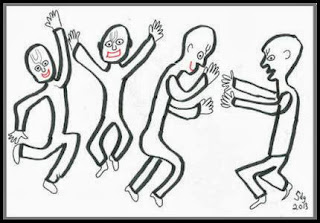
“Today’s drawing shows four bhaktasdancing and chanting
with upraised arms.
I drew with only a black pen
as a variety from the
multicolored sports clothes.
They are just as happy
as the colorful version
and vigorously dancing.
These men of mine compensate
for the fact that I no longer
can go out and
dance and chant. I
advocate that those
devotees who are fit and healthy should
go out in public and
chant and dance.
My disciple Krishna-kripa
always dances on harinama
because I asked him
to do it. It purifies
the atmosphere and
shows the people that
the Hare Krishna movement is alive and flourishing.”
Morning Pastimes (Pratah-lila) 6:00–8:36 A.M.
with enticing aromas for the pleasure of Krishna,
Balarama, Nanda and Yasoda.”
used to say the devotees were
not doing ordinary ‘ballroom
dancing.’It is a symptom of
transcendental ecstasy that when one
is chanting in kirtana he
spontaneously rises and starts
to dance. Prabhupada
was very pleased when the
first devotee got up to
dance. Soon we
were all doing it.
He taught us the ‘Swami Step’upstairs
in his room. Later
devotees began improvising
their own
sometimes
wild styles. Prabhupada
usually encouraged all kinds
of dancing because
he saw it as a sign of their enthusiasm.”
“Today’s drawing shows three
devotees dancing and
chanting with upraised arms.
This style of harinama
was introduced by Lord Caitanya
and His associates in
Navadvipa and Jagannatha Puri
over five hundred years ago.
The upraised arms
are a sign of surrender
to Krishna and an expression
of joy. The dancing
feet are a physical
response to an
inner feeling.
These three devotees,
a woman and two
men, are all smiling
out of natural happiness.
It is not a staged or
professional performance but
a pure movement of the soul.”
“Today’s drawing shows four
bhaktas dancing and chanting
with upraised arms.
Four men is a good enough
number to attract the
attention of passersby. They
may be startled or think
them crazy fellows. But
if they continue to pass by
daily they will be impressed by
the determination of the chanters. They may
begin to make out the words
of the mantra and even
find themselves repeating
it during the day.
A steadily appearing
harinama group
has the potency to
transform people’s
lives. It is pleasing
to guru and Gauranga,
and it certainly
purifies the hearts of the chanters.”
Yogesvara Prabhu:
Travel Journal#9.19: New York City Harinamas
→ Travel Adventures of a Krishna Monk
By Krishna-kripa das
(October 2013, part one)
(Sent from New York City on October 22, 2013)
Perhaps 6 or 7 people in our group do not do any other Hare Krishna practice. They are local people who have just become attached to regularly taking part in the sankirtana in Union Square by playing instruments, clapping, dancing, and/or sometimes chanting.
In the spiritual world, which anyone can attain by pure chanting of the holy name of the Lord, all the residents have transcendental bodies like Krishna’s which are not subjected to aging, and it was wonderful to be reminded of that truth by seeing the shop sign.
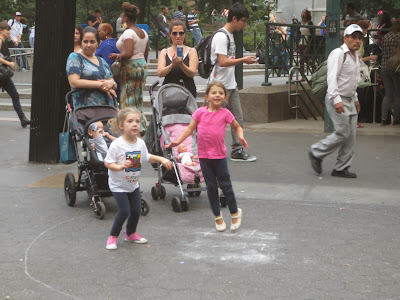
And adults would clap.
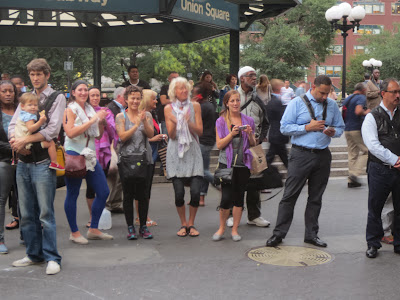
Guys often like to play the djembe, the one-headed African drum.
One man likes to drum with drum sticks on an inverted bucket.
and makes a drawing of our party.
Here is some video of it (http://www.youtube.com/playlist?list=PLGerEnGdI0xKmoh9hN8UzWNXBHmFnkT97):
How about a guy in purple underwear?
We chanted as we circumambulated the park’s famous Hare Krishna tree, and then sat down and talked about spreading the chanting of the holy name and Srila Prabhupada’s mission.
That crown jewel among all Vraja gopis
Her lotus feet’s sheer splendor and majesty
is supremely dear to You
even greater than millions upon millions of hearts
full of the most unique fresh new rasa—
I beg this of You with all my heart and soul!”
on He who wears the peacock-feather crown
incessantly singing
His nama-sankirtana [congregational chanting of His name]
worshipfully serving
His lotus feet
chanting quietly
His best of mantras . . .
holding in my heart only the supremely cherished
eternal service to the lotus feet of Sri Radha.
will I become a participant
in Their extremely astonishing festival of divine love?”
“Today’s drawing shows four bhaktas dancing and chanting
Where are they located?
Are they with Rama-raya’s harinama party in Union Square?
Are they at the campus of
the University of Florida in Gainesville?
Are they in some remote
countryside with no one in sight?
Use your imagination
and place them where you will.
It’s bound to be auspicious
wherever Hare Krishna is sung.”
Travel Journal#9.18: North Florida and Ohio
→ Travel Adventures of a Krishna Monk
By Krishna-kripa das
(September 2013, part two)
(Sent from New York City on October 10, 2013)
Insights
from a letter to Bhaktin Amy:
bhaktas dancing and
chanting with upraised arms.
Two are facing forward,
and two move to the side.
Mundane dancers can’t
feel the happiness
these men experience. They
are beyond the modes
of nature. It’s a liberated
dance done in love of Krishna.”
Travel Journal#9.17: Dublin, Philly, and North Florida
→ Travel Adventures of a Krishna Monk
By Krishna-kripa das
(September 2013, part one)
(Sent from Gainesville, Florida, on September 25, 2013)
To see the approximately 150 pictures which I did not include in this blog, click on the link below:
https://picasaweb.google.com/103872792410945983719/TravelJournal917?authkey=Gv1sRgCOTswPOvs-DkDw
October 1–November 24: Union Square harinama, New York City
February 20: Orlando, Philadelphia
February 25–April 20, 2014: Mayapur
For some really professional photos of the Dublin Ratha–yatra, visit this website: http://rathayatra.ie/photo-video-gallery/dublin-2013
This semester managed by Ananta Prabhu, who is playing harmonium in the video clip below, is in charge of the program.
One guy named Sam, who had graduated recently, told how he loved the Krishna Lunch when he was going to school. Both days he came by my table, and while I talked with him, he encouraged people to take the cookies and invitations to the lunch program.
Amrita Keli dd put a video of it on Facebook, https://www.facebook.com/photo.php?v=10104096048148491&set=vb.2040949&type=2&theater, which is better than the copy below I put on YouTube:
Tulasirani and Hladini Dasi made tasty and sufficientprasadam for all. The students were so fired up a group of them started their own kirtana after the prasadam.
Such enthusiasm was beautiful to see! All the devotees who are involved with the club are youthful, enthusiastic, and friendly, and people are easily attracted.
harinama process
is the easiest, fastest
and surest way
to attain love of God.”
Travel Journal#9.16: Czech Woodstock, Prague, Berlin, and The North of England
→ Travel Adventures of a Krishna Monk
By Krishna-kripa das
(August 2013, part two)
(Sent from Gainesville, Florida, on September 5, 2013)
Thanks to Tobi for the Berlin pictures and Klara for the Prague pictures. To see the over 400 pictures I did not include in this blog, click on the URL below:
https://picasaweb.google.com/103872792410945983719/TravelJournal916
It was amazing to see one guy who was wearing a “Dead Kennedys” shirt chant continuously for two hours.
We do not have security persons to keep people off our stage, so sometime people from the crowd become inspired to join us on our stage during our chanting like the girl next to the mantra sign below. She was a regular who chanted every day.
One man came in our tent, and began dancing, leaving his little girl sitting on the bench.
Our leader said we passed out more invitations than ever before, although we gave them only to people who showed some signs of interest. A couple of Muslim girls Jagatatma Prabhu gave cards to, chanted the mantra and followed us for a few minutes, a rarity. A few people danced with us, like the ones below.
“Where am I doing?” and “What am I doing?” While we were sleeping, he was writing.
I met the leaders of the counterculture but none were so personally compassionate to me as Srila Prabhupada.
Travel Journal#9.15: Polish Woodstock, Harinamas in Germany and Bratislava
→ Travel Adventures of a Krishna Monk
By Krishna-kripa das
(August 2013, part one)
(Sent from Newcastle upon Tyne on August 26, 2013)
from Letter of 2 August 1972:
“So preach like that, very simply, and hold sankirtana all over the city, and distribute prasadam profusely, especially to the youth, then everything will be successful.”
from 73/08/26 London, lecture on Bhagavad-gita 2.21–22:
“But if you engage yourself in the service of Krishna, you’ll find new and new encouragement. That is spiritual. If you find it hackneyed, then you must know that you are not yet serving spiritually, you are serving materially. Formality, stereotype. But if you feel new and new energy, then you know that you are serving spiritually. This is the test. Your enthusiasm will increase, not decrease.
I had little Jagannathas, and he
wrote back that Jagannatha is neither big or small.”
Travel Journal#9.14: Plymouth Ratha-yatra, Baltic Summer Festival, Sri Harinama Temple
→ Travel Adventures of a Krishna Monk
By Krishna-kripa das
(July 2013, part two)
(Sent from Trutnov, Czech Republic, on August 16, 2013)
Thanks to Manorama Prabhu for the photo of the Plymouth bhajanas. Thanks to Rukmini for the picture of Ananda Seva Prabhu and I in Soho Square and thanks to the devotees who took pictures of me at the Baltic Summer festival, namely, Mathura Lilapriya dd, Ruslan Golubev, and Vladimiras Maksimkinas. Thanks to Patrycja Siva for the pictures of Bialystok, and the Sri Harinam Mandir Traveling Temple for their picture and video of our harinama in Warsaw.
Another group of ladies also enjoyed dancing in a circle with the devotees.
After the Ratha-yatra, there was a drama and a bharat-natyam dance, and a short final kirtana.
I felt the program, which ended by 4 p.m., was much too short. I am accustomed to New York City, where the post-Ratha-yatra festival goes to 7 p.m. In London, it is also short, ending at 5 p.m. but this was even shorter. Still a lot of mercy was flowing, and I was glad that my friends and I got to go.
At the festival, I met Yajna Purusa Prabhu (in white below), an Indradyumna Swami disciple from Lithuania I knew from Rupanuga Vedic College when I was there about ten years ago. We enjoyed dancing in the kirtana together.
At one point a group of people was watching us and taking pictures.
The devotees took a video of our Warsaw harinama (http://www.youtube.com/watch?v=3jOPA5uj3Yg&feature=share&list=UUu2zlFjbb8HMP9MhounuI_g):
The last day we drove to Krakow, but we left late and the devotees stopped to go swimming, so we did not get there until 6:00 p.m. I had booked a train to go to the Woodstock for 6:30 p.m., thinking that we would chant no later than from 3 to 6 p.m. in Krakow, so I missed the harinama altogether. It would have been better if I did harinama in Warsaw with Krishna-kirtana Prabhu and any other devotees we could find, and taken a train from there.
from The Nectar of Devotion, Chapter 36:
worship is for neophytes
and sometimes he says it is essential. It is essential to me
to fix my mind on Radha and Krishna. Prabhupada says
the Deities are nondifferent from the original Lord.
I worship Them
in faith and pleasure
drinking in Their nectarean darsana.
The madhurya rasa They represent
is the highest thing there
is, and I want it in my life.
I’m grateful They
accept my simple incense
and reside with me in my bhajana-kutira.
Niranjana Swami:
Travel Journal#9.13: The North of England
→ Travel Adventures of a Krishna Monk
By Krishna-kripa das
(July 2013, part one)
(Sent from Bratislava, Slovakia, on August 11, 2013)
Aside from the beaches in Florida and Poland, I rarely do harinama on the beaches, but the weather was so excellent, a rarity in The North of England, that Lauris and Malvika suggested that we chant at the Roker Beach in Sunderland. Diya decided to join us, even though she is a little shy to chant in her hometown, and we were very happy she came.
from Srimad-Bhagavatam 6.4.27–28, purport:
“When a devotee is eager to see the Supreme Personality of Godhead, he prays to the Lord:
‘O son of Maharaja Nanda [Krishna], I am Your eternal servitor, yet somehow or other I have fallen into the ocean of birth and death. Please pick me up from this ocean of death and place me as one of the atoms at Your lotus feet.’ Being pleased with the devotee, the Lord turns all his material impediments into spiritual service.”
worried that my poem to Radha-Govinda
is repetitious.
Pujari service is the same, but there is always
variety of dresses, ornaments,
flowers andprasadam.
Even the sameness
is a steadying influence
as we get to know
Them better every day. In
the spiritual world
Radha and Krishna play the same sports
in Their asta-kaliya
lila throughout the hours of the day and night.
But there are always newer and ever-fresh rasas as experienced by Them.
I don’t want any extraordinary change.
I just want to see Them as
They are. As I grow in devotion,
the change will take place in my heart.
a submissive
hearer of Srimad-Bhagavatam and pass his
days in enlightened hearing.
yac-chaktayo vadatam vadinam vai
Travel Journal#9.12: More English Adventures
→ Travel Adventures of a Krishna Monk
By Krishna-kripa das
(June 2013, part two)
(Sent from Erfurt, Germany, on August 6, 2013)
Vidyapati Prabhu shared some video of the midnight Ratha-yatra this year (http://www.youtube.com/watch?v=ZGgp5vfimrQ&feature=share&list=UU14VMd3QqNZb10NSE2gVwGA):
Saksi Gopala Prabhu, and Vidyapati Prabhus were very lively kirtana leaders. Devotees said that more people followed our chanting party than in other years. I was so happy to see the many people smiling, dancing, and even chanting along with us.
Some stayed for hours. Some said they chanted with us at the Stonehenge every year. Once a lady held the mike of her personal amplifier to the mouth of Mahavishnu Swami so more people could hear.
Different dignitaries spoke at the beginning of it, and I noted some things they said. The only Hindu chaplin for UK prisons begged us for Bhagavad-gitas for the prisons. A leader of Hindu youth said he came for thirteen times and he felt Krishna was present. He said that the Hindu population of prisons is the lowest of any group, and activities like our kirtana program are beneficial for the youth.
I do not dance that hard any more. Some of my friends from Sheffield also danced with my Newcastle friends.
Parasurama Prabhu wanted me to get a bunch of people to dance during his singing slot, and I told my Newcastle friends, and he was pleased with their performance.
Travel Journal#9.11: Adventures in England
→ Travel Adventures of a Krishna Monk
By Krishna-kripa das
(June 2013, part one)
(Sent from Newcastle upon Tyne, England, on July 8, 2013)
a few danced, like this boy and his mom below,
and some even chanted with us. Some, like the couple below, joined the procession to the park where we chanted for another half hour and had prasadam.
London Saturday Night Harinamas
Later Satya Medha’s little boy, Bhanu, was inspired by the others to begin playing on his little drum.
The weather was unusually good for Newcastle, sunny and not too cool, so for the last two hours we sang in the park across the street from the temple.
A group of boys, and later, a lady danced with us. I took some great pictures of the boys dancing, but they wanted me to delete the pictures from my camera while they watched, perhaps afraid that their parents or friends might see them. I did so, but was amazed by such fear among boys perhaps ten or twelve years old. The devotees enthusiastically cooked some great Ekadasi prasadam for the event as you can see below:
Insights
Travel Journal#9.11: Adventures in England
→ Travel Adventures of a Krishna Monk
By Krishna-kripa das
(June 2013, part one)
(Sent from Newcastle upon Tyne, England, on July 8, 2013)
a few danced, like this boy and his mom below,
and some even chanted with us. Some, like the couple below, joined the procession to the park where we chanted for another half hour and had prasadam.
London Saturday Night Harinamas
Later Satya Medha’s little boy, Bhanu, was inspired by the others to begin playing on his little drum.
The weather was unusually good for Newcastle, sunny and not too cool, so for the last two hours we sang in the park across the street from the temple.
A group of boys, and later, a lady danced with us. I took some great pictures of the boys dancing, but they wanted me to delete the pictures from my camera while they watched, perhaps afraid that their parents or friends might see them. I did so, but was amazed by such fear among boys perhaps ten or twelve years old. The devotees enthusiastically cooked some great Ekadasi prasadam for the event as you can see below:
Insights
Travel Journal#9.10: Ireland, The North of England, London
→ Travel Adventures of a Krishna Monk
By Krishna-kripa das
(May 2013, part two)
(Sent from Newcastle upon Tyne on June 25, 2013)
I share many quotes from writings of Srila Prabhupada and some excerpts from the unpublished second volume of The Story of My Life, the autobiography of Satsvarupa Dasa Goswami.
“
There were lots of people on the street. An elderly gentleman came to give a donation [as we were walking to our harinama site], and then Krishna-kripa Prabhu approached him to give a book. He said with a smile: ‘For many, many years I have seen the Hare Krishna people on the street. It’s really nice to see you all again.’“
Later on a lady stopped by and mentioned about George Harrison. It’s really great to see how so many people appreciate the harinama.“
After a while a group of [four] teenagers [who had walked past previously] came and stood nearby. They were listening to harinama.Then they started swinging gently with the beautiful tune of maha-mantraand gradually started dancing. They kept on dancing and smiling. It looked so natural for them. Krishna-kripa Prabhu took out few leaflets of maha-mantrafrom his bag and gave them to the teenagers [pointing out to them the words to the song].“Now each of them was holding the maha-mantrain her hand, and they started reading word for word and singing to it. Practically each of them was singing as they were reading out the maha-mantra.
“It was a wonderful scene—suddenly so many voices singing maha-mantra,the people on the street were amazed to see this.
“
After the harinamaKrishna-kripa Prabhu was preaching to the group of young peopleand invited them to come to temple programs.
“
As they were leaving they looked so bright, happy and blissful.”
Seeing the beauty of the gardens, the waterfall, and the birds, you could get a clue why he might have said that.
Travel Journal#9.10: Ireland, The North of England, London
→ Travel Adventures of a Krishna Monk
By Krishna-kripa das
(May 2013, part two)
(Sent from Newcastle upon Tyne on June 25, 2013)
I share many quotes from writings of Srila Prabhupada and some excerpts from the unpublished second volume of The Story of My Life, the autobiography of Satsvarupa Dasa Goswami.
“
There were lots of people on the street. An elderly gentleman came to give a donation [as we were walking to our harinama site], and then Krishna-kripa Prabhu approached him to give a book. He said with a smile: ‘For many, many years I have seen the Hare Krishna people on the street. It’s really nice to see you all again.’“
Later on a lady stopped by and mentioned about George Harrison. It’s really great to see how so many people appreciate the harinama.“
After a while a group of [four] teenagers [who had walked past previously] came and stood nearby. They were listening to harinama.Then they started swinging gently with the beautiful tune of maha-mantraand gradually started dancing. They kept on dancing and smiling. It looked so natural for them. Krishna-kripa Prabhu took out few leaflets of maha-mantrafrom his bag and gave them to the teenagers [pointing out to them the words to the song].“Now each of them was holding the maha-mantrain her hand, and they started reading word for word and singing to it. Practically each of them was singing as they were reading out the maha-mantra.
“It was a wonderful scene—suddenly so many voices singing maha-mantra,the people on the street were amazed to see this.
“
After the harinamaKrishna-kripa Prabhu was preaching to the group of young peopleand invited them to come to temple programs.
“
As they were leaving they looked so bright, happy and blissful.”
Seeing the beauty of the gardens, the waterfall, and the birds, you could get a clue why he might have said that.
Travel Journal#9.9: Holland, London, The North of England, Northern Ireland
→ Travel Adventures of a Krishna Monk
By Krishna-kripa das
(May 2013, part one)
The man also knew of Inis Rath island and their Sunday feast, and the lady in the office lived in Dunmurry, the Belfast suburb where our temple is, and she knew of our Sunday program there.
Travel Journal#9.9: Holland, London, The North of England, Northern Ireland
→ Travel Adventures of a Krishna Monk
By Krishna-kripa das
(May 2013, part one)
The man also knew of Inis Rath island and their Sunday feast, and the lady in the office lived in Dunmurry, the Belfast suburb where our temple is, and she knew of our Sunday program there.
Travel Journal#9.8: New York, London, Amsterdam, and More
→ Travel Adventures of a Krishna Monk
By Krishna-kripa das
(April 2013, part two)
(Sent from Newcastle upon Tyne, England, on May 28, 2013)
to chant sixteen rounds is the most essential,’ wrote
Prabhupada. We have taken a solemn
vow at the time of our initiation. We
learn to chant avoiding the ten offenses
and then the whole panorama of Krishna’s fame,
qualities, pastimes and Krishna Himself
is revealed to us. Who is such a fool
that he will not take to the chanting
and hearing of the holy names?”
the others for lunch today.
Eating alone is good as
occasional relief. I like
to be with the devotees
even if it causes a
certain strain because
it’s my duty to sit with
them and hear the Bhagavatam
and then personal
conversations. I want
to please and serve
them by my presence.”
I discovered
that Srila Prabhupada was a perfect psychologist.
He assured us that we were fortunate and happy.
We have given up sinful life and
attained Krishna consciousness
so no one should be despondent.
But Prabhupada also made it clear
we are not Vaisnavas
but servants of the Vaisnavas.
A pure devotee is very rare.
He was expert and did it subtly
so no one noticed how—
giving us confidence and humility at the same time.
And what he gave we accepted.”
Travel Journal#9.8: New York, London, Amsterdam, and More
→ Travel Adventures of a Krishna Monk
By Krishna-kripa das
(April 2013, part two)
(Sent from Newcastle upon Tyne, England, on May 28, 2013)
to chant sixteen rounds is the most essential,’ wrote
Prabhupada. We have taken a solemn
vow at the time of our initiation. We
learn to chant avoiding the ten offenses
and then the whole panorama of Krishna’s fame,
qualities, pastimes and Krishna Himself
is revealed to us. Who is such a fool
that he will not take to the chanting
and hearing of the holy names?”
the others for lunch today.
Eating alone is good as
occasional relief. I like
to be with the devotees
even if it causes a
certain strain because
it’s my duty to sit with
them and hear the Bhagavatam
and then personal
conversations. I want
to please and serve
them by my presence.”
I discovered
that Srila Prabhupada was a perfect psychologist.
He assured us that we were fortunate and happy.
We have given up sinful life and
attained Krishna consciousness
so no one should be despondent.
But Prabhupada also made it clear
we are not Vaisnavas
but servants of the Vaisnavas.
A pure devotee is very rare.
He was expert and did it subtly
so no one noticed how—
giving us confidence and humility at the same time.
And what he gave we accepted.”
Travel Journal#9.7: North Florida
→ Travel Adventures of a Krishna Monk
By Krishna-kripa das
(April 2013, part one)
(Sent from Dublin, Ireland, on May 17, 2013)
Thanks to Andrea Perez Del Solar, Tulasirani Devi Dasi, Krsodari Devi Dasi, Trevor Manton, Facebook User “Photo Is My Life,” and whoever else I may have missed, for all the photos illustrating this issue
from Sri Caitanya-caritamrita, Adi 17.1, purport:
from Sri Caitanya-caritamrita, Adi 17.28, purport:
from Sri Caitanya-caritamrita, Adi 17.29:
-
My mother is not barren.
-
The king is most pious and compassionate.
-
The queen is most chaste.
nirbandhah krishna-sambandhe
Travel Journal#9.7: North Florida
→ Travel Adventures of a Krishna Monk
By Krishna-kripa das
(April 2013, part one)
(Sent from Dublin, Ireland, on May 17, 2013)
Thanks to Andrea Perez Del Solar, Tulasirani Devi Dasi, Krsodari Devi Dasi, Trevor Manton, Facebook User “Photo Is My Life,” and whoever else I may have missed, for all the photos illustrating this issue
from Sri Caitanya-caritamrita, Adi 17.1, purport:
from Sri Caitanya-caritamrita, Adi 17.28, purport:
from Sri Caitanya-caritamrita, Adi 17.29:
-
My mother is not barren.
-
The king is most pious and compassionate.
-
The queen is most chaste.
nirbandhah krishna-sambandhe
Travel Journal#9.6: North Florida
→ Travel Adventures of a Krishna Monk
By Krishna-kripa das
(March 2013, part two)
(Sent from London, England, on May 7, 2013)
Generally I am not so much into abhisekas,but I must have poured water and other substances over the deities at least seven times, which was completely out of character for me.
It must be the influence of Lord Caitanya Himself and His enthusiastic devotees
.
I also danced while others bathed the deities.
Madhava and Baladeva Prabhus played key roles in organizing and executing the ceremony, and several Krishna House ladies decorated for it. Many thanks to Andrea, who took many beautiful pictures of the event, some of which you see here, and the rest which you can find on Facebook: https://www.facebook.com/media/set/?set=a.10151682144578296.1073741829.513518295&type=3
Purusharta Prabhu and Madhava Prabhu from the Alachua area
from St. Augustine.
A carload of us came from Krishna House in Gainesville to participate. Four of Amrita’s friends from University of North Florida came and stayed for two and a half hours and the president of our Krishna Club there came for an hour or two with a friend. Two friends Amrita made while distributing cookies at the beach also came by.
I danced most of the time and some of the devotees joined me for some of the time.
Some of the students danced, including the girl Amee above, who said the event made her so happppppppy! A few new people came by.
Many, many people took the numerous cookies and invitations we had. It was wonderful to see many people taking a step toward Krishna.
cooperated together to put on the nice event which they hope will become a monthly occurrence there in Jacksonville.
Travel Journal#9.6: North Florida
→ Travel Adventures of a Krishna Monk
By Krishna-kripa das
(March 2013, part two)
(Sent from London, England, on May 7, 2013)
Generally I am not so much into abhisekas,but I must have poured water and other substances over the deities at least seven times, which was completely out of character for me.
It must be the influence of Lord Caitanya Himself and His enthusiastic devotees
.
I also danced while others bathed the deities.
Madhava and Baladeva Prabhus played key roles in organizing and executing the ceremony, and several Krishna House ladies decorated for it. Many thanks to Andrea, who took many beautiful pictures of the event, some of which you see here, and the rest which you can find on Facebook: https://www.facebook.com/media/set/?set=a.10151682144578296.1073741829.513518295&type=3
Purusharta Prabhu and Madhava Prabhu from the Alachua area
from St. Augustine.
A carload of us came from Krishna House in Gainesville to participate. Four of Amrita’s friends from University of North Florida came and stayed for two and a half hours and the president of our Krishna Club there came for an hour or two with a friend. Two friends Amrita made while distributing cookies at the beach also came by.
I danced most of the time and some of the devotees joined me for some of the time.
Some of the students danced, including the girl Amee above, who said the event made her so happppppppy! A few new people came by.
Many, many people took the numerous cookies and invitations we had. It was wonderful to see many people taking a step toward Krishna.
cooperated together to put on the nice event which they hope will become a monthly occurrence there in Jacksonville.
Travel Journal#9.5: North Florida
→ Travel Adventures of a Krishna Monk
By Krishna-kripa das
(March 2013, part one)
(Sent from London, England, on April 28, 2013)
Travel Journal#9.5: North Florida
→ Travel Adventures of a Krishna Monk
By Krishna-kripa das
(March 2013, part one)
(Sent from London, England, on April 28, 2013)
